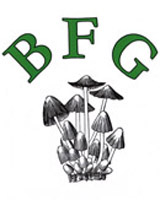I
|
|
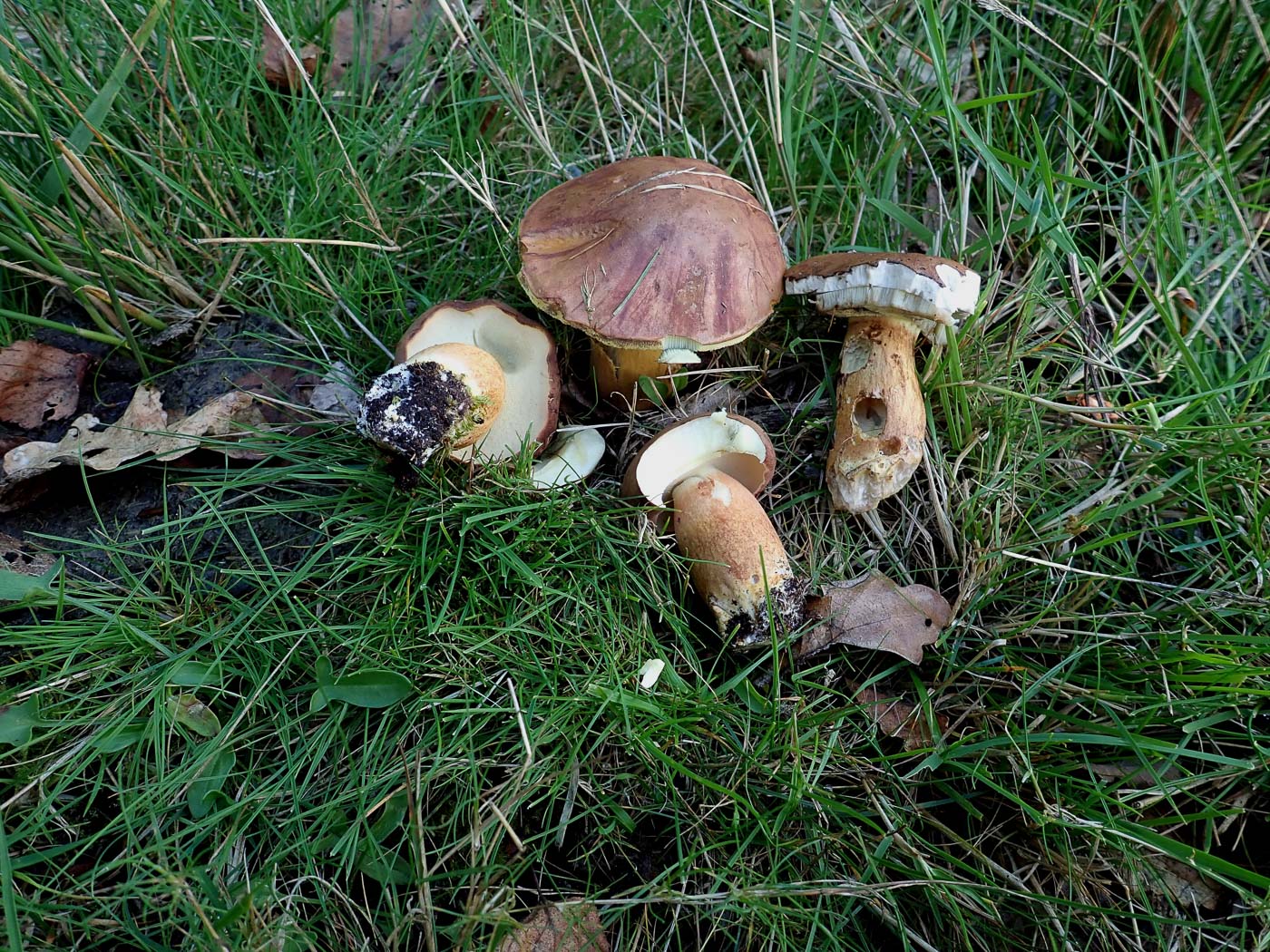
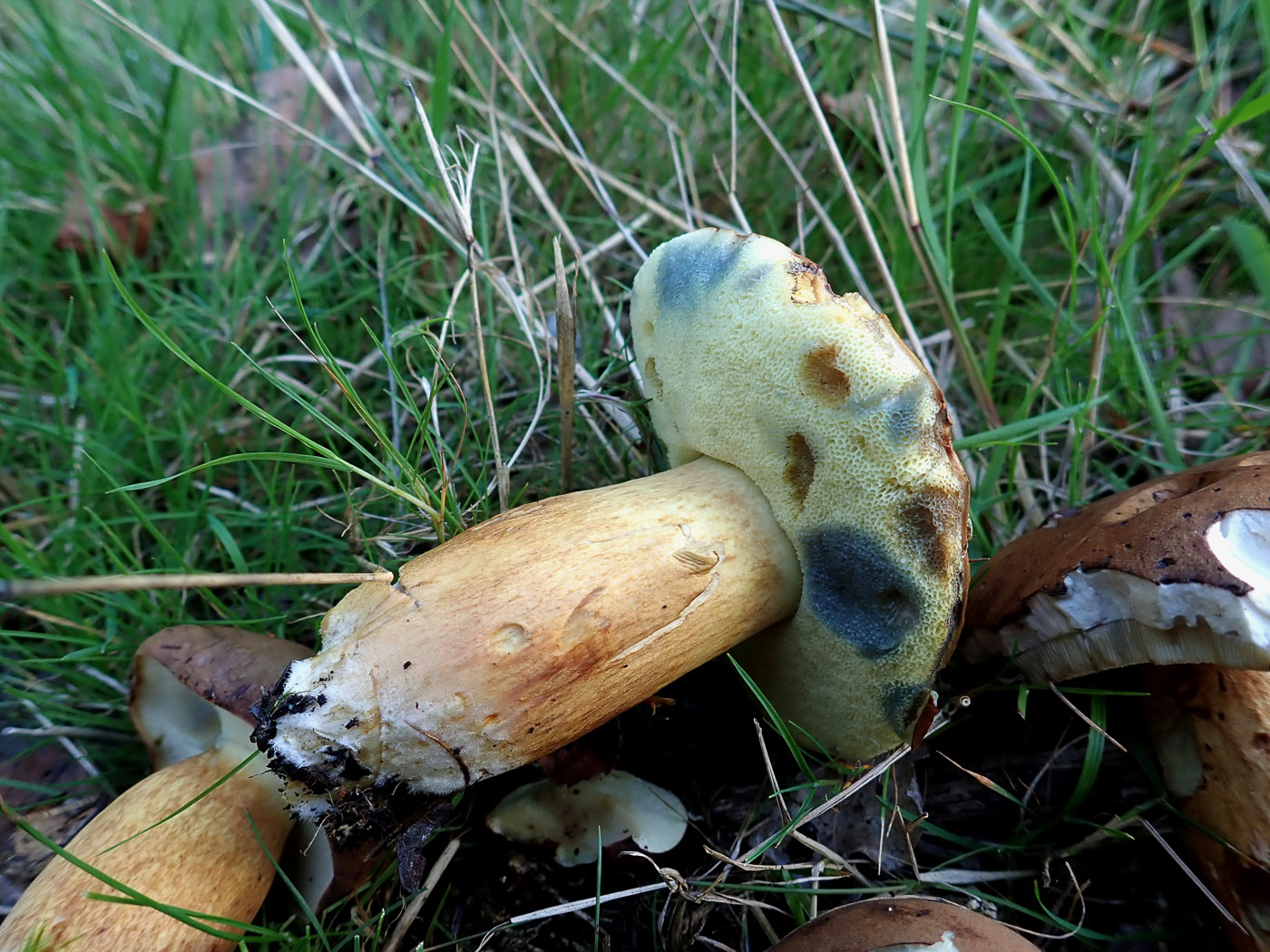
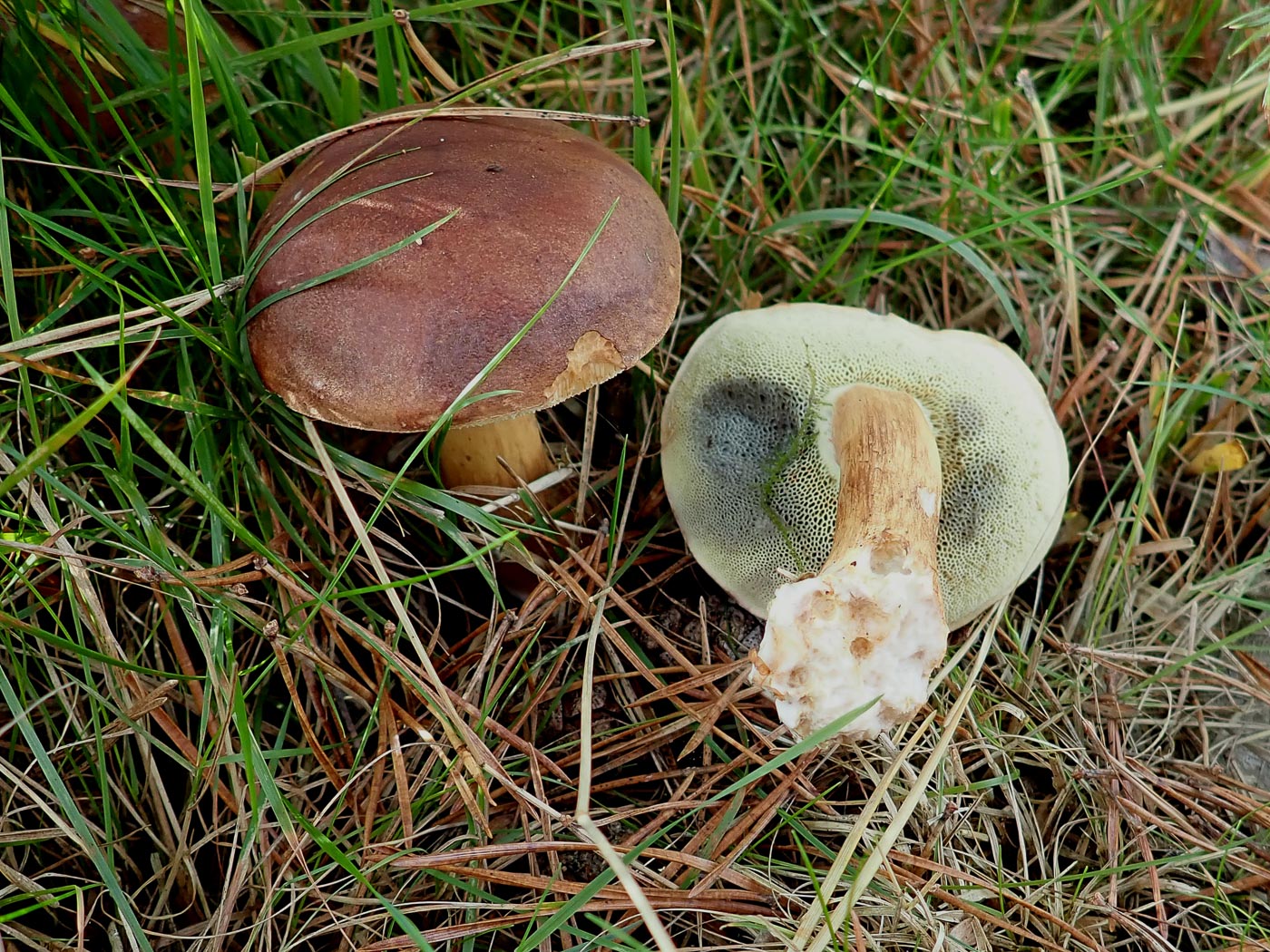
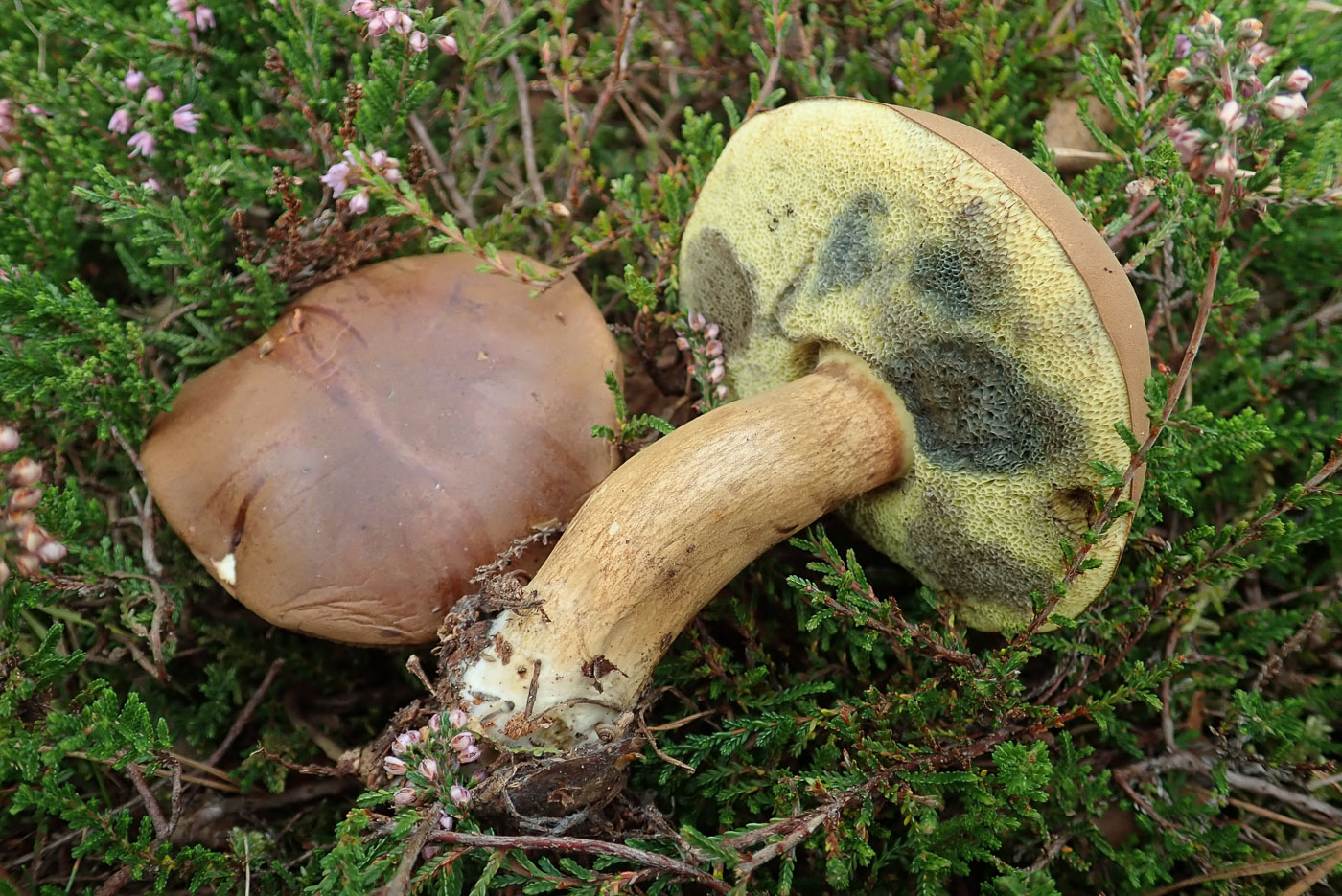
|
Imleria badia (Bay Bolete)
Sep 29, 2022. Under a mix of Pine and Birch at Stoke Common Penny found these few Boletes - the only examples she saw. This is one of the easier Boletes to recognise, having a smooth firm bay brown cap, a stem which is also brown though paler, and pale yellow pores which readily bruise greenish blue (though the younger examples today seemed reluctant to do so). Note how one of the caps is spmewhat nibbled - not surprising as there are so few fungi about for the small mammals to enjoy at the moment.
Oct 27, 2021. Under Pine and Birch at Stoke Common Penny noticed this pair lurking in the vegetation. Better known as Boletus badius, this common Bolete has a bay brown rounded smooth quite shiny cap (slimy in wet weather), the fine pores are a greenish yellow and turn blue quickly when pressed, the flesh is yellow and the stem is also bay brown. It occurs under mixed trees but often where conifers are present.
Sep 15, 2020. More familiar as Boletus badius, this common bolete was found under Birch and Pine at Burnham Beeches by Penny Cullington. It has a smooth brown cap which can be sticky when moist, lemon yellow pores which turn blue instantly when pressed and a cylindrical stem with similar brown colours to the cap. The stem colour and lack of cracking of the cap together with the instant blueing are usually sufficient characters to make an identification in this difficult group of species, many of which appear superficially extremely similar.
|
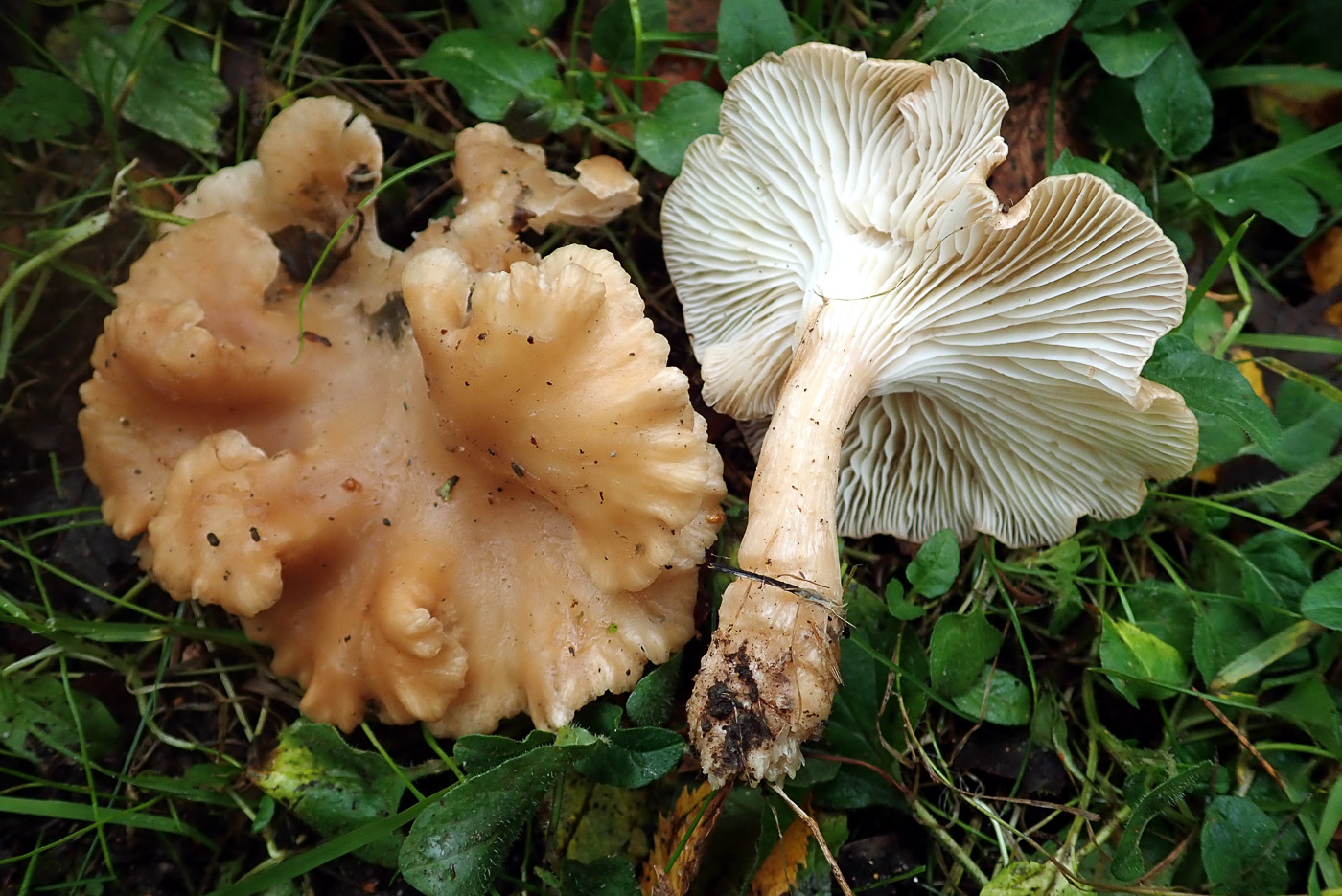 |
Infundibulicybe costata (a Funnel with no common name)
Oct 22, 2020. Penny C. noticed this pair in a grassy path edge in Hodgemoor Woods. Previously in the genus Clitocybe, those species with exceptionally decurrent gills are now moved to this new genus - yet another name change to get used to. This occasional species is similar to the very common I. gibba (see photo dated Sept 02) but is generally rather flabby and with this distinctive irregular undulating to furrowed margin. We have just a handful of county records though it may possibly have been overlooked as I. gibba.
|
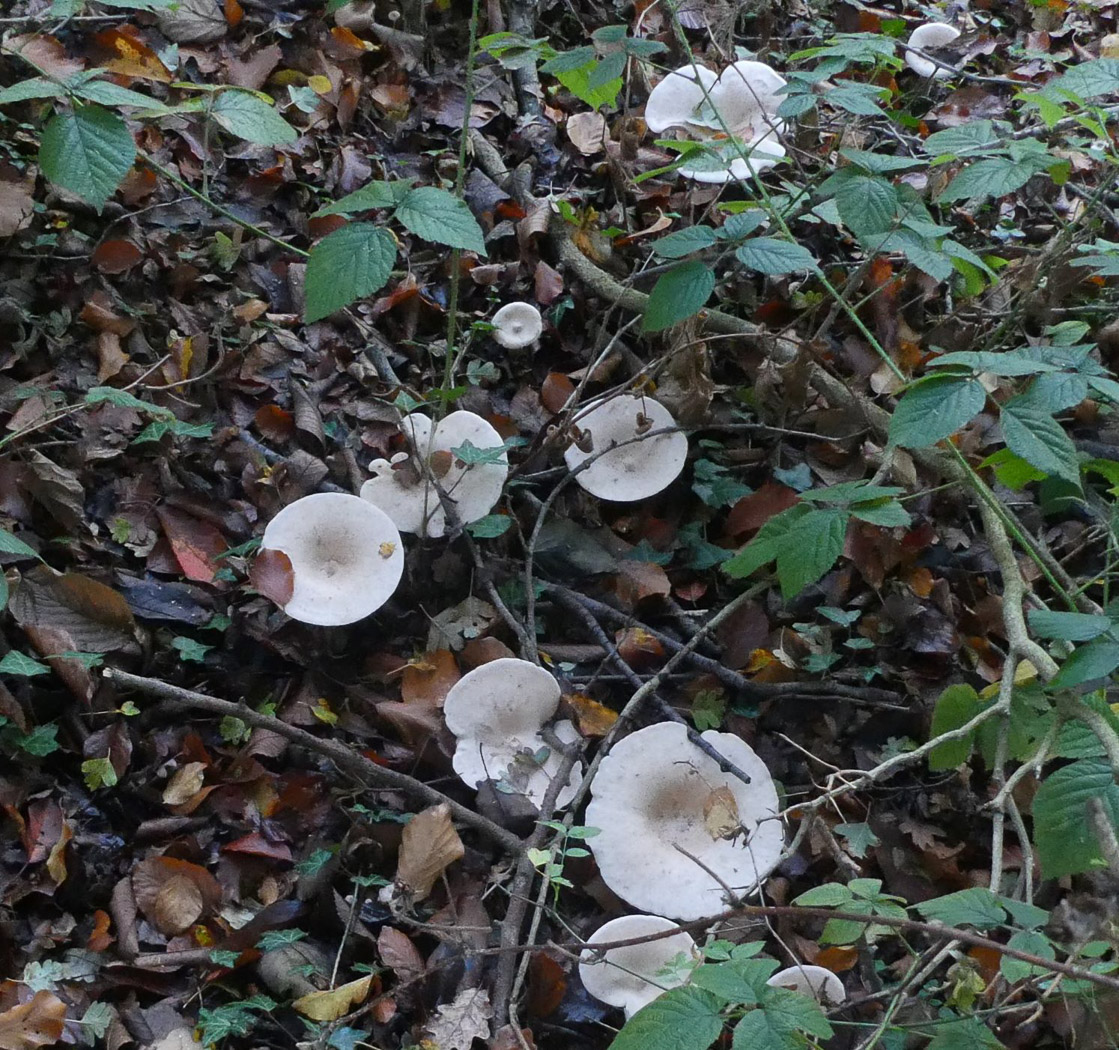
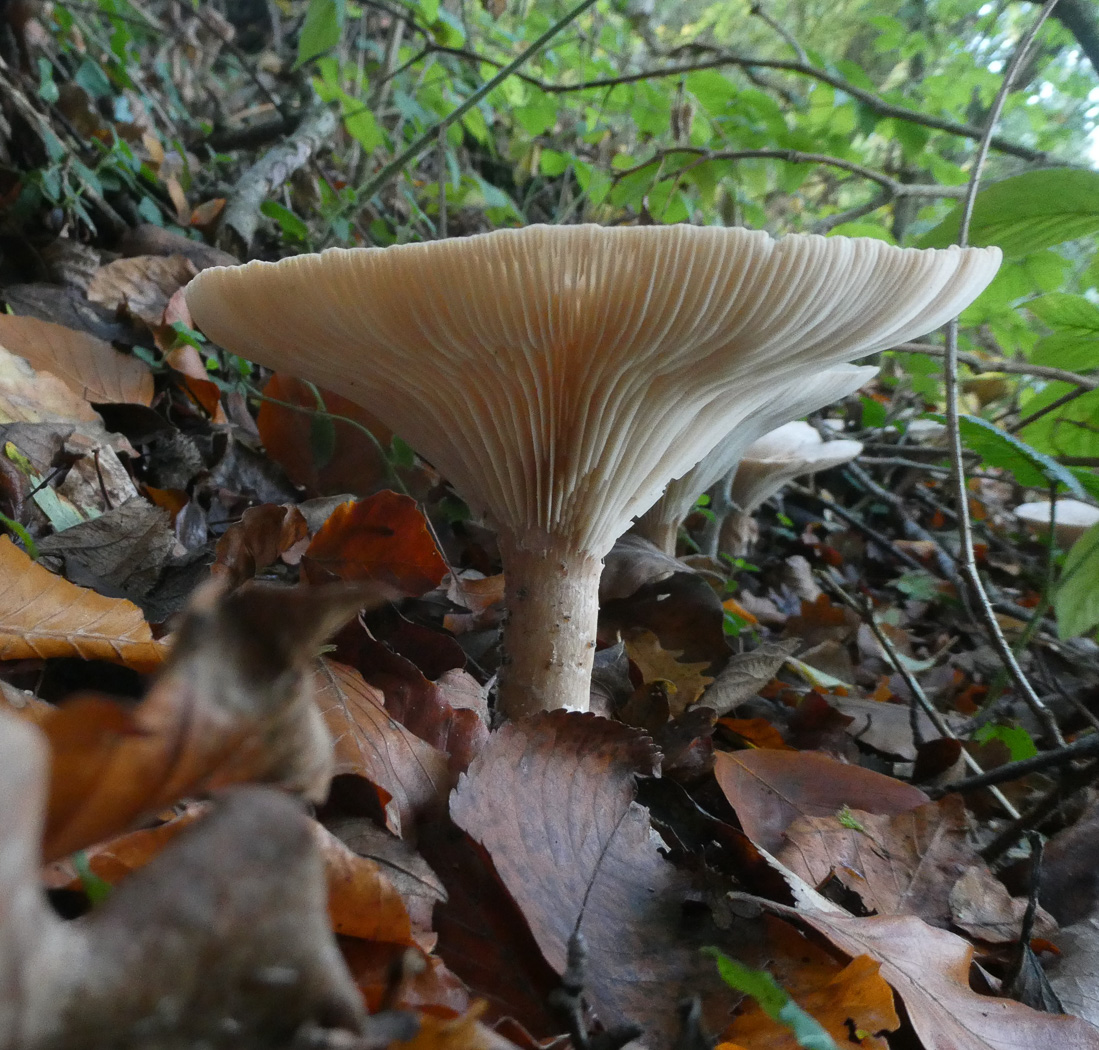
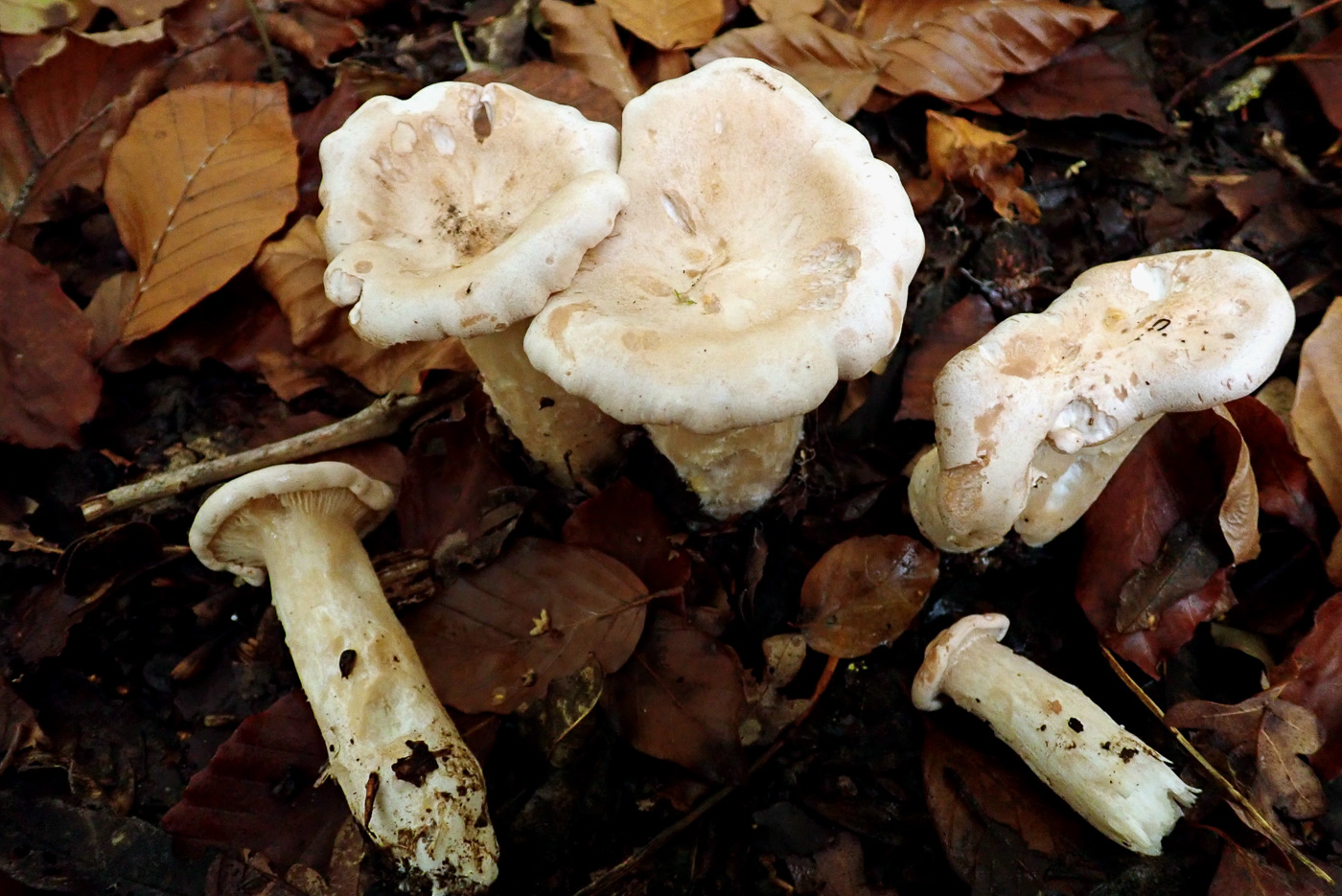
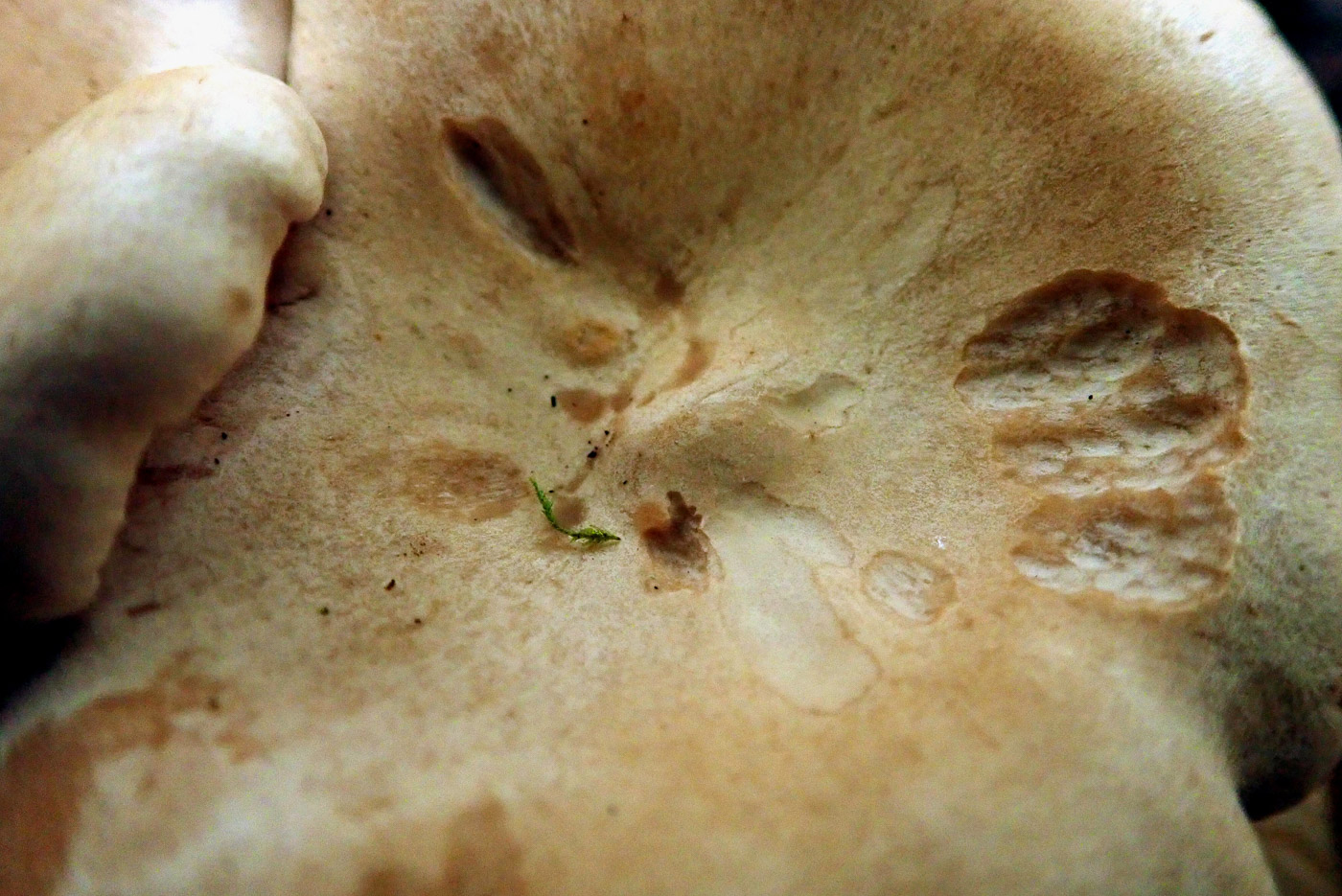
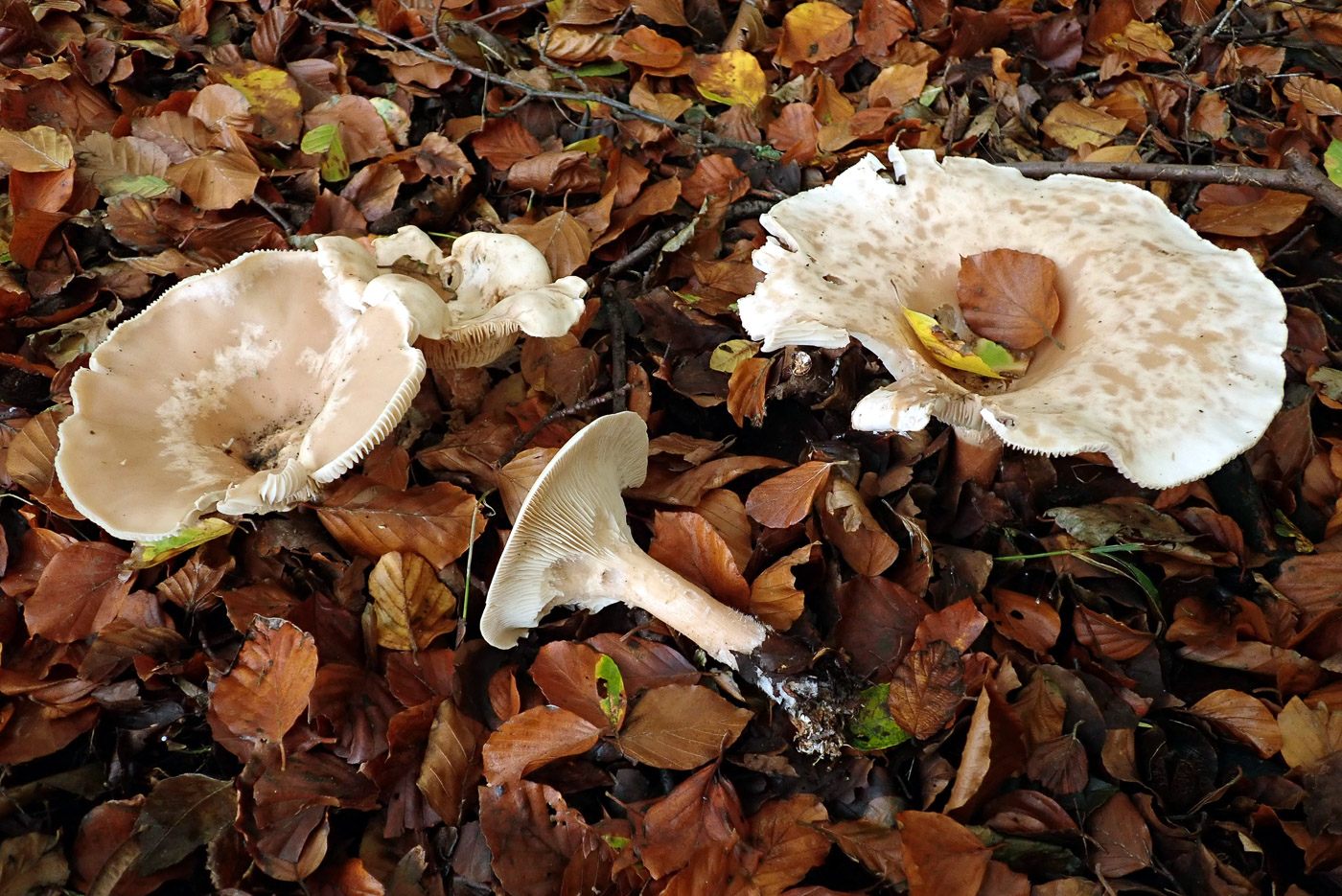
|
Infundibulicybe geotropa (Trooping Funnel)
Oct 31, 2022. Near Chalfont St. Peter at a woodland edge Jim Wills found this group of a normally very common species which seems to have been pretty scarce so far this autumn. It is quite easily mistaken for Clitocybe nebularis (Clouded Agaric) - another large Funnel found in troops, but the small firm 'pompom' in the centre of the cap helps to separate them - present in Trooping Funnel but absent in Clouded Agaric. In photo 1 this can just be seen, particularly in the smallest cap here. Another difference: Clouded Agaric has a notably pleasant fruity smell (to Penny of apricot!). See the Masterlist for images of both these two species for comparison.
Oct 24, 2020. We do have a distant photo of this common species (dated Oct 19) but today's collection of young material, found in Beech litter in Gussetts Wood by Paul C. (photo Penny C.), might help to elucidate. Note the strongly decurrent gills and thick stem which clearly will eventually support a large fruit body, also the fibrillose cap surface which is sunk in the middle but even at this early stage with a bump in the centre. This becomes more prominent as the cap expands and is a feature not found in the similar Clitocybe nebularis which at this stage is grey rather than cream of today's species. When both are fully mature and aging, however, they are extremely difficult to separate! Photo 3, taken a couple of days later in Mousells Wood shows large mature specimens, the cap on the right being 20 cms across.
|
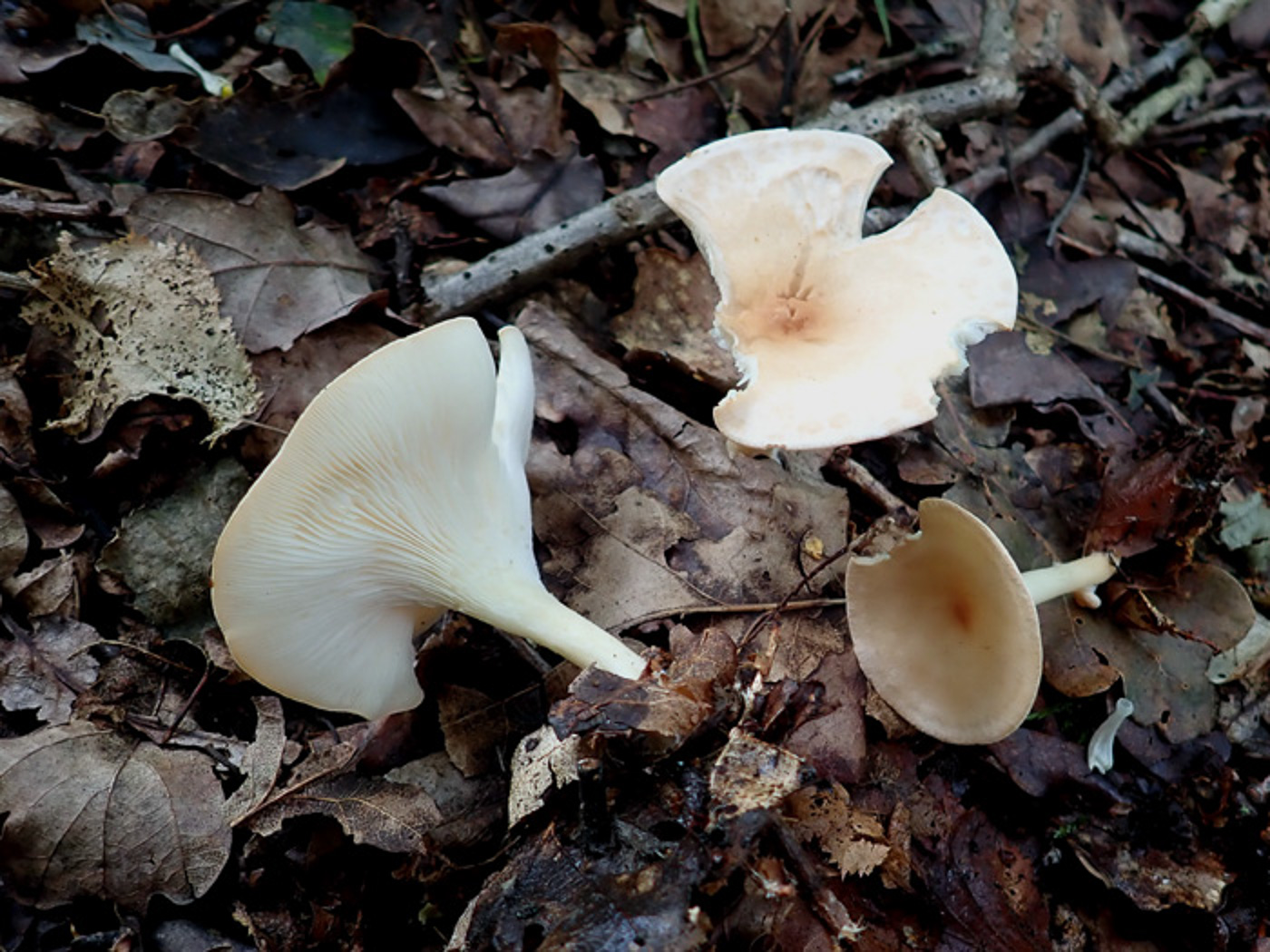
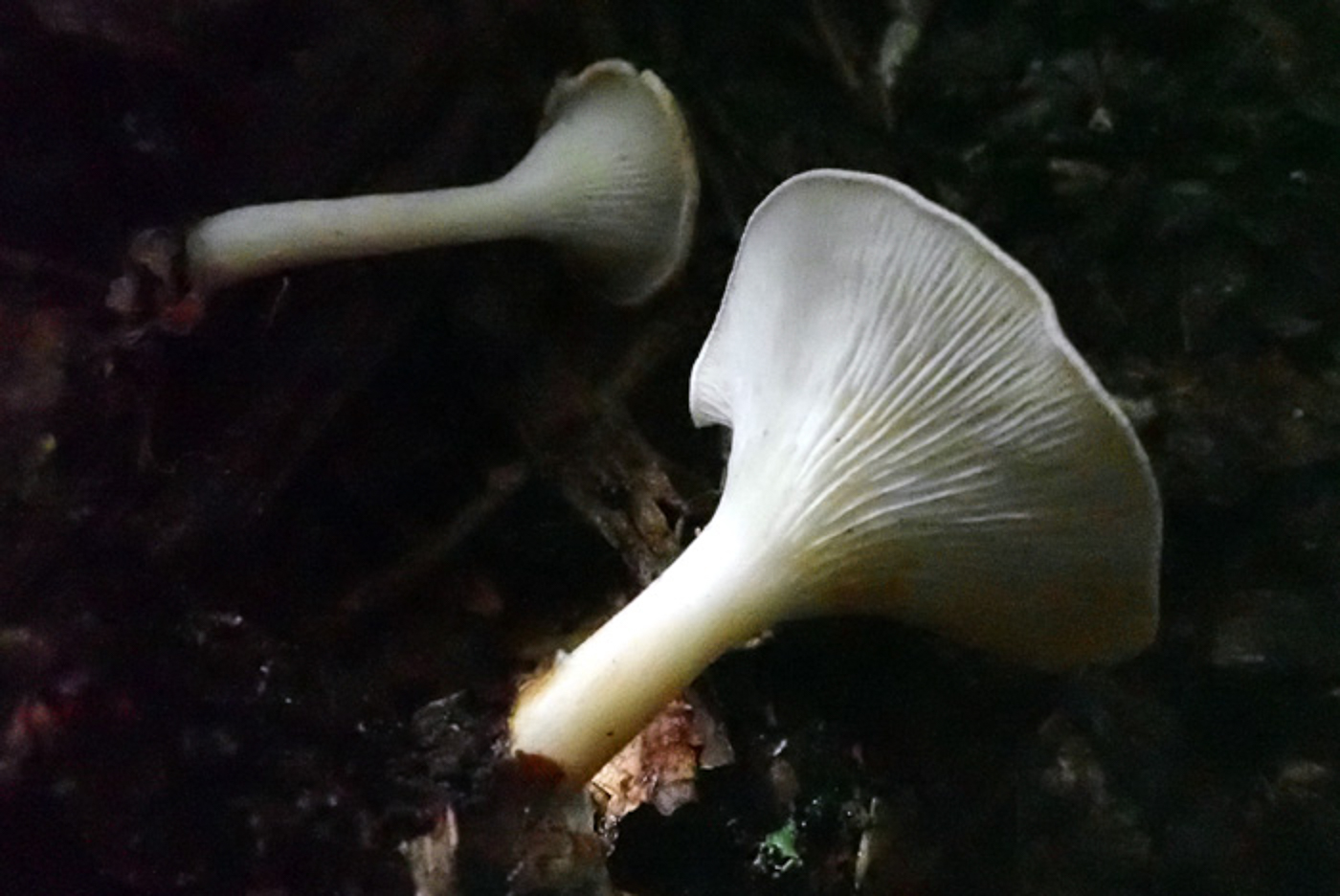
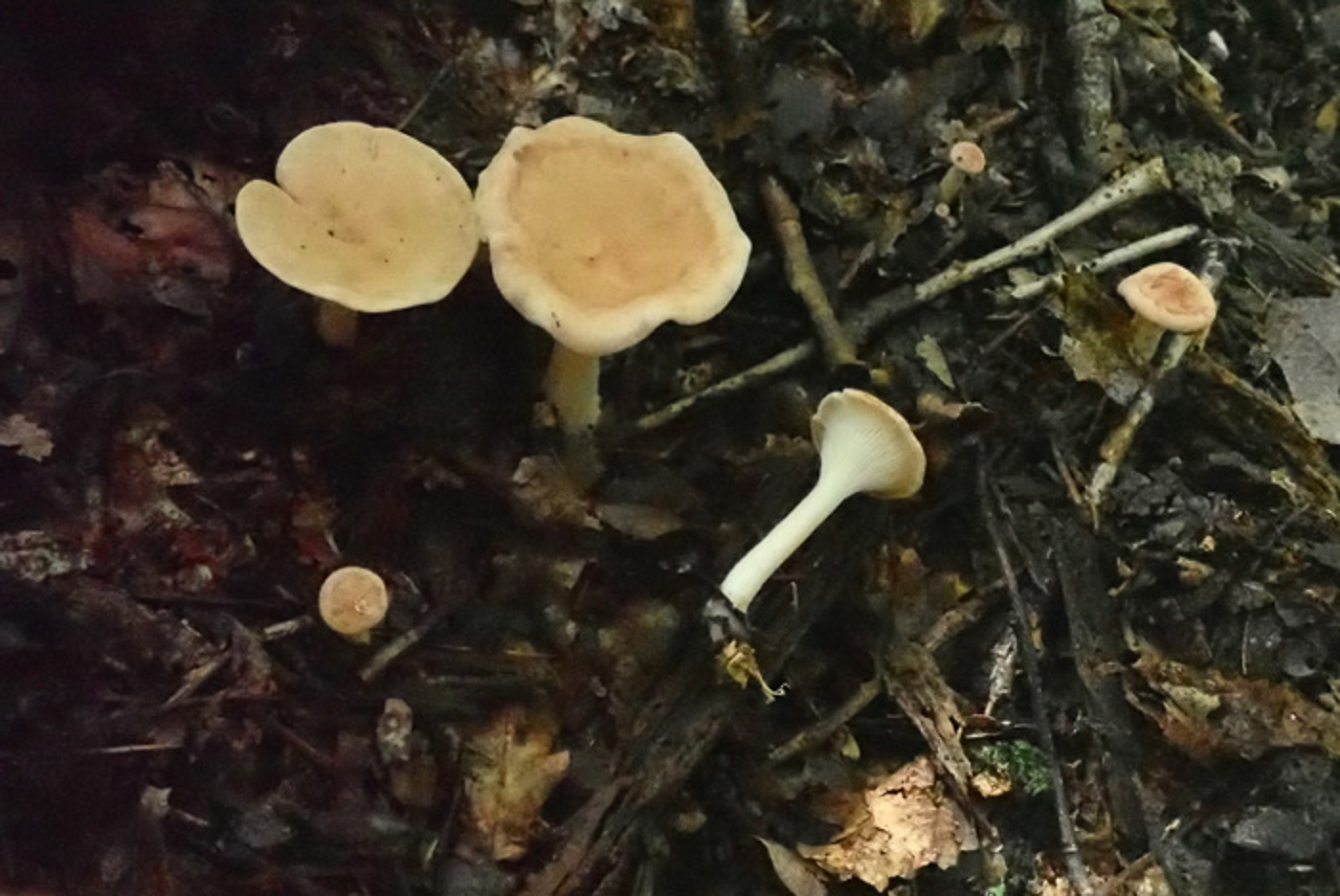
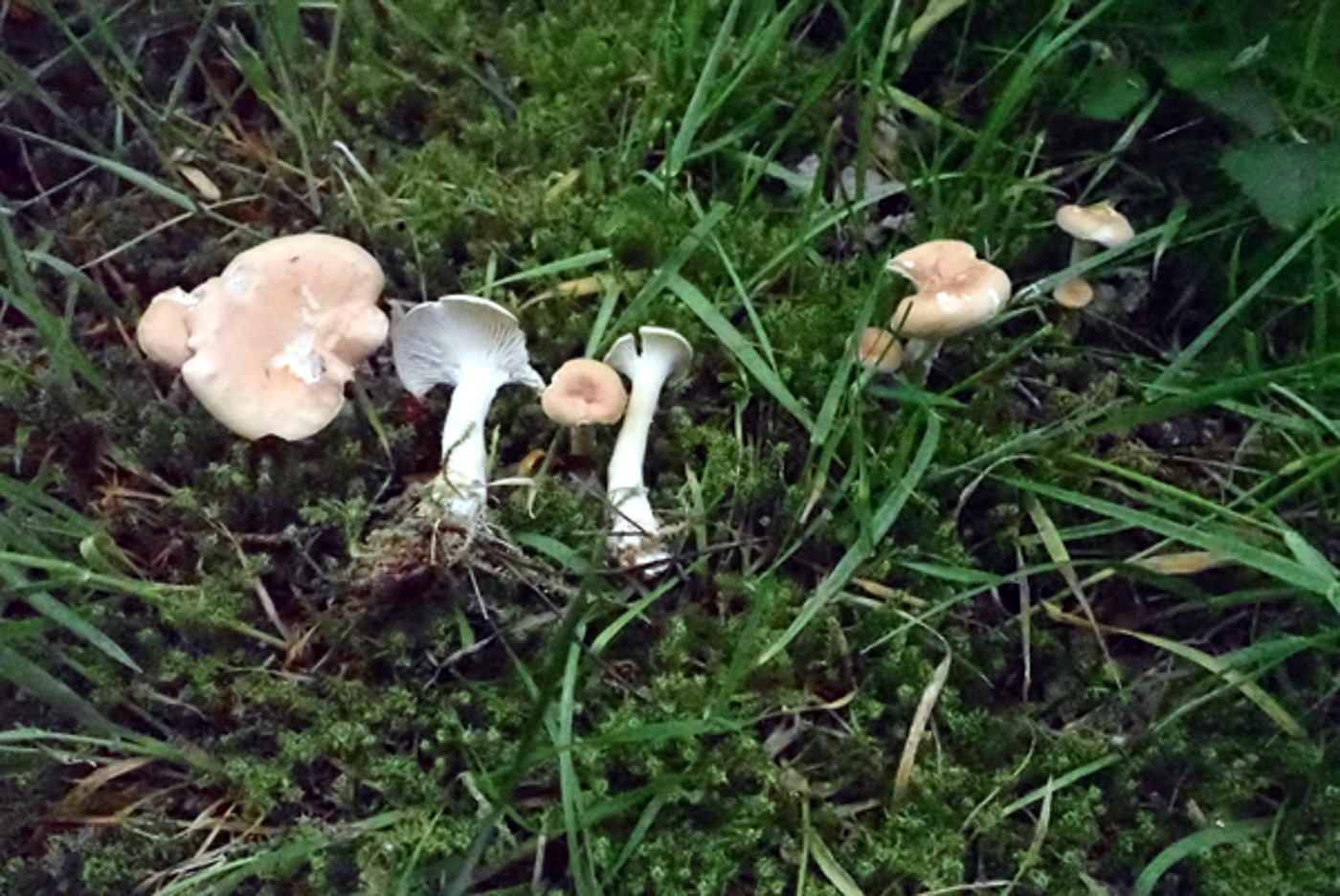
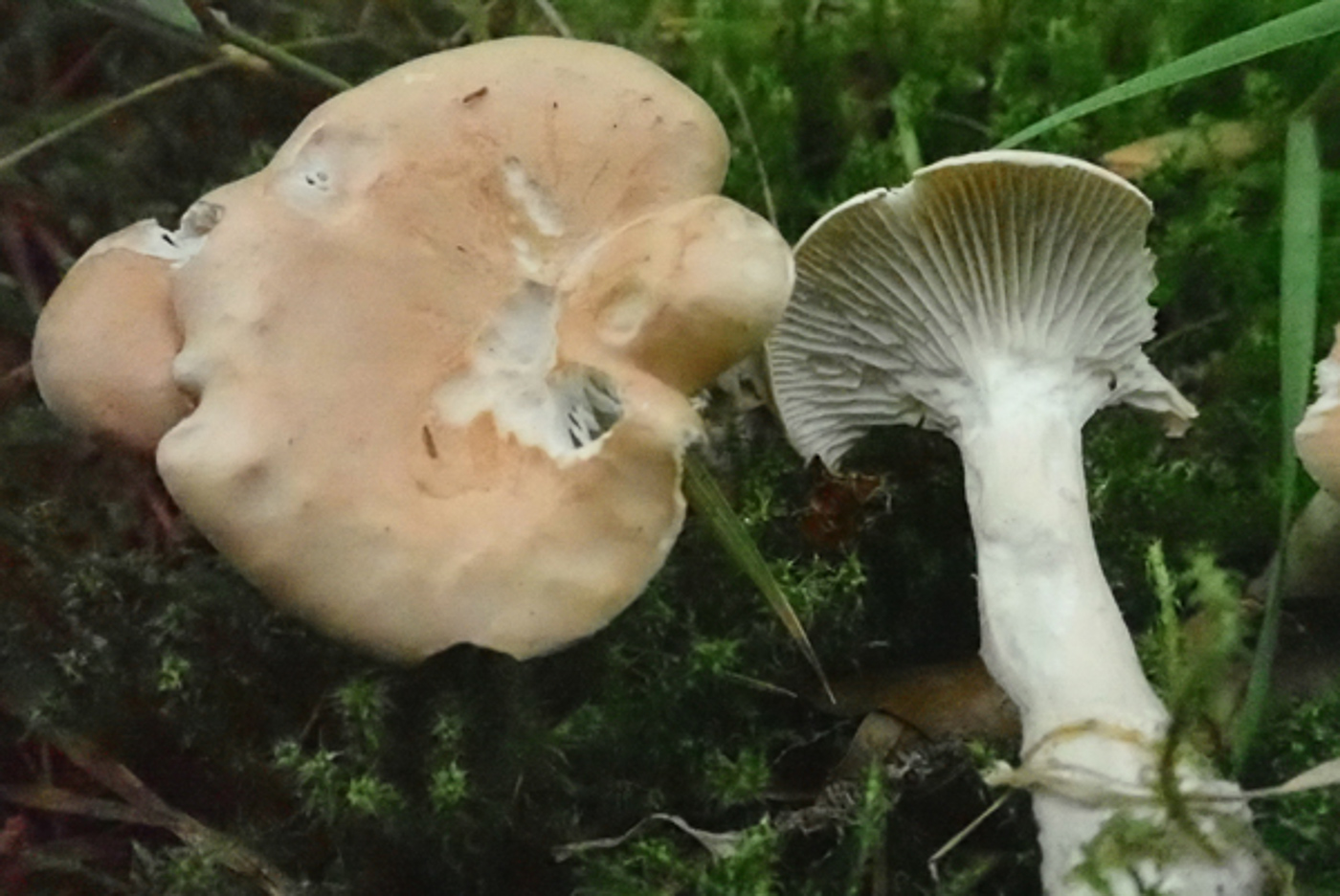
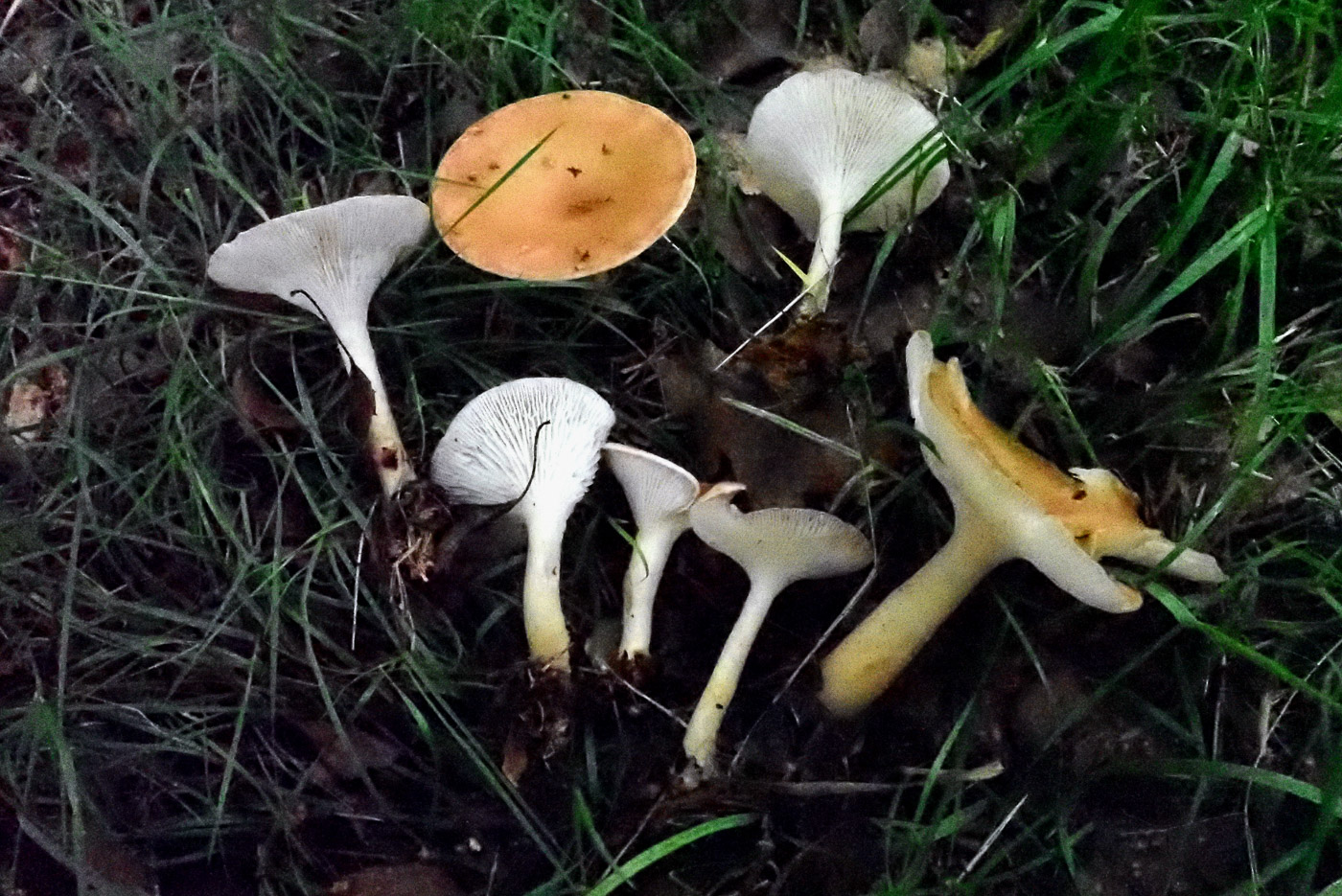
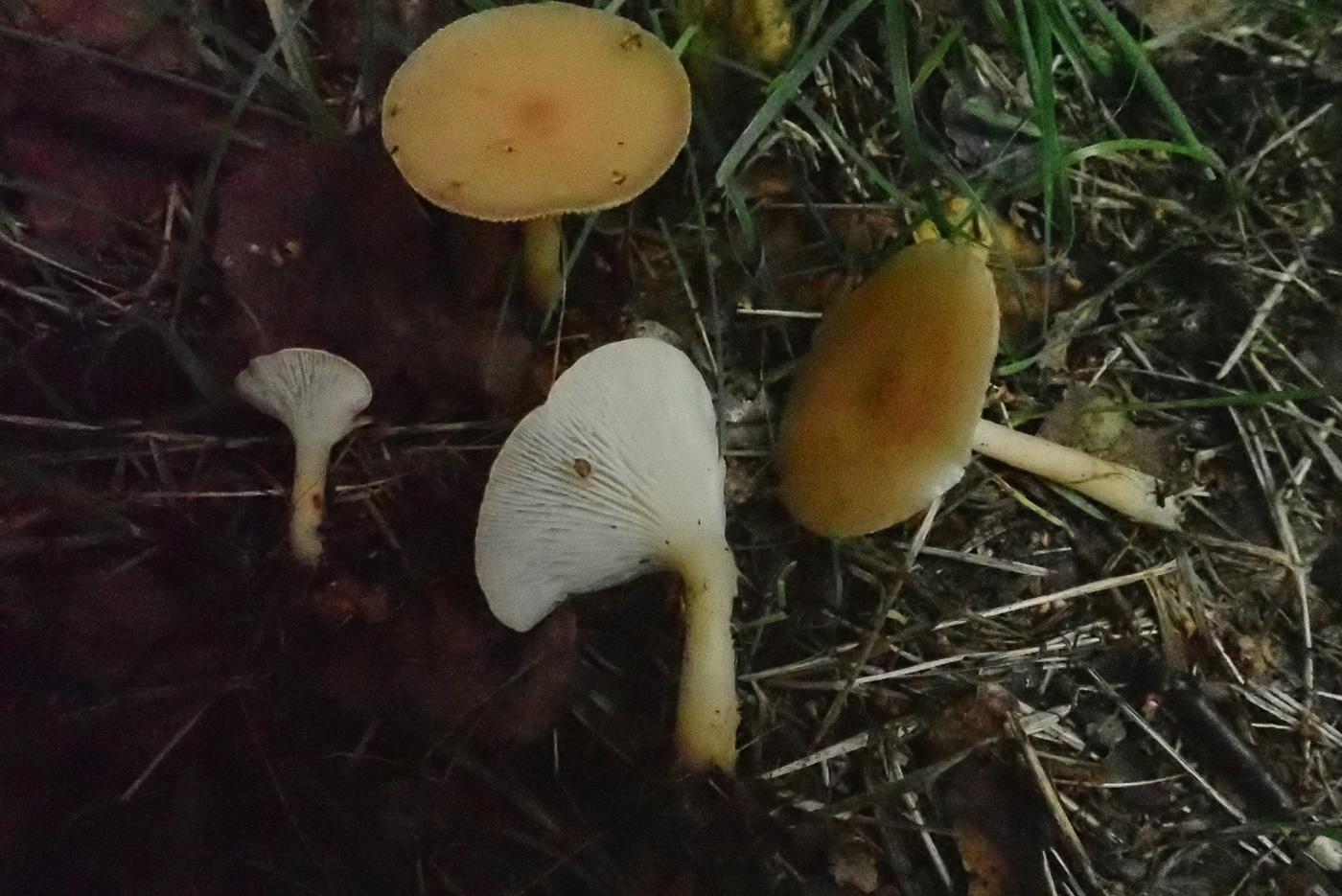
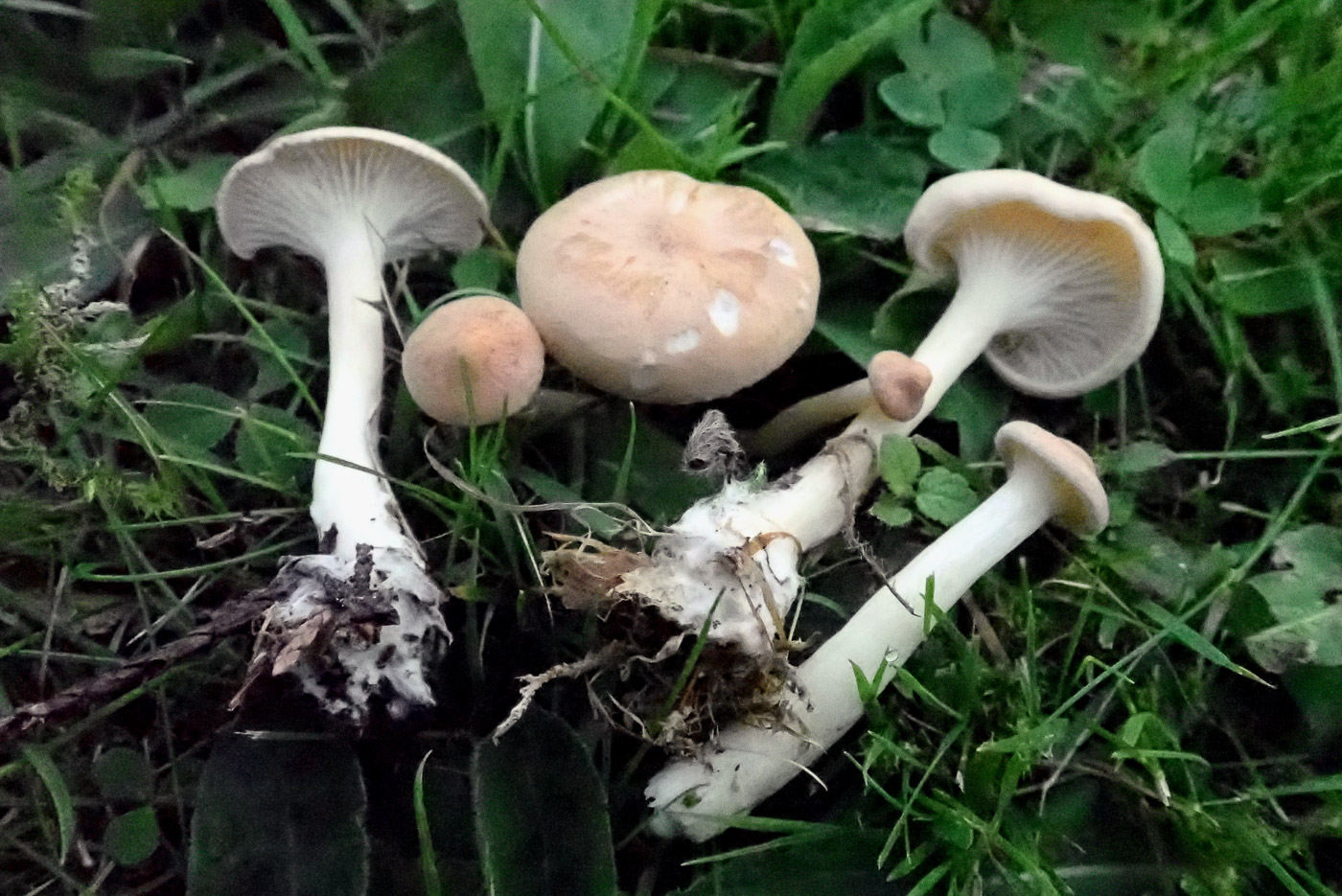 |
Infundibulicybe gibba (Common Funnel)
Jul 25, 2023. In Bernwood Forest under Oak Penny and Paul found this species just starting to fruit. Previously in genus Clitocybe, this is one of our commonest mushrooms inhabiting grassy glades and woodland litter; the distinctly decurrent crowded gills help to distinguish it from other pale capped species though the cap colour is variable and can be both paler and darker than shown here.
Sep 7, 2022. At Turville Heath Penny found a few examples of this early species (though not so early this year) coming up in woodland litter. As its common name suggests, it was until recently in the genus Clitocybe (Funnel) though several species which are truly 'infundibuliform' (funnel-like) as this one are now moved to this new genus - a bit of a mouthful but descriptive!
Jun 13, 2022. In grass under Pine at Turville Heath Penny was pleased to find this cluster just appearing. This is one of our commonest early season fruiters but amongst our many records the earliest is for June 25th. The pink-buff tinge to the cap and white decurrent gills make it quite an easy one to recognise.
Oct 5, 2021. In Turville Heath Penny found many fruitbodies of this common species (better known as Clitocybe gibba) coming up in a grassy area under Birch. It is a typical Funnel having obvious decurrent gills (those which slope partway down the stem) and when fresh and damp as here the caps can have a pinkish tinge. They are often much paler cream and never get much bigger than 5 cm across or so and can be found in both woodland and grassland.
Aug 14, 2021. In the churchyard at Penn Street Penny found several young specimens of this common species (better known as Clitocybe gibba) just emerging. The largest cap was only 2cm across and the smallest caps still had a distinct nipple in the middle (visible in a couple here) - a feature which soon disappears as they expand and develop the strongly infundibuliform (goblet) shape. The species occurs in grassland as well as woodland glades.
|
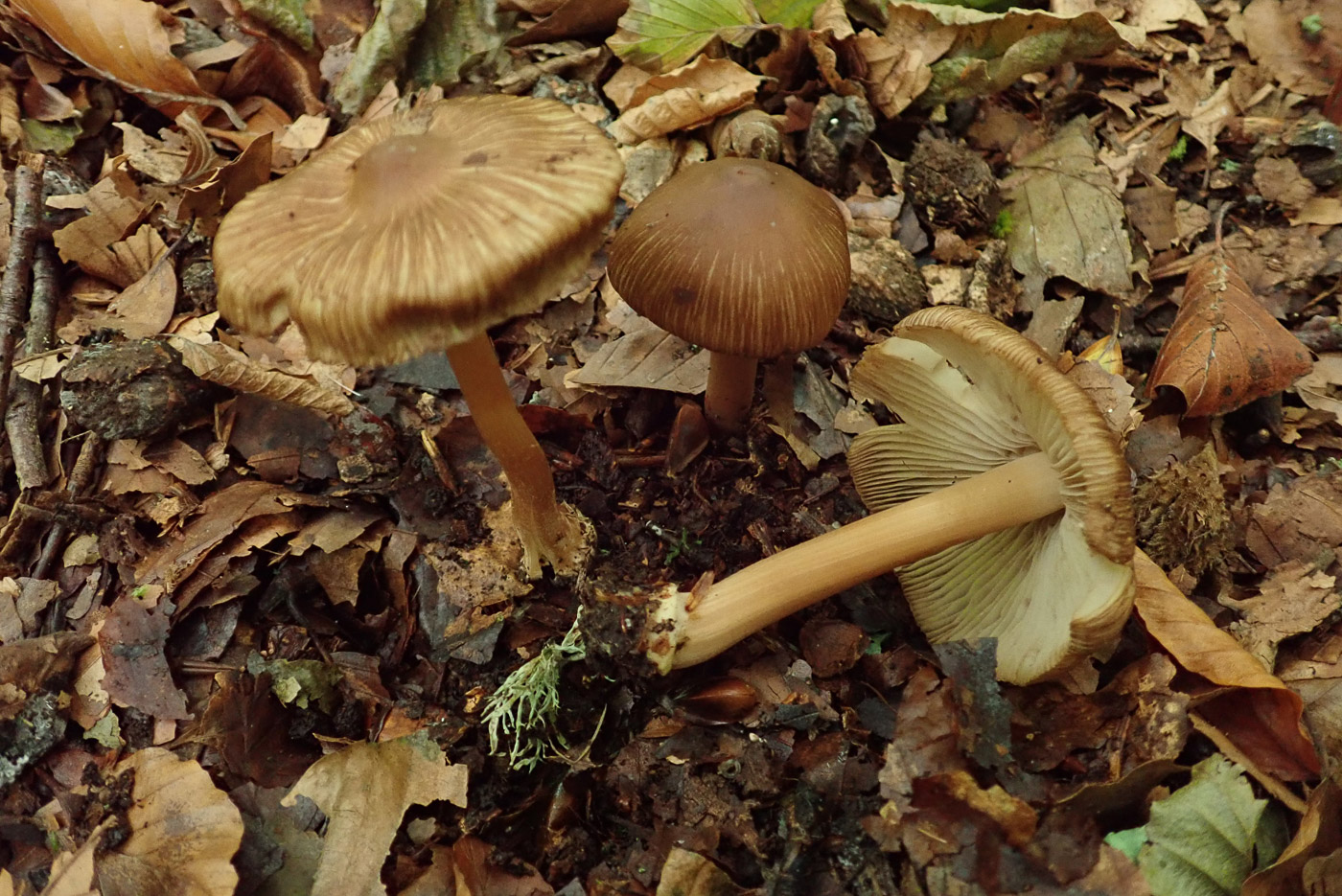 |
Inocybe asterospora (Star Fibrecap) 
Oct 12, 2020. This species was fruiting in large numbers under Beech in Gussetts Wood, found by Penny and Paul Cullington. It is one of the commoner and larger Fibrecaps and in fact recognisable in the field if you note the bright brown streaky fibrous caps, the beige gills and stems - concolorous with the cap - which have a distinct whitish bulb at the base. The LH fruit body here has the typical abruptly downturned margin often seen in the species. Nevertheless, one should always check for the amazing star-shaped spores to confirm your identification.
|
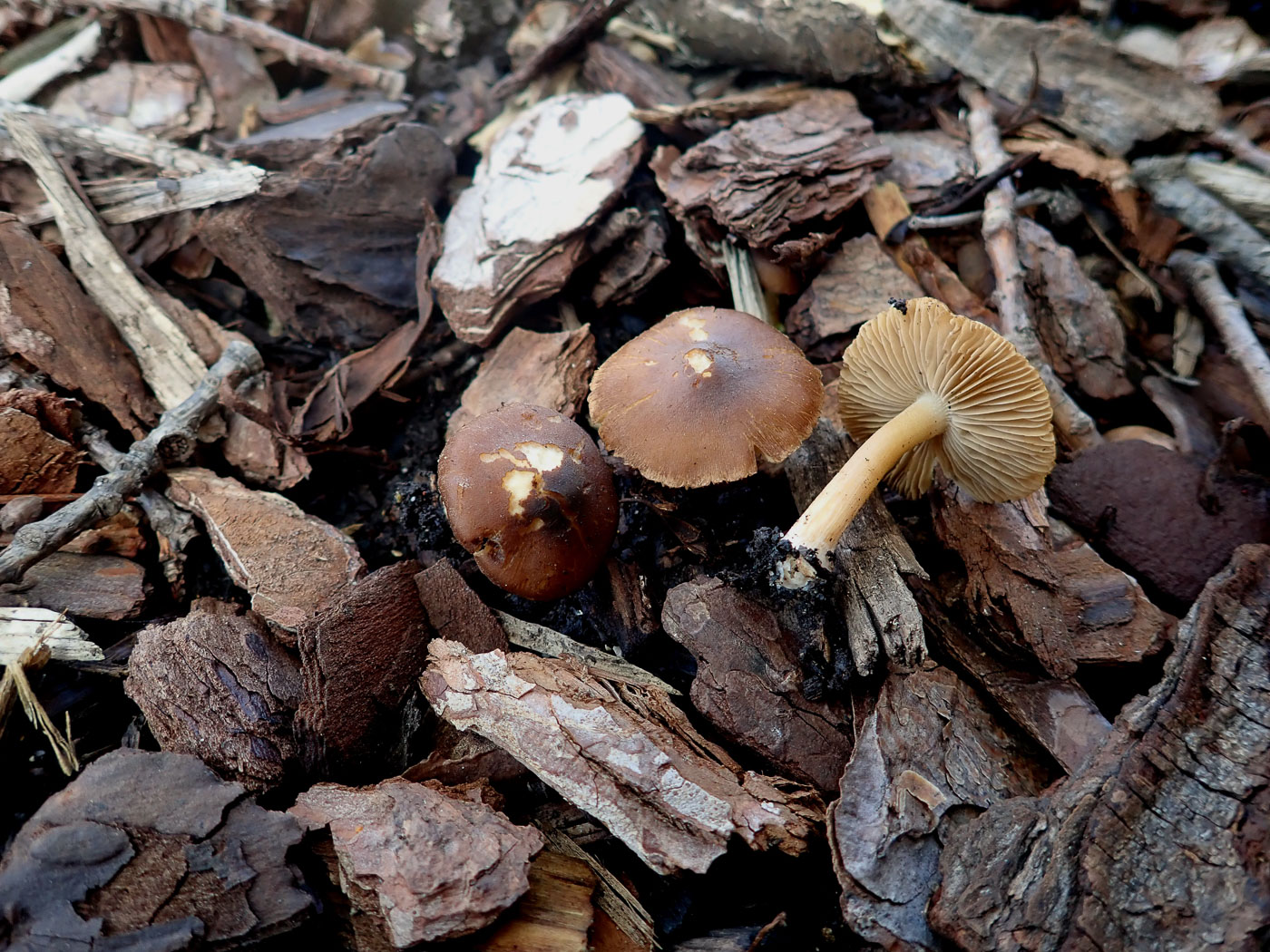 |
Inocybe cf tjallingiorum (a rare Fibrecap) 
Apr 29, 2023. After a tip-off from Jesper Launder that in Gerrards Cross under Oak he'd seen yet another large collection of Fibrecaps (see also the entry for April 26th), Penny went to collect some after our Burnham Beeches Walk - where we also found a Fibrecap (see her report for more). Inocybe is an autumn fruiting mycorrhizal genus and quite remarkable to be fruiting now! Today's collection keyed out to near I. tjallingiorum, a rare species and one which has not been confirmed with sequencing from this country as yet (hence the 'cf' in the title here). However, sequencing has now shown it to be clearly not that species and with no known matches, making it potentially new to science.
|
 |
Inocybe calospora (a Fibrecap with no common name) 
Sep 19, 2022. Under Lime, Beech and Oak in his garden Jesper Launder found this small LBJ which he recognised as a Fibrecap and, knowing Penny's special interest and knowledge of the genus, he dried it to send to her. One swift glance under the microscope was all she needed to make the ID! The stunning spores of this species are unique, like small maritime mines, and even at low power she knew instantly what it must be. Though familiar with this rare species from other parts of the country, she has never found it in Bucks, so this was an exciting find.
|
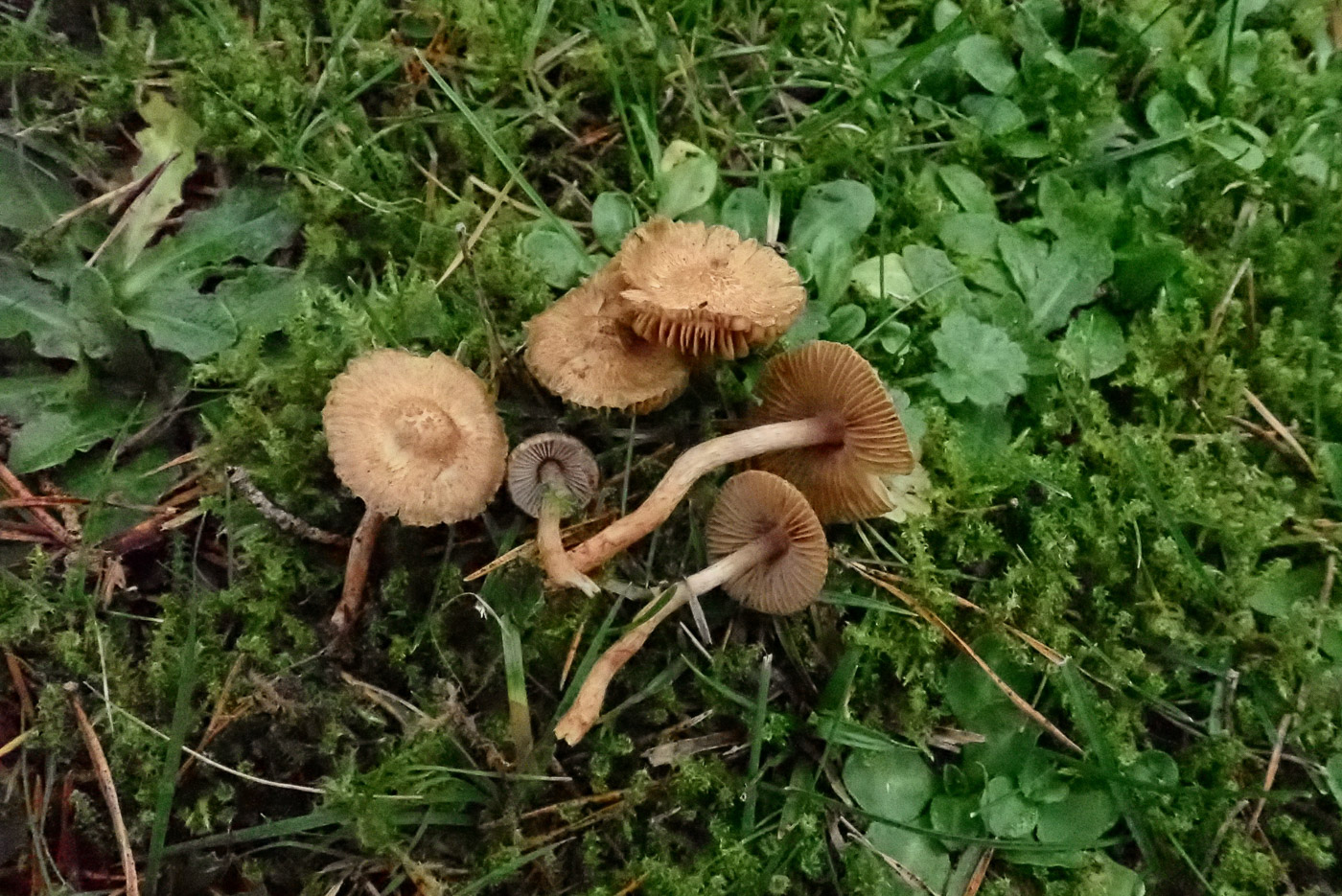 |
Inocybe cincinnata (Collared Fibrecap) 
Nov 18, 2021. Under Pine just outside Prestwood Churchyard Penny found a group of this quite common species (though why this common name was chosen she has no idea!) In the field features to notice are the roughened scaly brown cap (often more markedly than seen here), the darker brown edge to the gills, the lilaceous tints at the top of the stem which has no swelling at its base, and the typical spermatic smell of the genus. Under the scope the gill edge is very distinctive with all cells having brown contents.
|
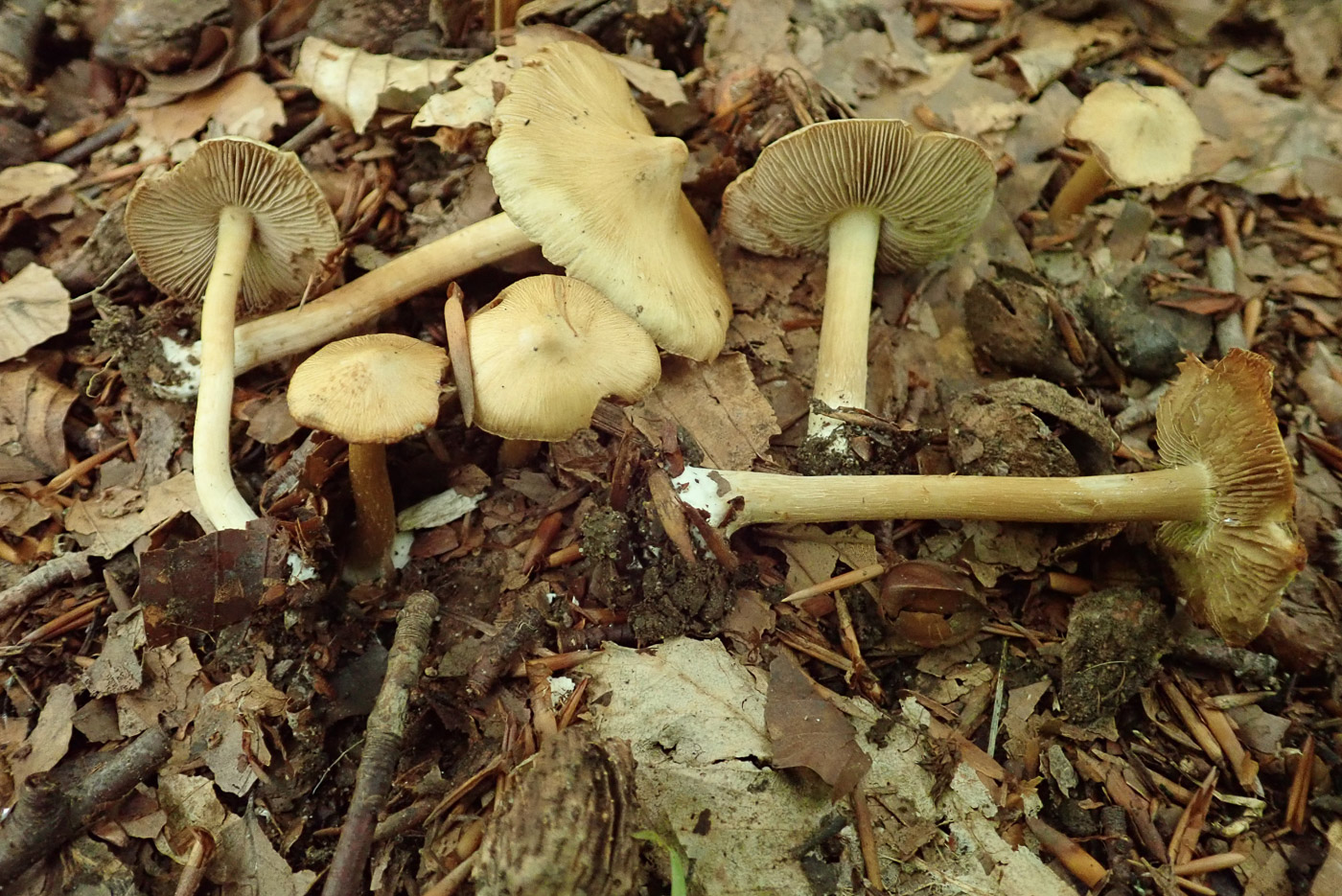 |
Inocybe cookei (Straw Firecap)
Sep 7, 2020. This species, found by Penny Cullington in Mousells Wood under Beech, is a typical member of this large genus, many species of which are not identifiable without recourse to a scope  . Fibrecaps often have brown caps with a finely splitting surface, gills which are pale to snuff brown and strange smells. . Fibrecaps often have brown caps with a finely splitting surface, gills which are pale to snuff brown and strange smells.
|
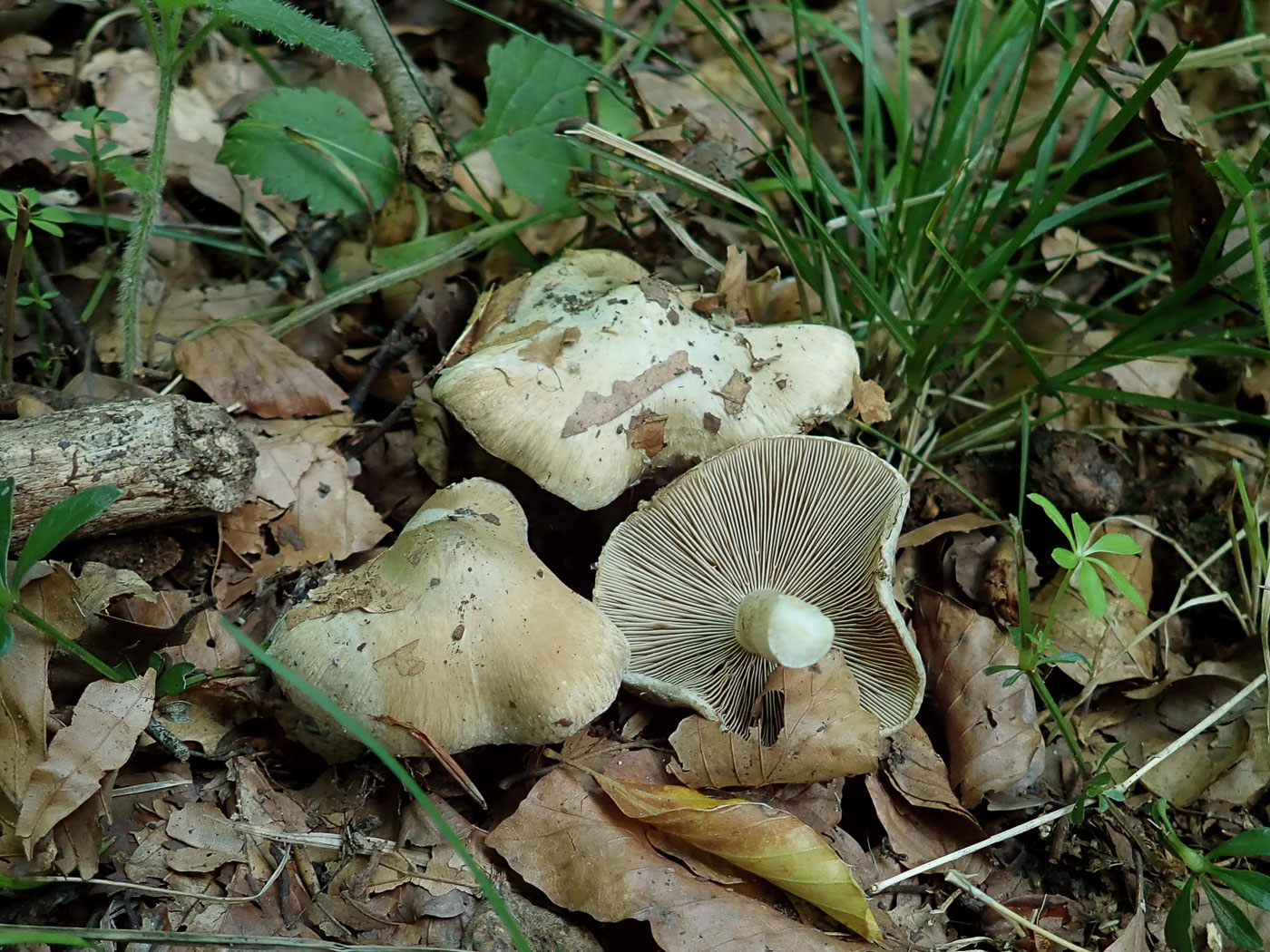 |
Inocybe corydalina (Greenflush Fibrecap) 
Aug 23, 2023. Under Beech in soil at a pathside in Mousells Wood Penny Geoffrey Kibby spied these quite unusual Fibrecaps which Penny recognised from their conical shape, greenish flush over the cap centre and - once collected - the pervasive smell of pear drops. One of several somewhat similar Fibrecaps having this distinctive smell (see also I. fraudans - the last entry for August 16th) it can also have green tints at the stem base - a sign of the presence of Psilocibin - though not seen in today's collection. This is a new entry for Finds. (The photo is Penny's.)
|
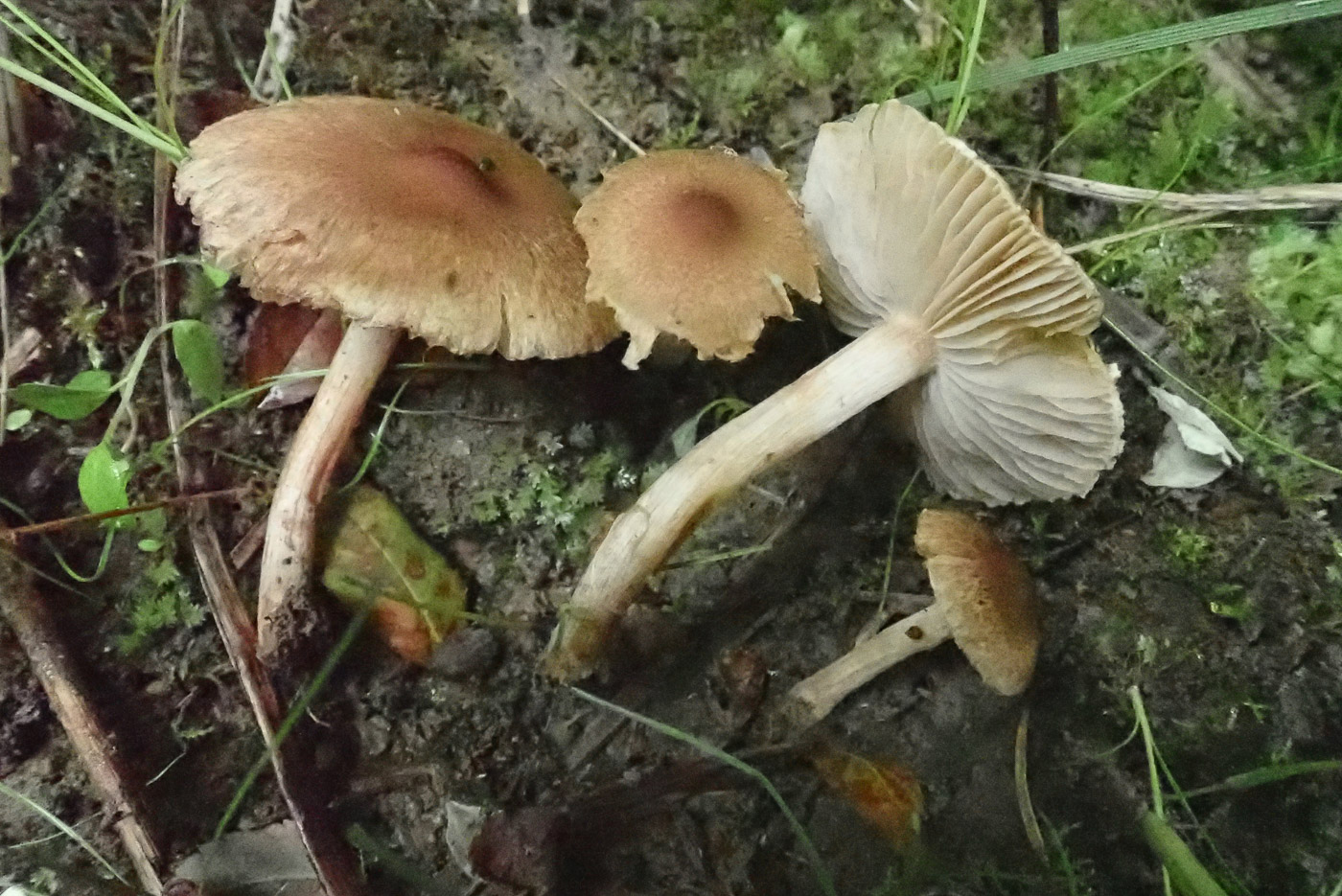
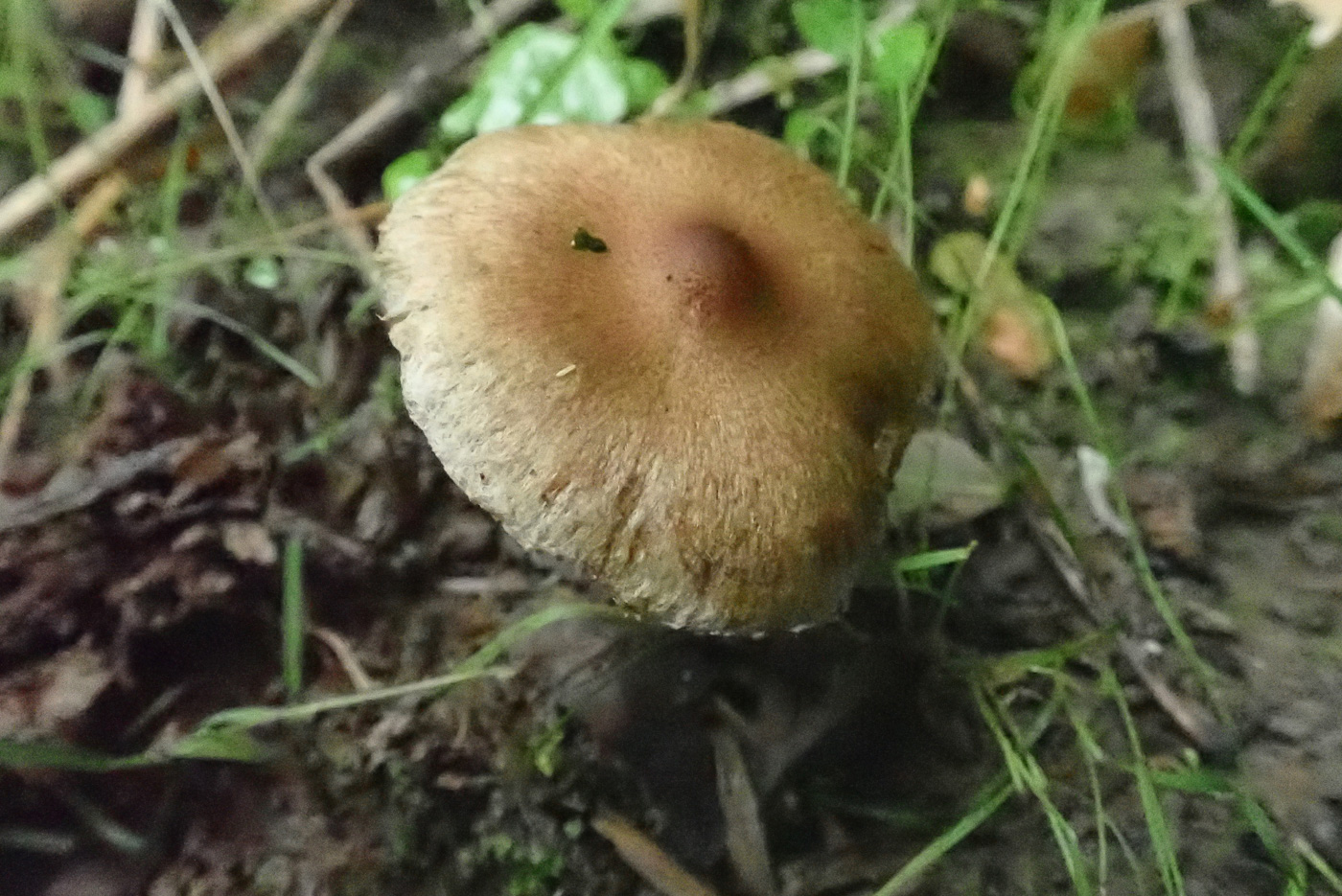 |
Inocybe curvipes (a Fibrecap with no common name) 
Aug 3, 2021. At the edge of a muddy path under Hazel in Rushbeds Wood Penny found this group of typical Fibrecaps - a genus well qualified as LBJs with about 150 species, all but a very few needing a scope to identify with safety. Most have brown caps of some shade, with (as here) or without a central umbo which is a bit darker and the dry often fibrous surface tends to split towards the margin (see photo 2). Gills are pale brown becoming darker with maturity and stems vary in colour and sometimes have a basal bulb (not in today's species). I. curvipes is not rare and has a unique combination of distinctive nodulose spores and bloated thick walled cells on the gill edge and face, occurring under deciduous trees. (The species name, curvipes meaning a curved stem, is misleading and could equally apply at times to others as well thought today's were slightly curved!) We have a good number of records from a handful of county sites though it was new today for Rushbeds.
|
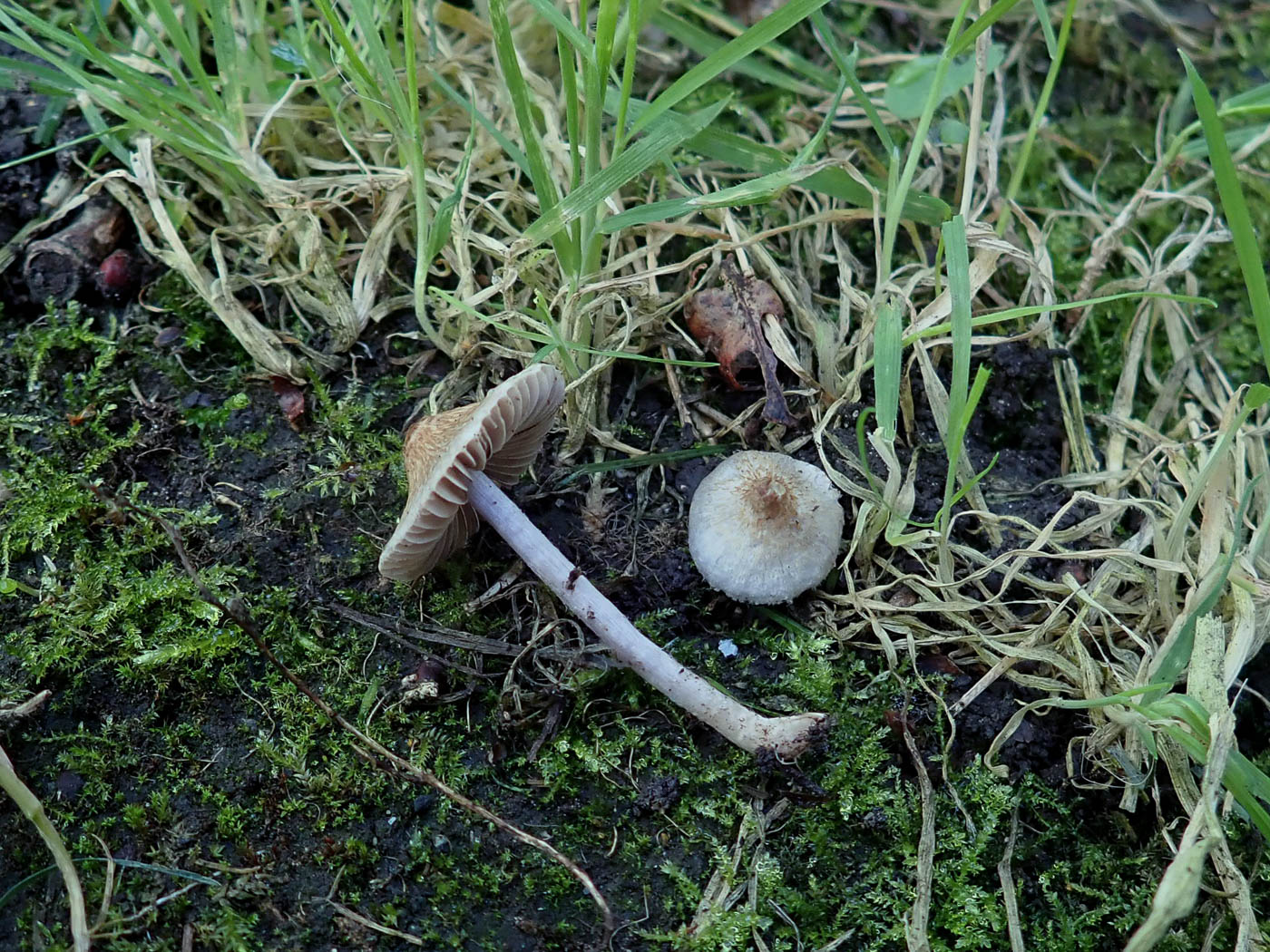
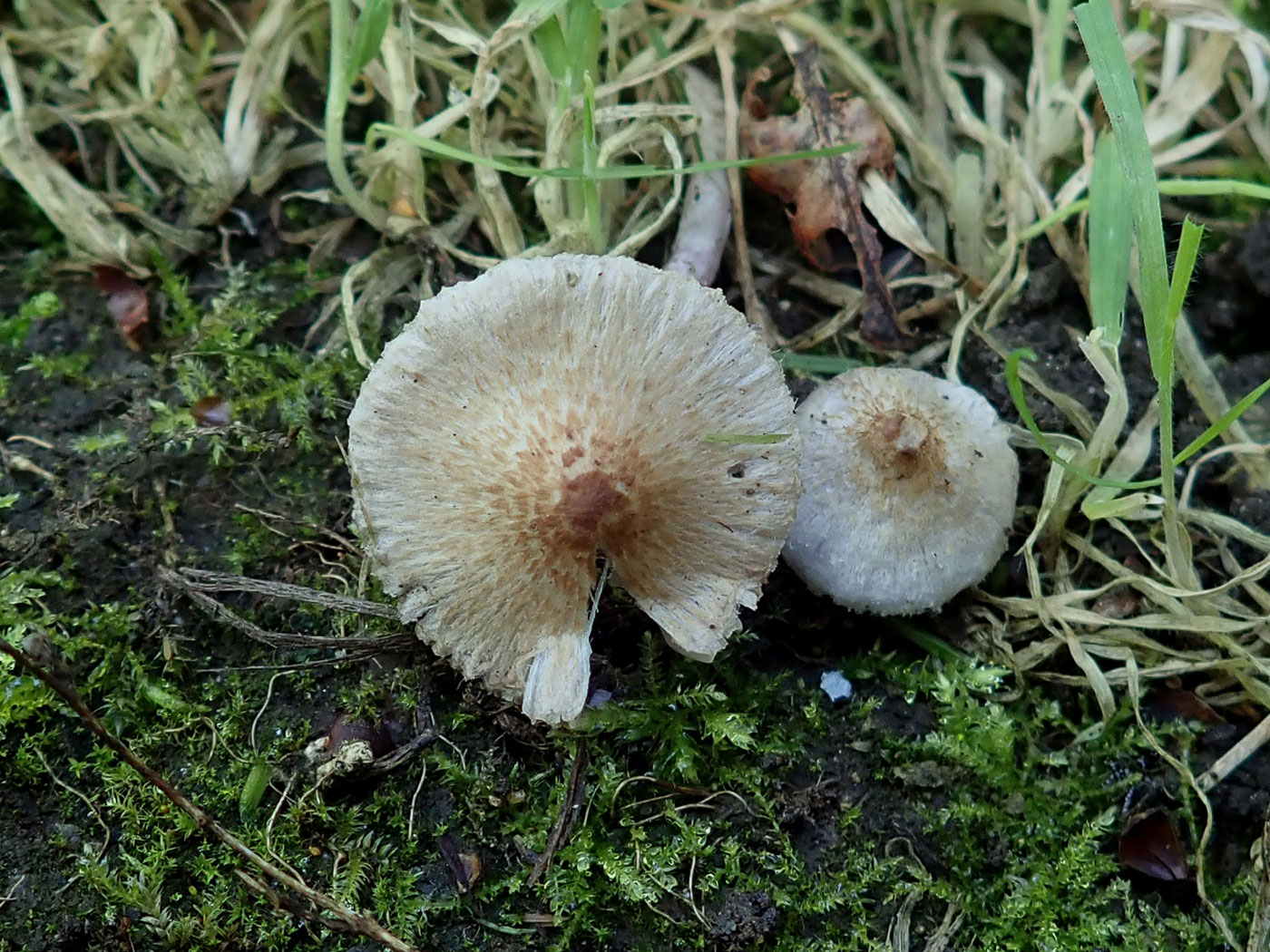 |
September 12th Inocybe dryadiana (a very rare Fibrecap with no common name)  
Sep 12, 2023. In soil under Oak at Turville Heath Penny found two small Fibrecaps having a distinctly lilaceous stem but a cap which didn't conform to any of the few species she knew which had such a stem. Working on it at home she could only come up with I. gaiana - a recently described species with only one proven previous UK record from Wales - which has a buff slightly scaly cap with lilac colours when young as here. The microscopic characters were not an exact fit, however, so it was no surprise when sequenced that it proved to be not that species but Inocybe dryadiana - first described in 2021 and new to the UK.
|
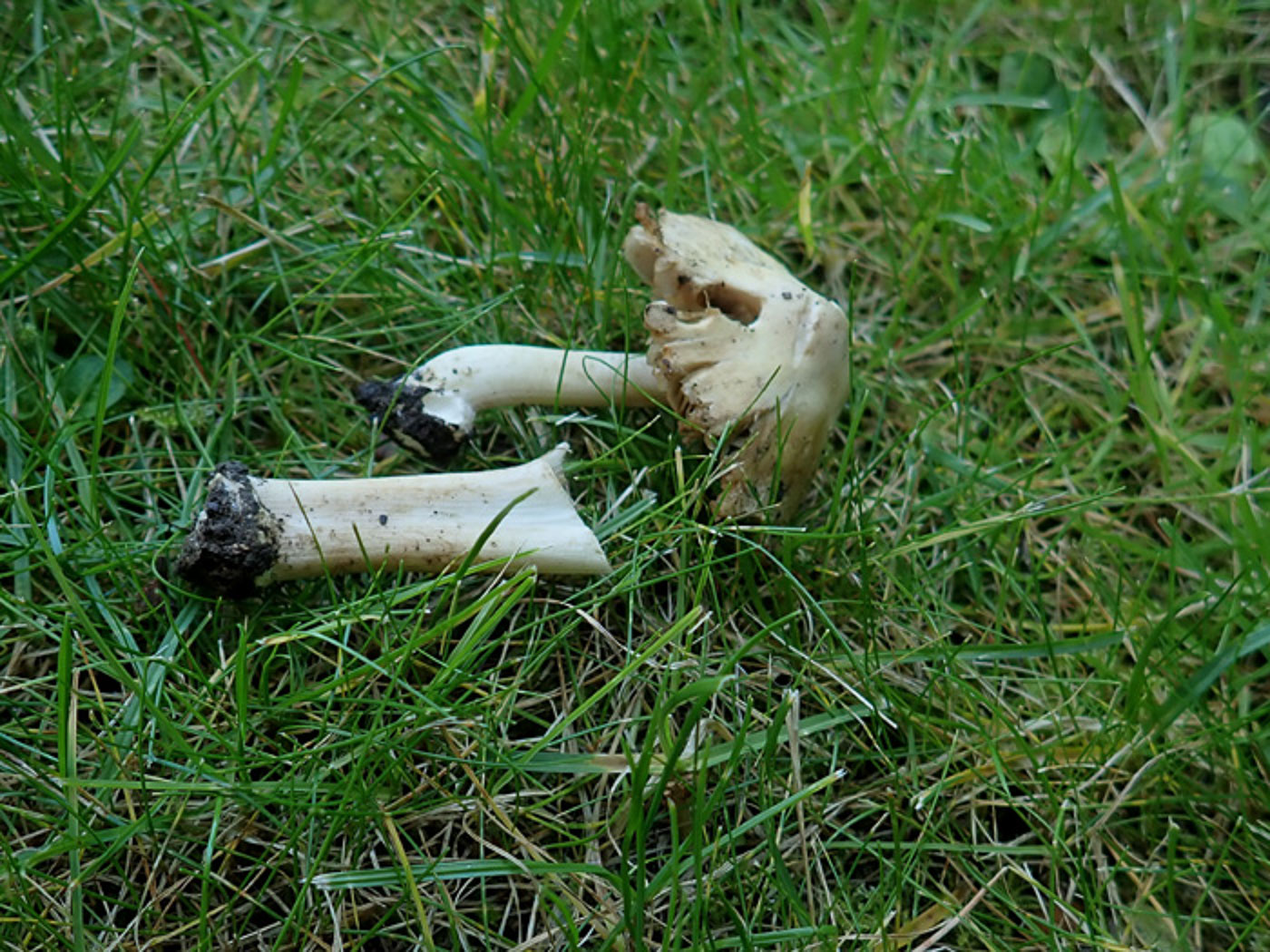
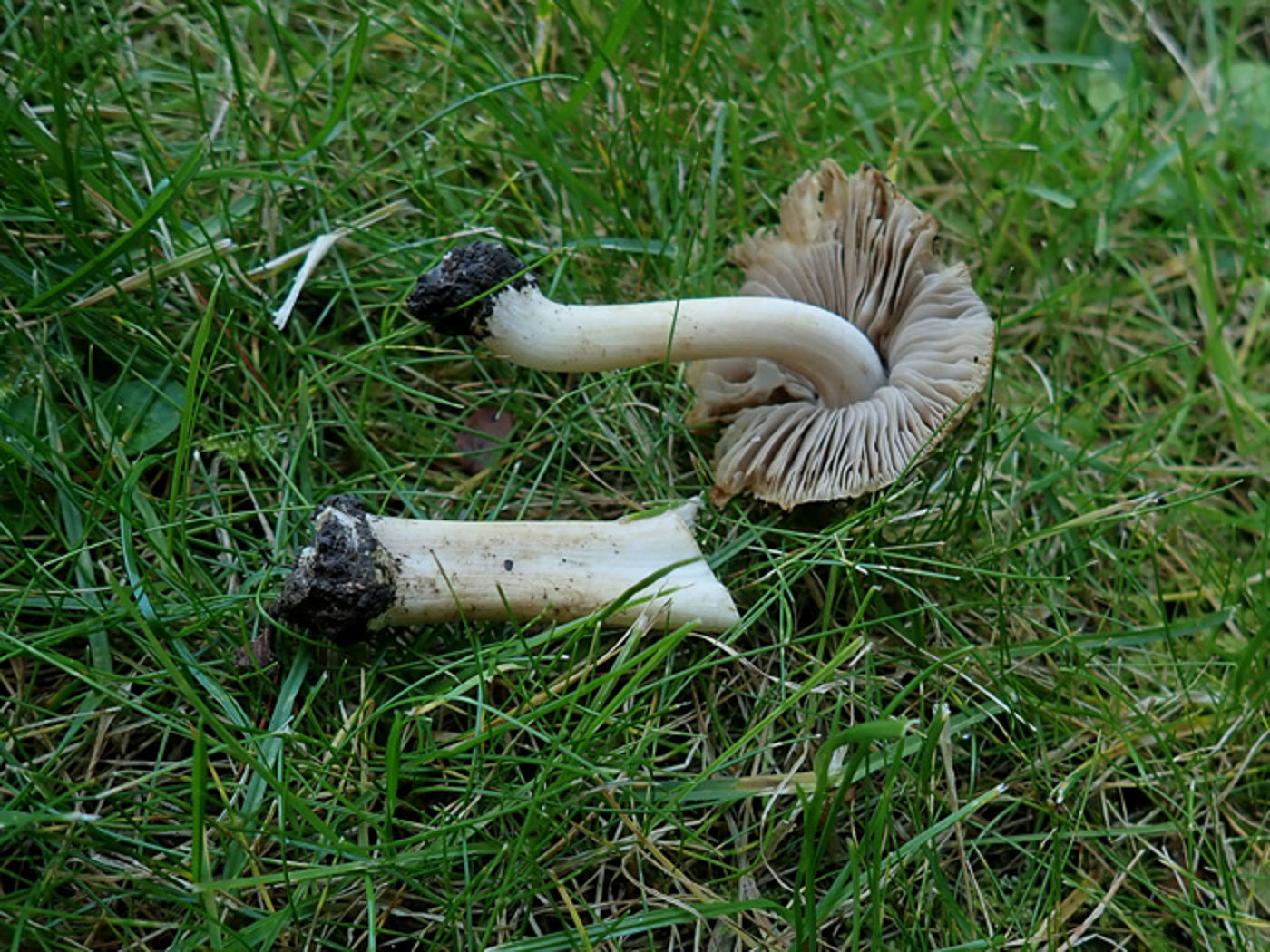 |
Inocybe duriuscula (a very rare Fibrecap with no common name) 
Aug 8, 2023. In preparation for our microscope workshop the following day, Bob Simpson collected samples from his wood, Salden Wood, and amongst them was this Fibrecap which Penny and others worked on at the workshop. This is quite a large Fibrecap with a pale buff to ivory smooth cap, a chunky white stem having a bulb at its base, also distinctive micro characters. It occurs under deciduous trees and we have just two previous county records. (The photos were taken by Penny on her lawn a couple of days later.) This is a first for Finds.
|
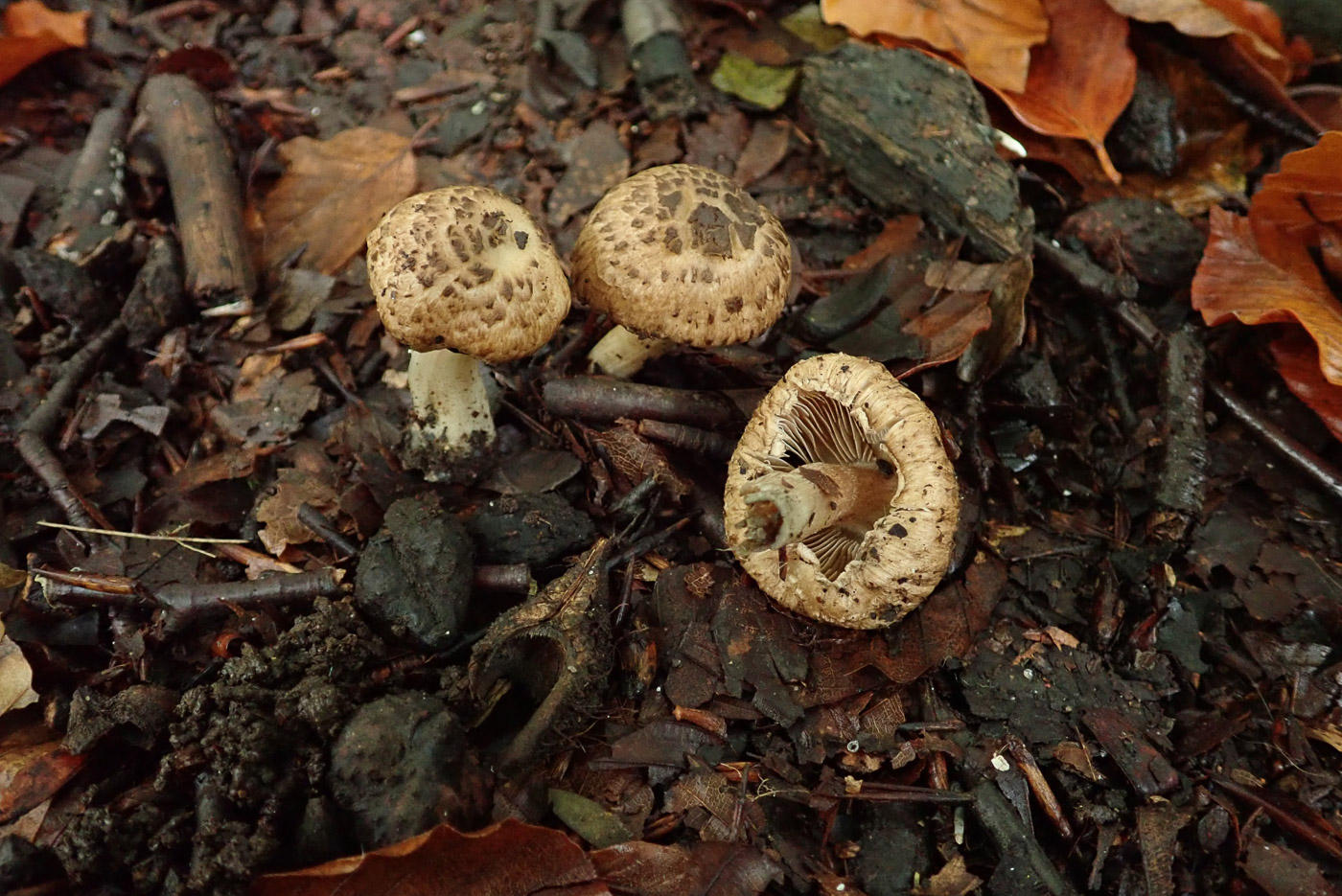 |
Inocybe erinaceomorpha (a Fibrecap with no common name)
Oct 14, 2020. Kings Wood provided the first records of this rare Fibrecap for over 50 years when Penny Cullington discovered it here a few years ago when a boy from a school party she was taking round handed it to her. Since then it has appeared here fairly frequently but in very few other places in the country. For a Fibrecap it is quite an easy one to recognise, having two redeeming features: a cap with the large dark brown scales on a beige background, and a distinctive and pervasive smell of peardrops!
|
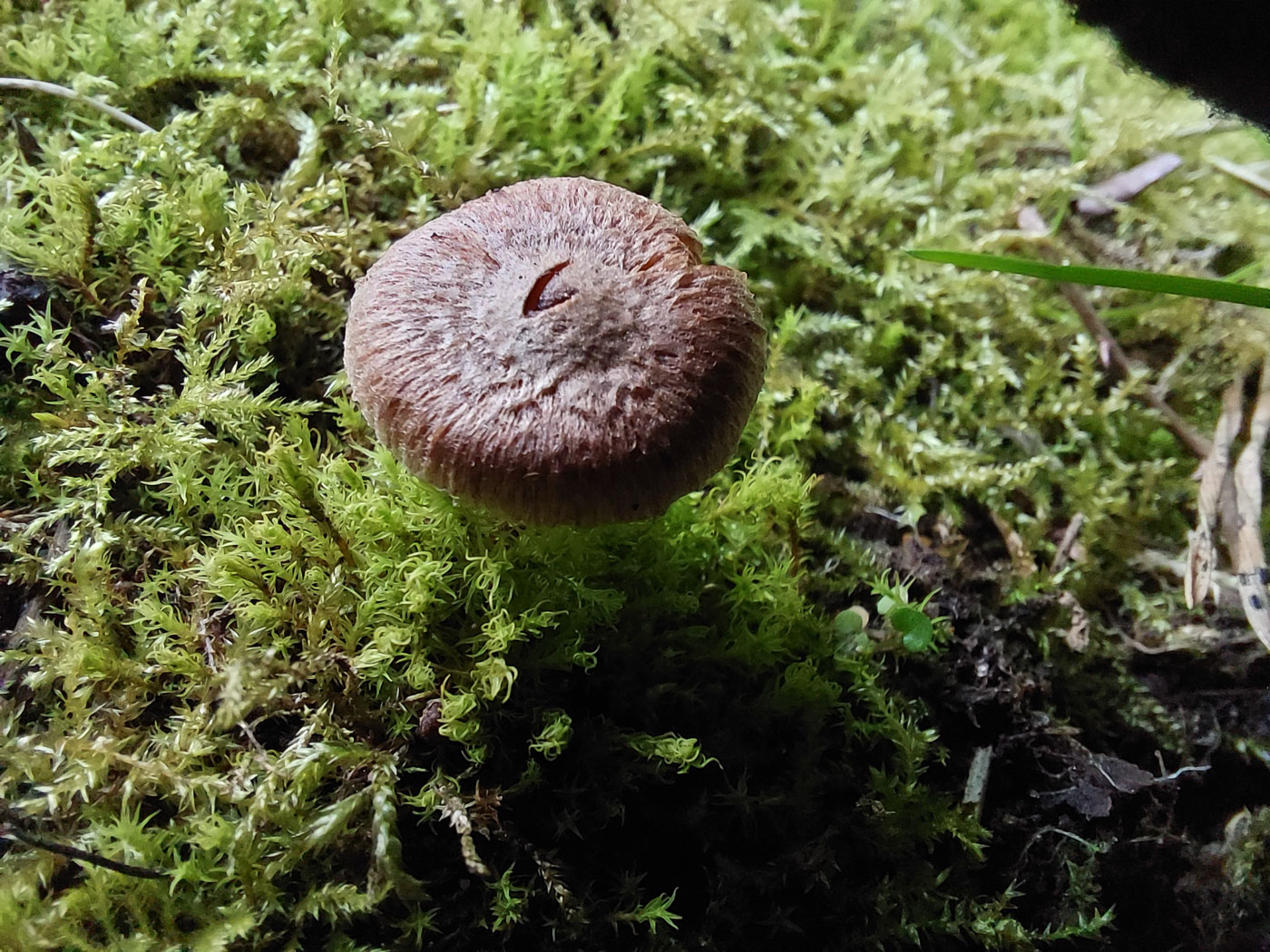
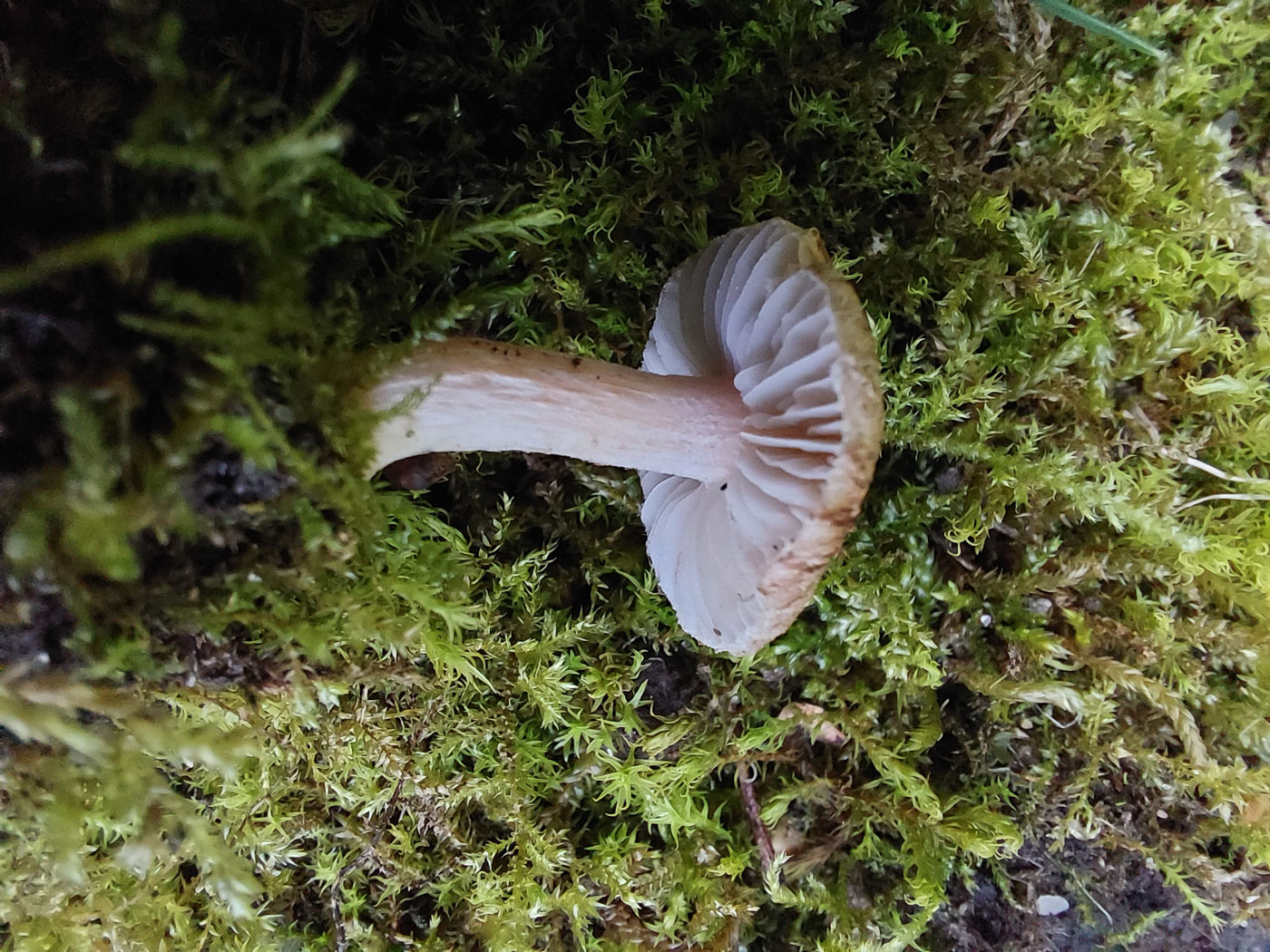
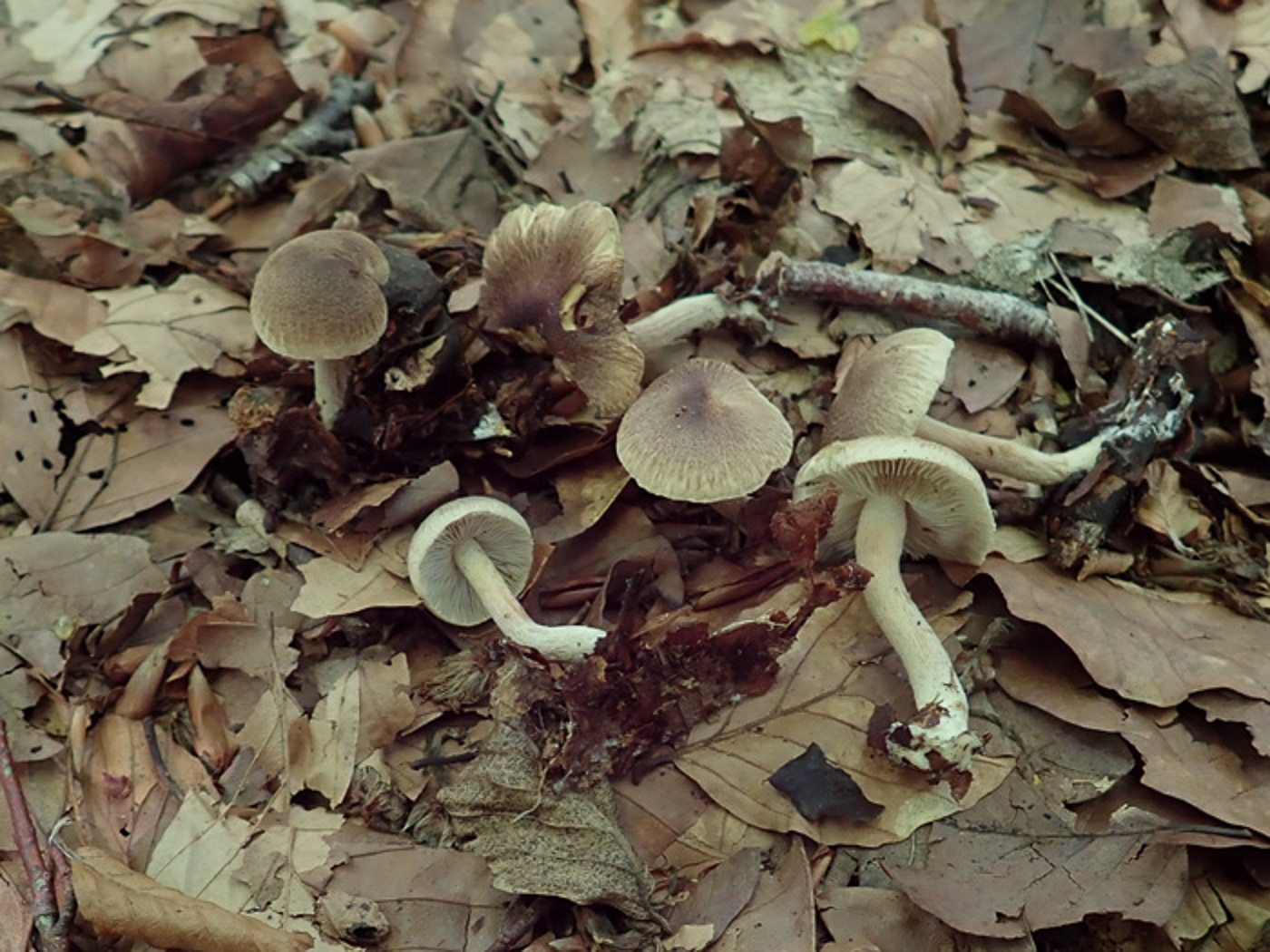
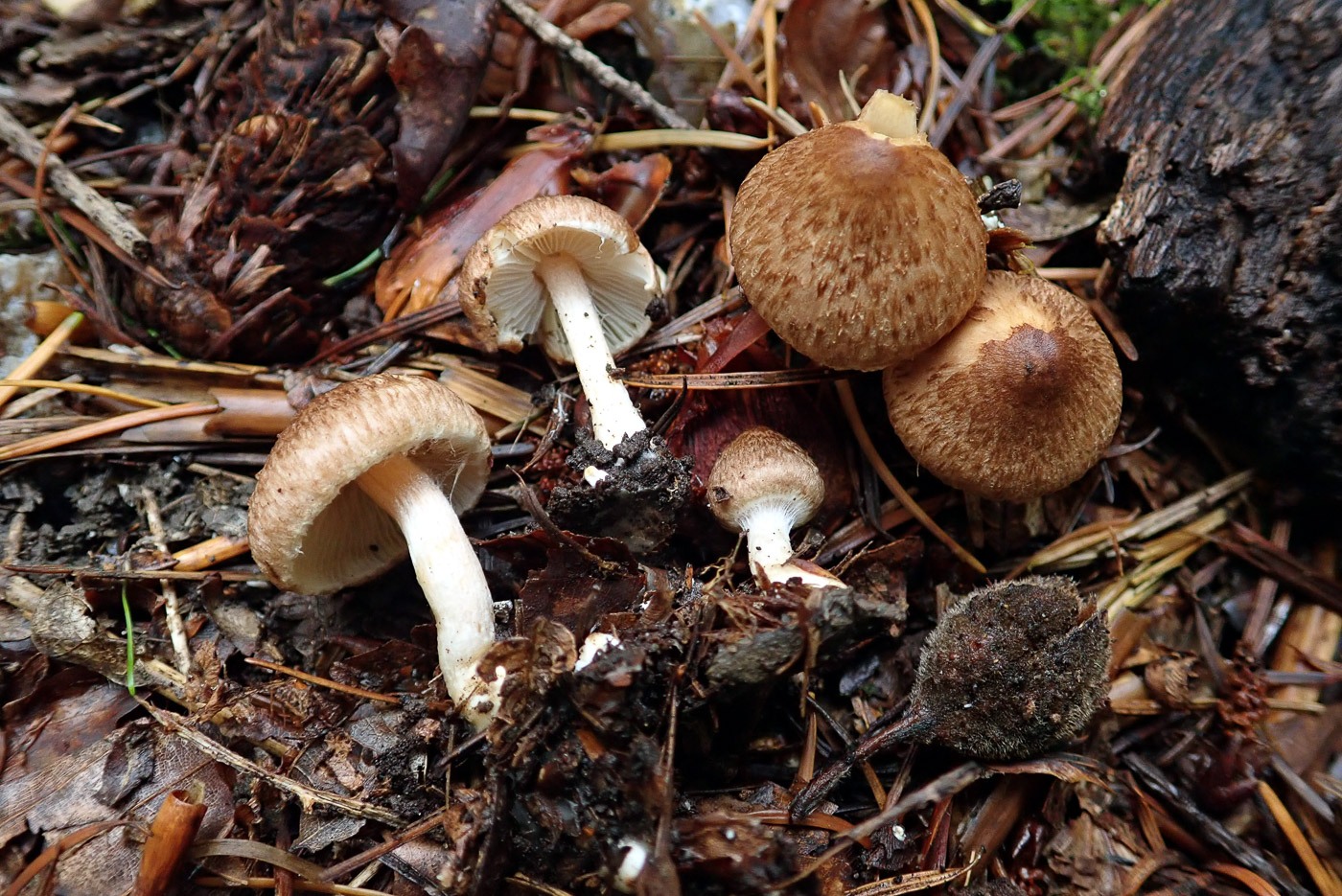
|
Inocybe flocculosa (Fleecy Fibrecap) 
Mar 21, 2024. In Gerrards Cross Jesper Launder continues to turn up unseasonal fungi, this certainly being one. The genus is rarely reported earlier than June though Jesper did find one here in May last year. This collection was near to both Oak and Pine and is considered one of the commoner Fibrecaps, but there's a chance - once we get this collection sequenced - that it may turn out to be the extremely similar I. tigrina, the differences between the two (both macro and micro) are still unclear. If so this entry will be updated.
Aug 16, 2023. In Gussett's Wood under Beech Penny and Paul found this quite common Fibrecap - a typical LBJ with no very distinctive macro features and always needing a scope to identify. Even so, though common it can be tricky to determine with a process of elimination needed, but Penny was eventually confident she had it nailed!
Oct 5, 2020. Penny Cullington found this collection under Douglas Fir in Common Wood. With so many very similar brown capped Fibrecaps, often classed as LBJs (Little Brown Jobs), it is not possible to name them without using a scope, but this species being a fairly typical example of the genus it was though worth including here.
|
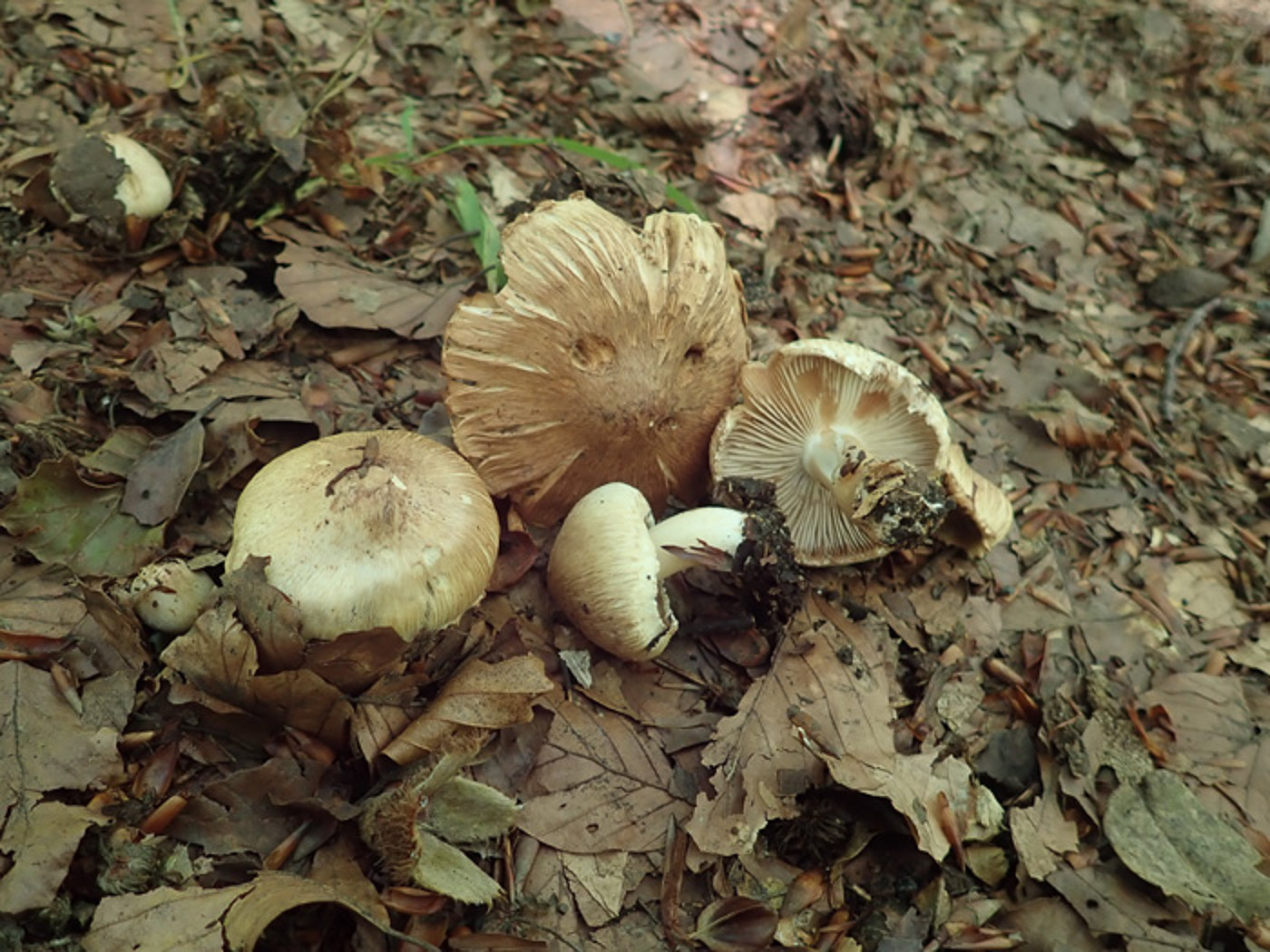
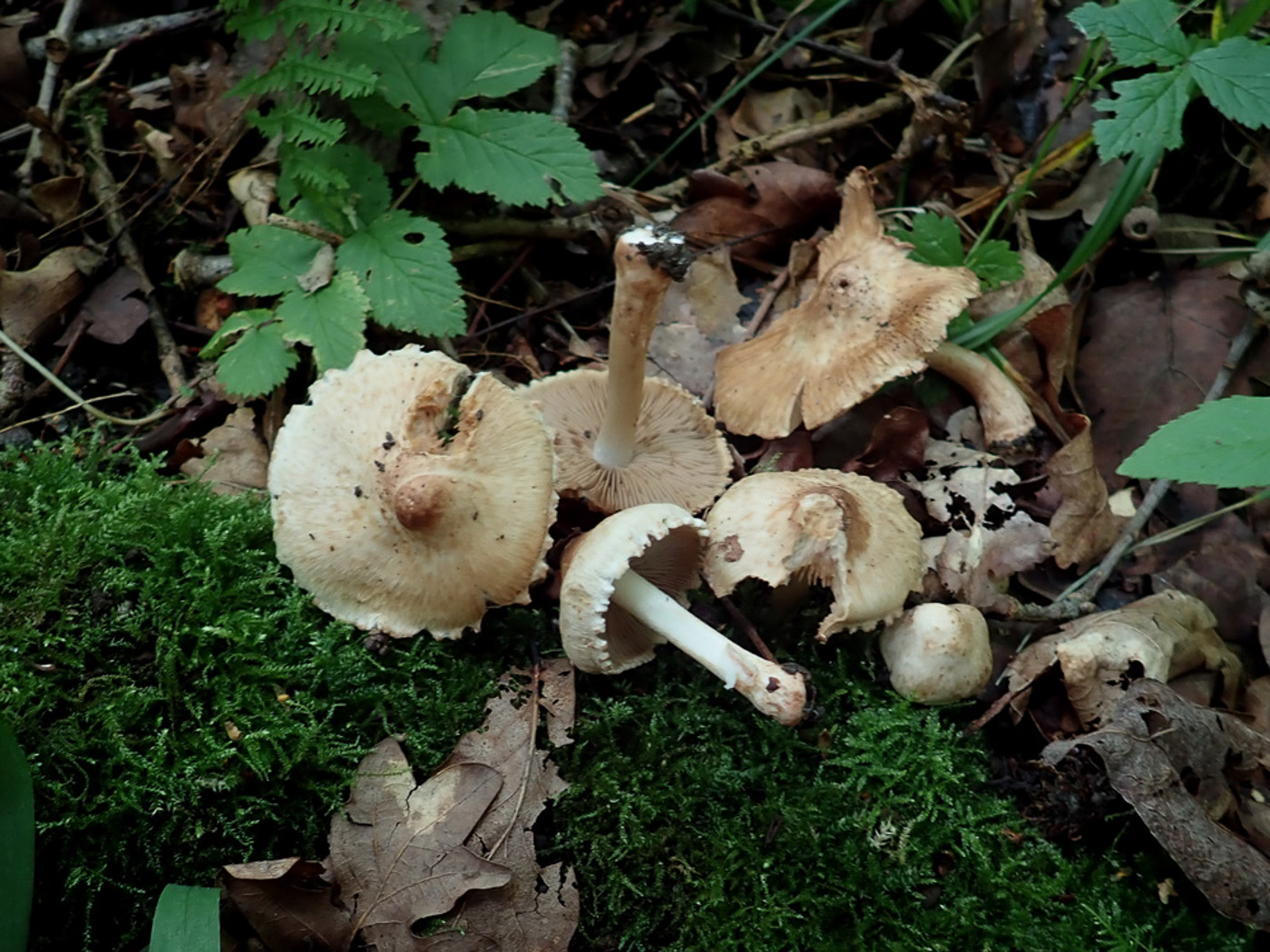 |
Inocybe fraudans (Pear Fibrecap) 
Aug 16, 2023. In Gussett's Wood Penny and Paul found this quite unusual Fibrecap on a muddy roadside bank under Beech. The species is one of several which have a distinctive and pervasive smell of pear drops though today's, being the most common of these species, refers to the smell in its common name. It is quite a chunky squat Fibrecap with a pale brown cap, sometimes splitting as it expands, and can sometimes redden when damaged or scratched (though today's collection did not do so). Photo 2 shows a collection from Rushbeds Wood made by Penny three days later where the species was abundant. The frilly cap margin seen here can quite often be a feature. This is a new entry for Finds.
|

 |
Inocybe cf gaiana (a very rare Fibrecap with no common name) 
Sep 14, 2023. In soil under Oak at Turville Heath Penny found two small Fibrecaps having a distinctly lilaceous stem but a cap which didn't conform to any of the few species she knew which had such a stem. Working on it at home she could only come up with I. gaiana - a recently described species with only one proven previous UK record from Wales - which has a buff slightly scaly cap with lilac colours when young as here. The microscopic characters are not an exact fit, however, hence the 'cf' indicating similar to that species, and the material will be sent for sequencing. If correct this would be the second UK record, but it could also be a different species - described or not as yet!
|
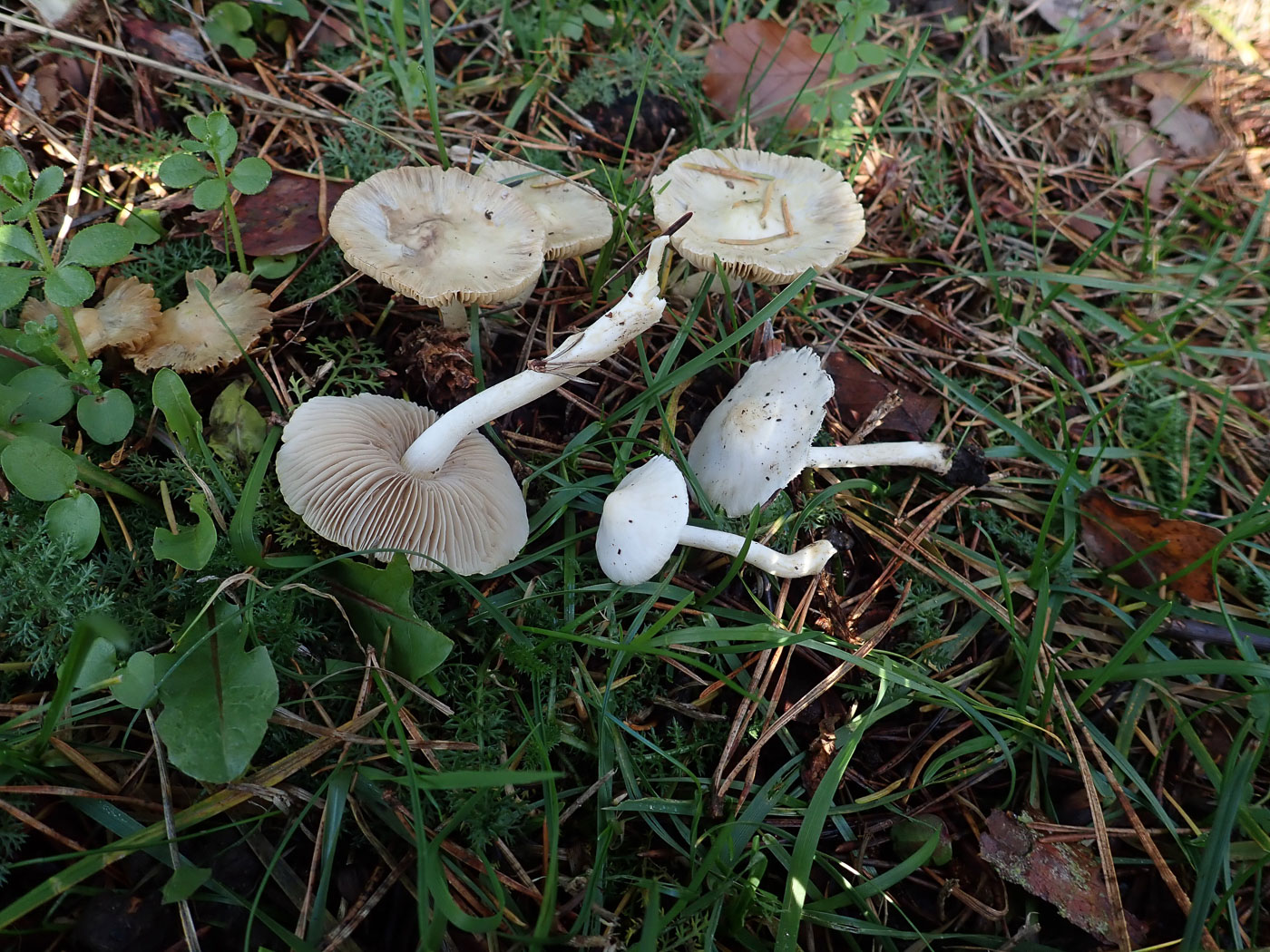
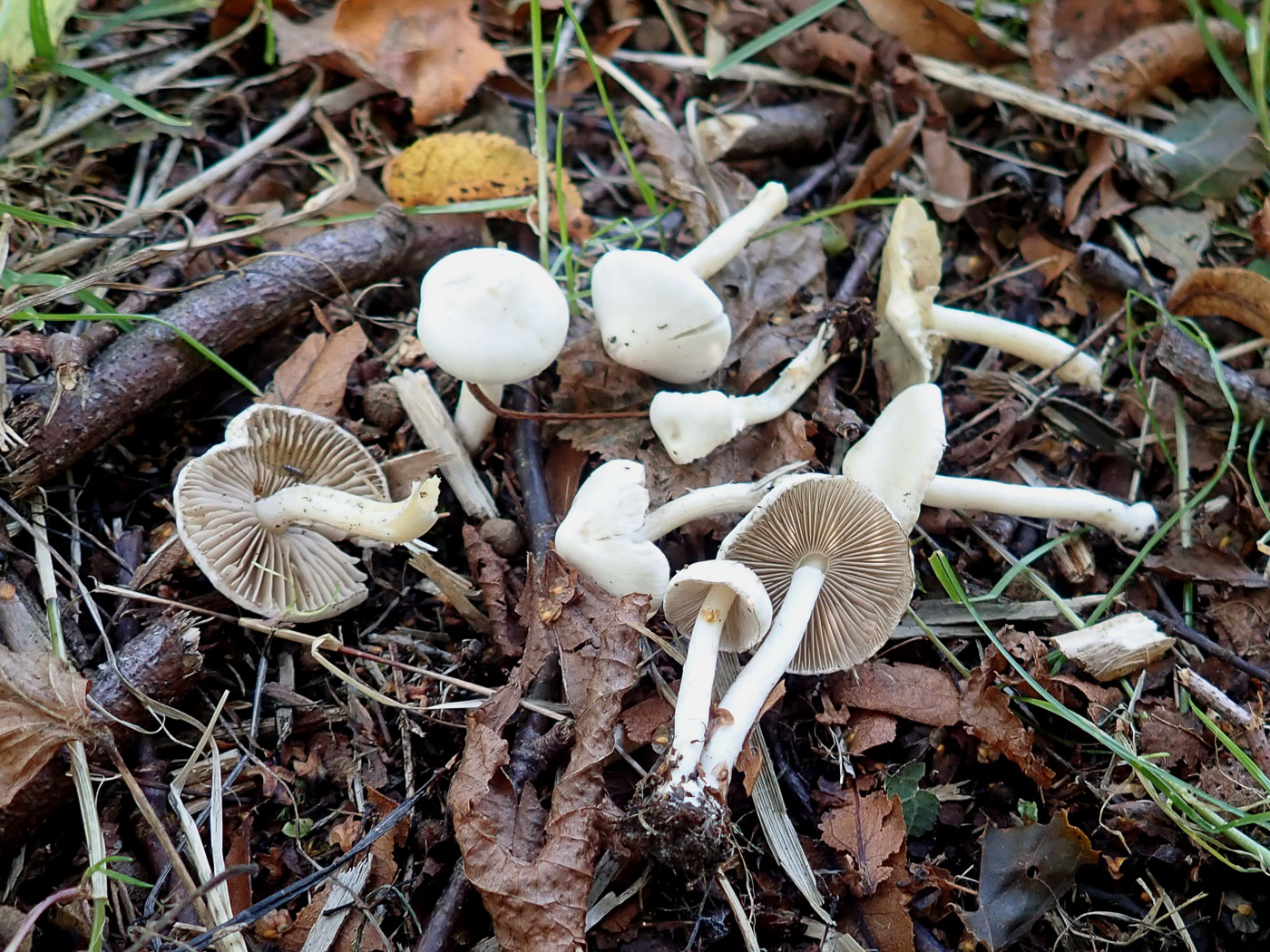
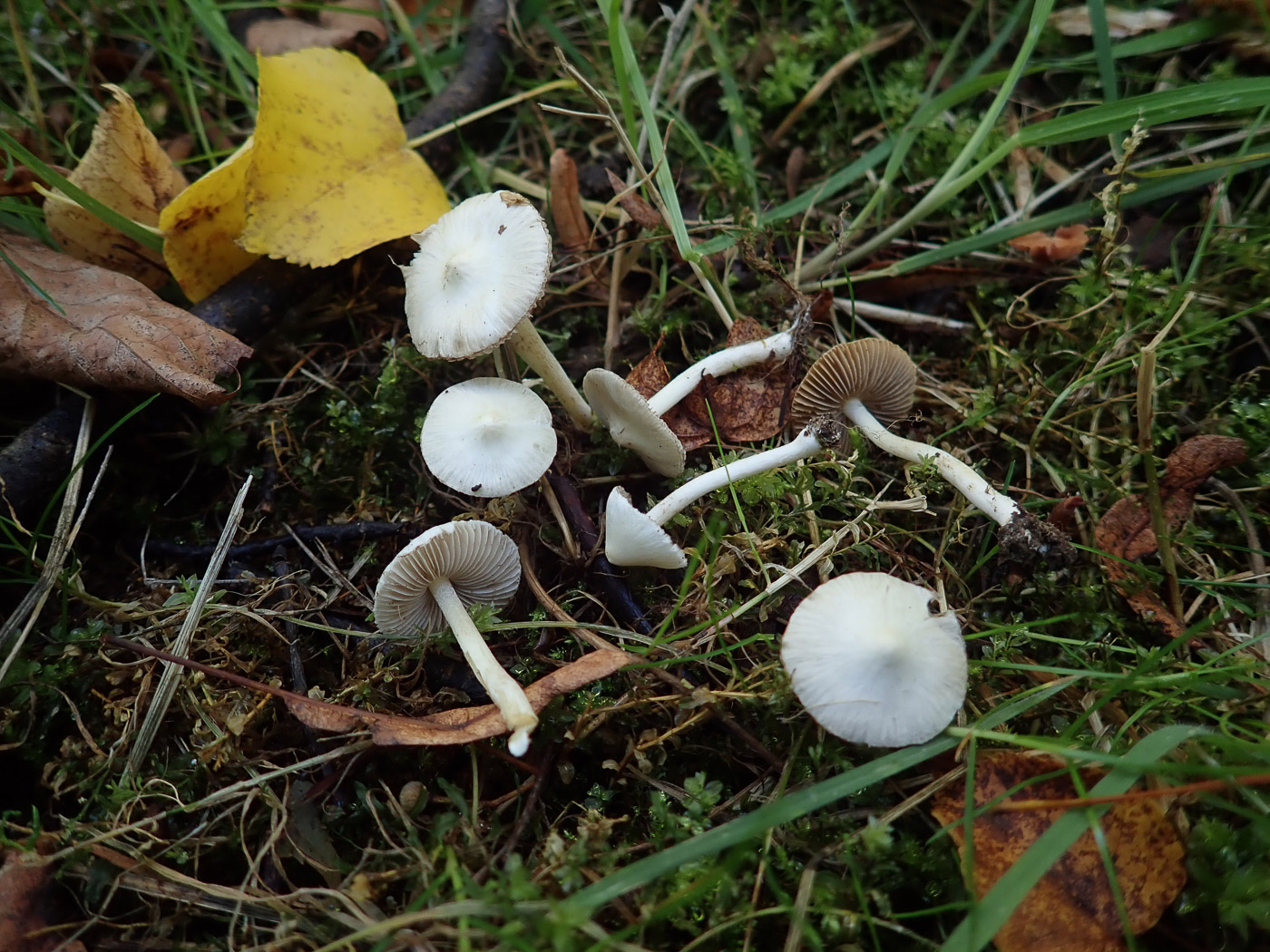
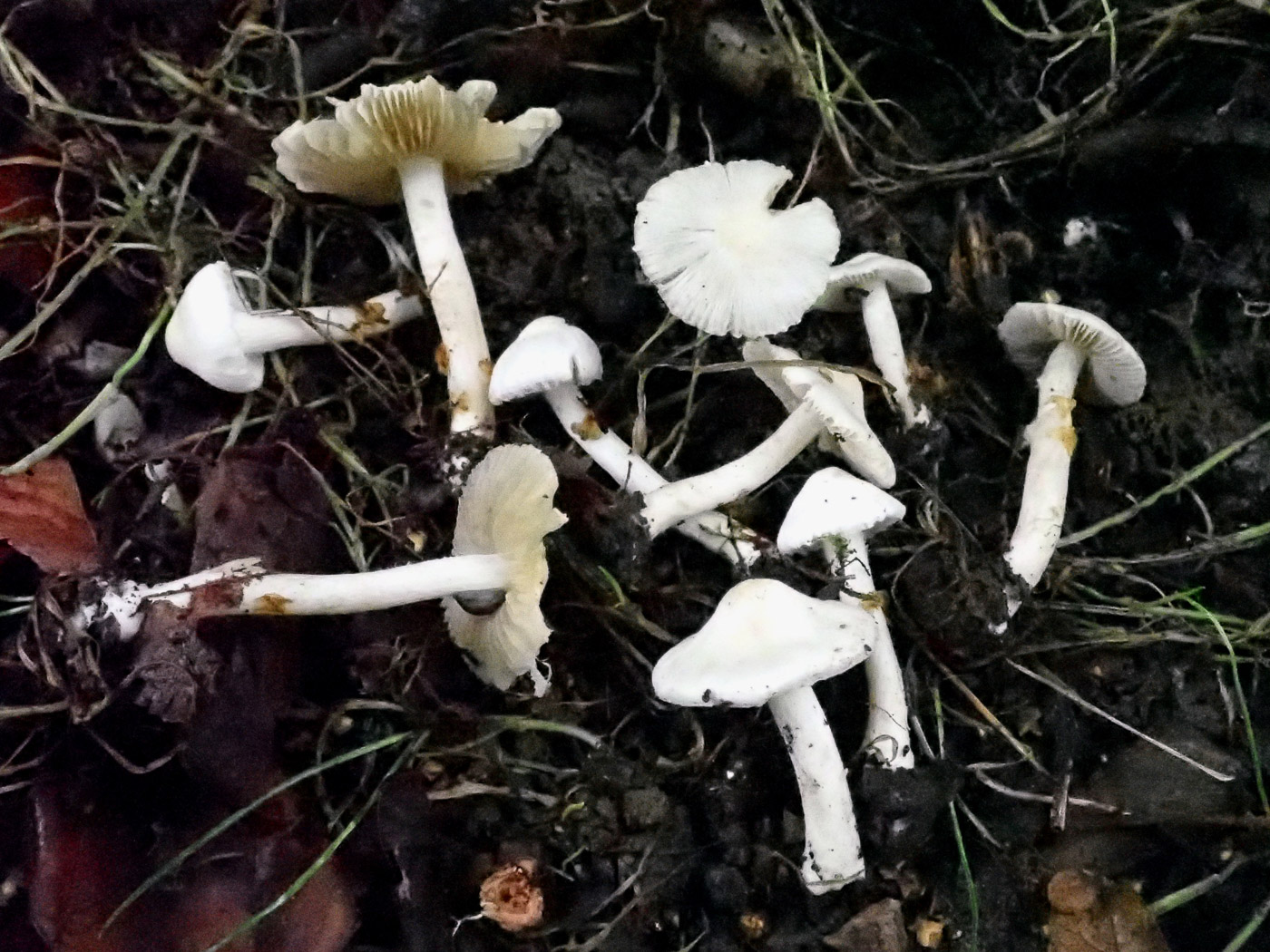

|
Inocybe geophylla (White Fibrecap) 
Nov 15, 2023. Under Pine at Prestwood Churchyard Penny came across good number of a white Fibrecap and, realising that this might well be something different now that DNA in recent years has shown there to be quite a few separate white Fibrecap species, she made a collection to get sequenced. Not only do these species look pretty well identical but their microscopic characters are also extremely similar, rendering sequencing the safest way make a determination to species. Gone are the days of naming these white lookalikes to species either in the field or in the lab!
Sep 26, 2023. Under Lime at Turville Heath Penny made a sizeable collection of this Fibre cap with a view to getting it sequenced. Recent years have revealed that what we recorded previously as I. geophylla is in fact a complex of several species now newly described but so similar to each other that determining to species needs DNA confirmation to be really sure. Last year a collection from this site turned out to be the new I. miranda and today's collection is very likely to be the same again. This entry will be updated once results are back from sequencing.
Oct 6, 2022. In the Lime avenue at Turville Heath the list of Fibrecap species is growing - every time Penny visits something different turns up but this common white species is often present in good numbers. It associates with a many different trees, including conifers, but both this and the closely related I. lilacina (Lilac Fibrecap) seem to fruit abundantly under Lime.
Oct 5, 2021. In Turville Heath Penny found several collections of this species just starting to emerge under the many Limes. It is the only common white Fibrecap (though there are a few others which, however, rarely seem to appear in this area) but until the mature gills reveal their buff brown colour (they are almost white at first) one could mistake this for several other small pale to white gilled white mushrooms. Most Fibrecaps have a distinctive smell described as spermatic which can often confirm the genus if in doubt.
Oct 1, 2020. This, one of the commonest Fibrecaps, was growing in troops under Limes today at Turville Heath, found by Penny Cullington. A small species with caps under 3 cm across at most, it is easily mistaken for perhaps one of the white capped Hygrophorus species (Woodwaxes) or a small white Tricholoma (Knight) until one turns a fruitbody over and sees the typical gill colour of the genus: beige to buff when young then gradually darker snuff brown when mature. (Woodwaxes and Knights have white gills.) It is not the only white-capped Fibrecap but others are extremely rare. It occurs under many different deciduous trees.
|
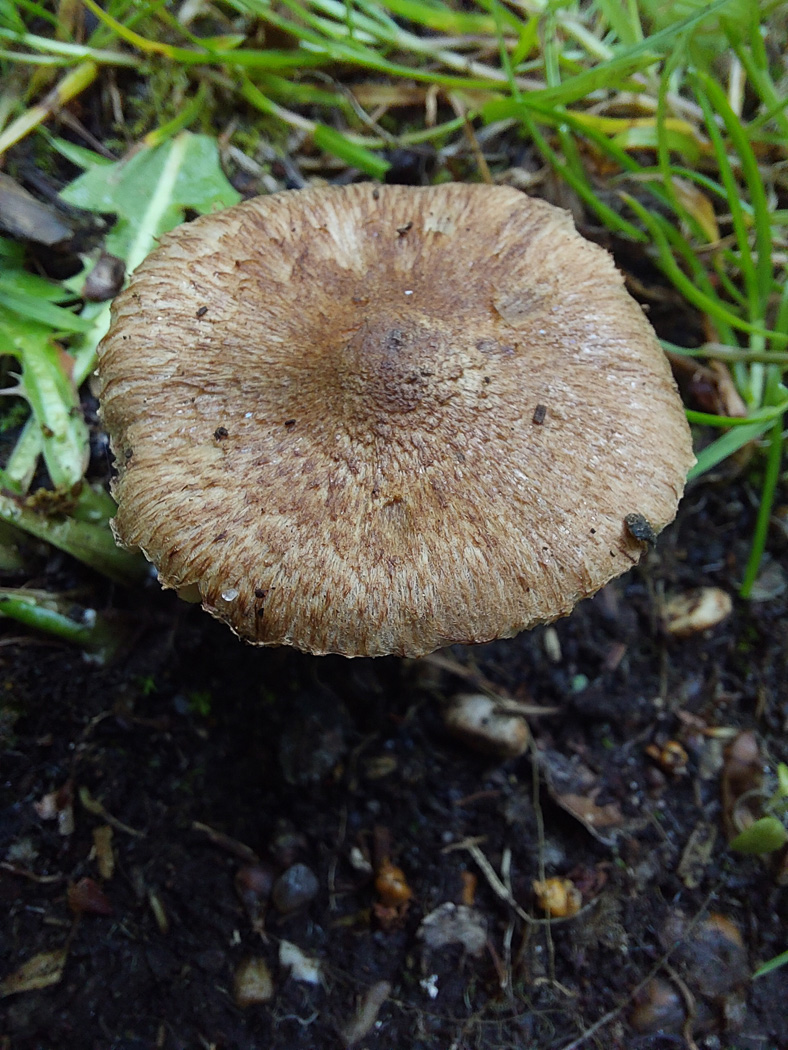
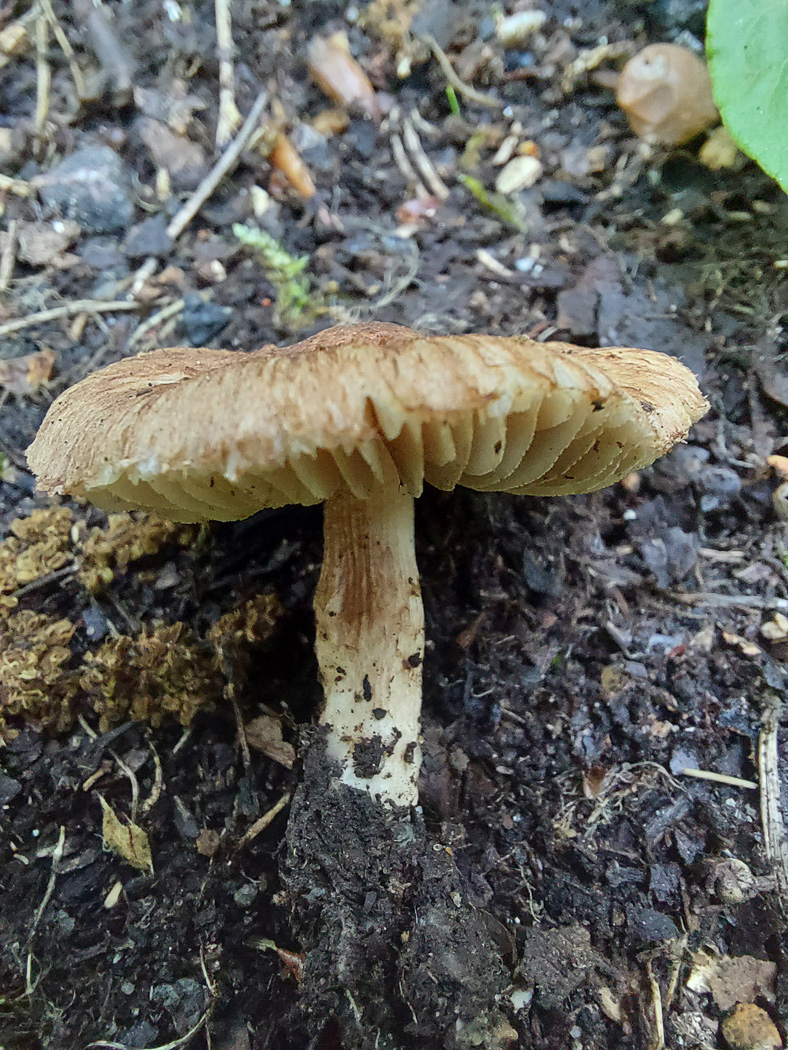 |
Inocybe glabripes (a Fibrecap with no common name) 
May 8, 2023. Under a mix of deciduous trees in Gerrards Cross Jesper Launder found this singleton Fibrecap - certainly a surprise to find this genus of LBJs fruiting in Spring. The material was then identified by Penny though the more appropriate name I. microspora is preferred by some authors (including Penny) and it does indeed have very small spores for the genus. This is an occasional species and a first for Finds, previously our earliest record being from August.
|
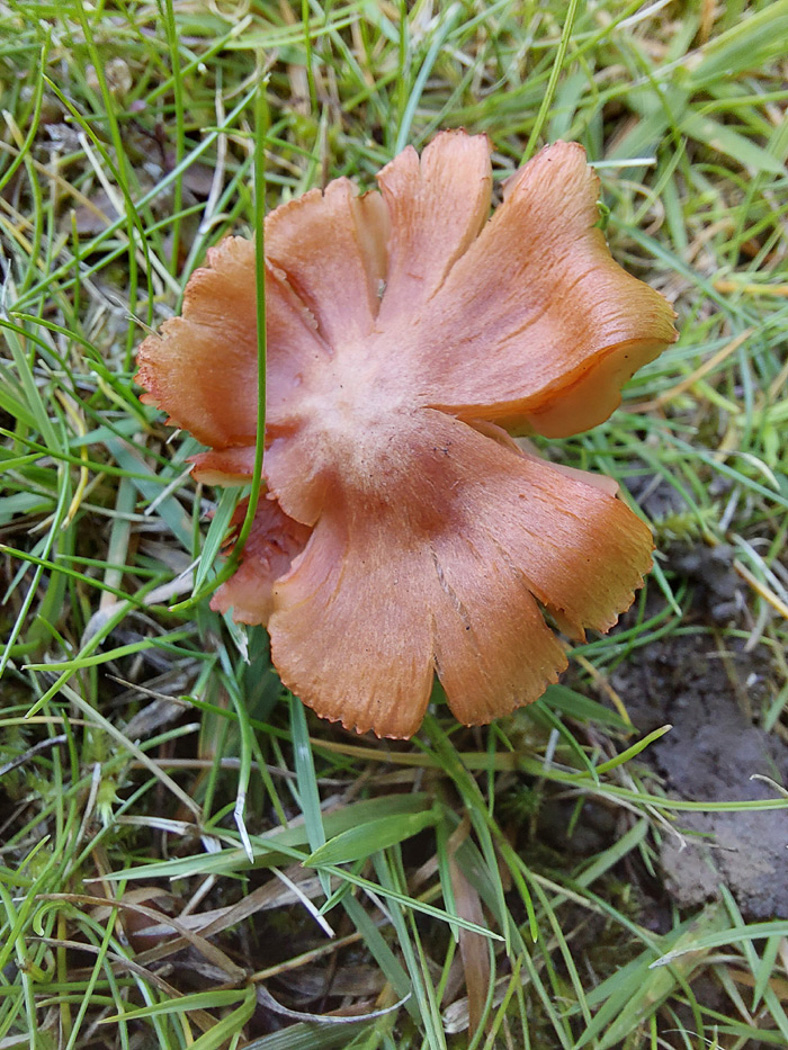
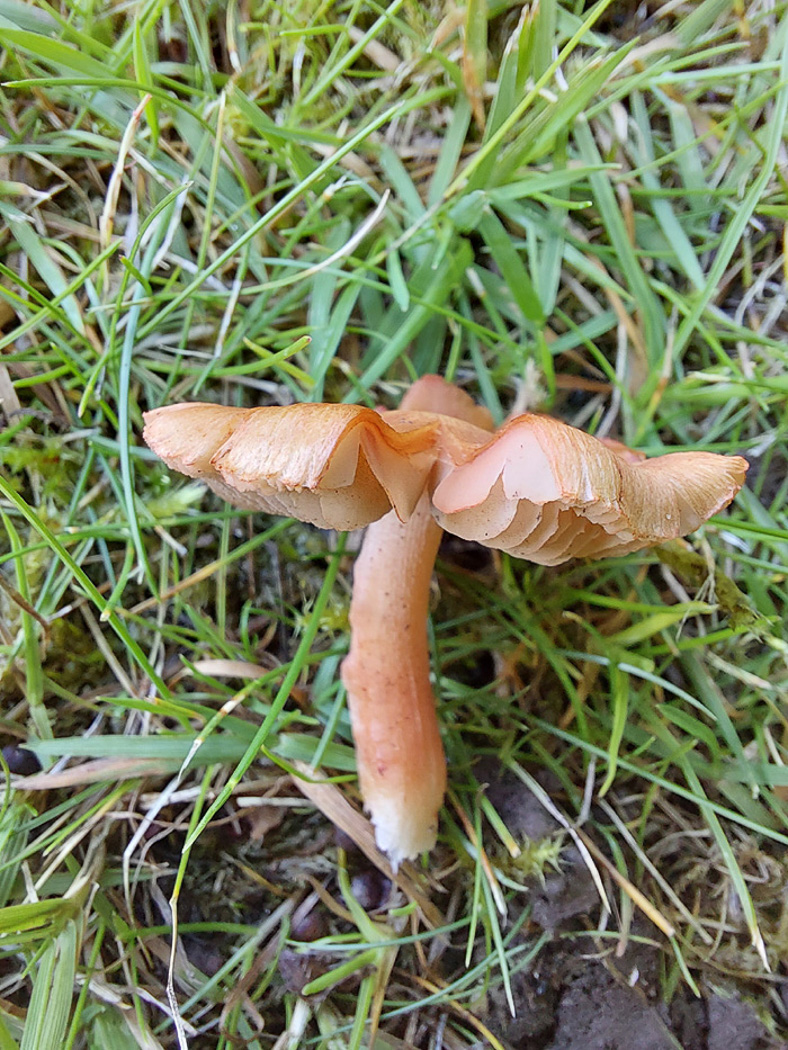
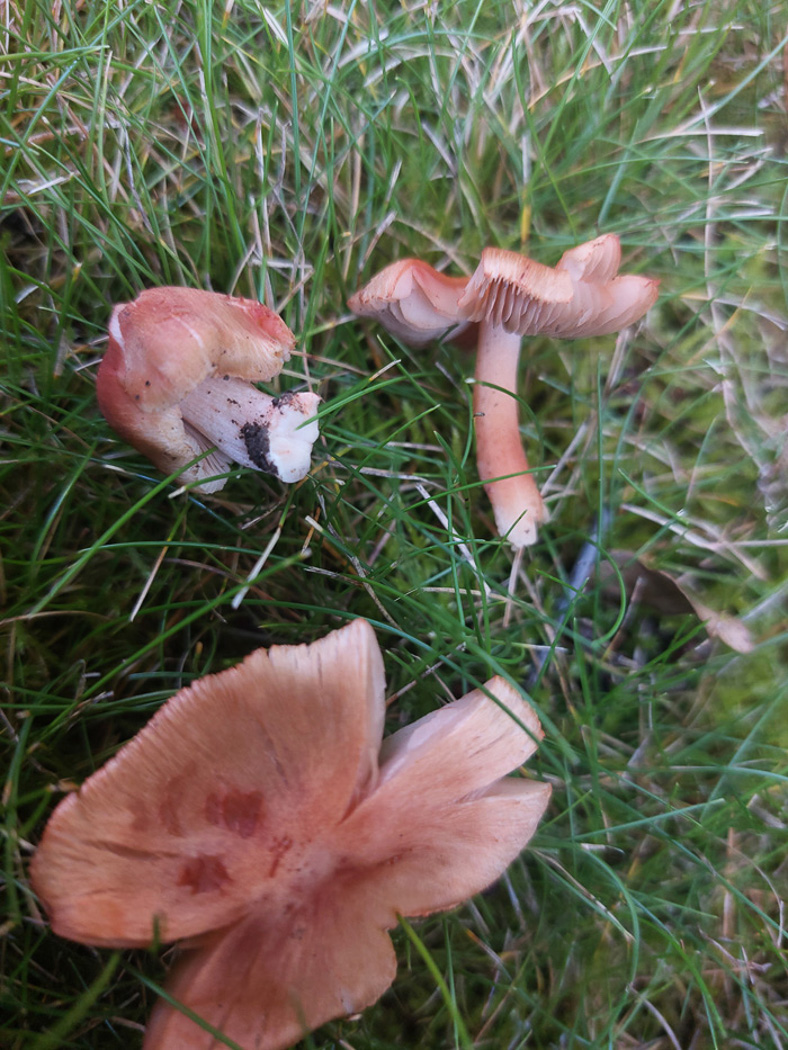 |
Inocybe godeyi (an unusual Fibrecap with no common name) 
Aug 6, 2023. At our microscope workshop Jesper Launder showed Penny this strongly reddening Inocybe he'd found three days earlier in Seer Green under Oak and Birch which had been puzzling him. By the time she saw it it had reddened considerably more than in his photos though strong signs can clearly be seen here. She recognised it instantly though one of the key features of the species was missing from the broken stems: it has a 'marginately' bulbous base (ie with a distinct rim to it). Once informed of this he then keyed it out without difficulty. I. godeyii starts out entirely pale buff / cream but ends up entirely reddish when old even without damaging - though this encourages the reddening. It occurs under various deciduous trees and the bulbous base together with microscopic characters should make it quite simple to distinguish from the handful of other reddening Fibrecaps. We have plenty of county records but only from a handful of sites, today's being a new one. It is also a new Finds entry.
|
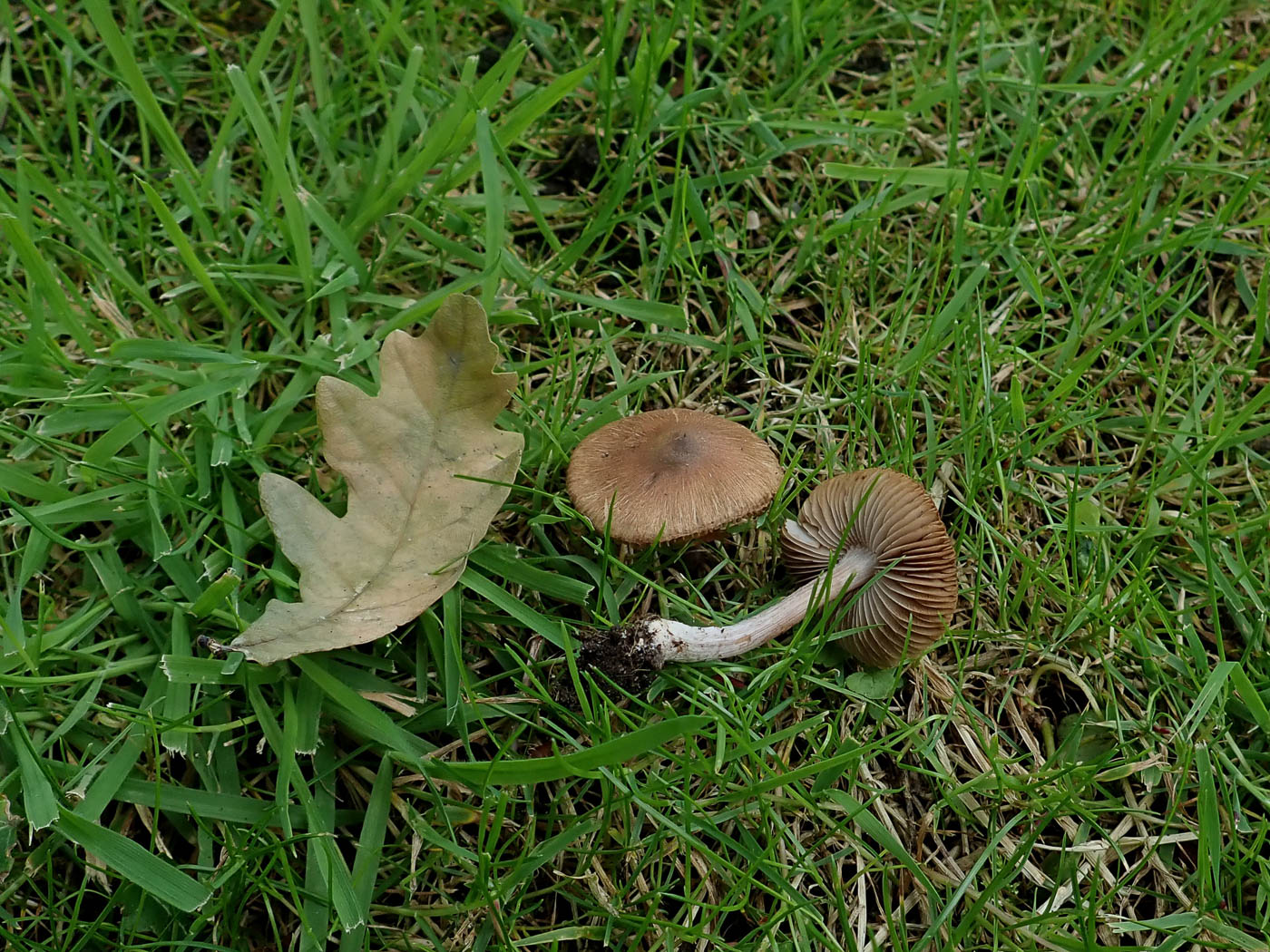
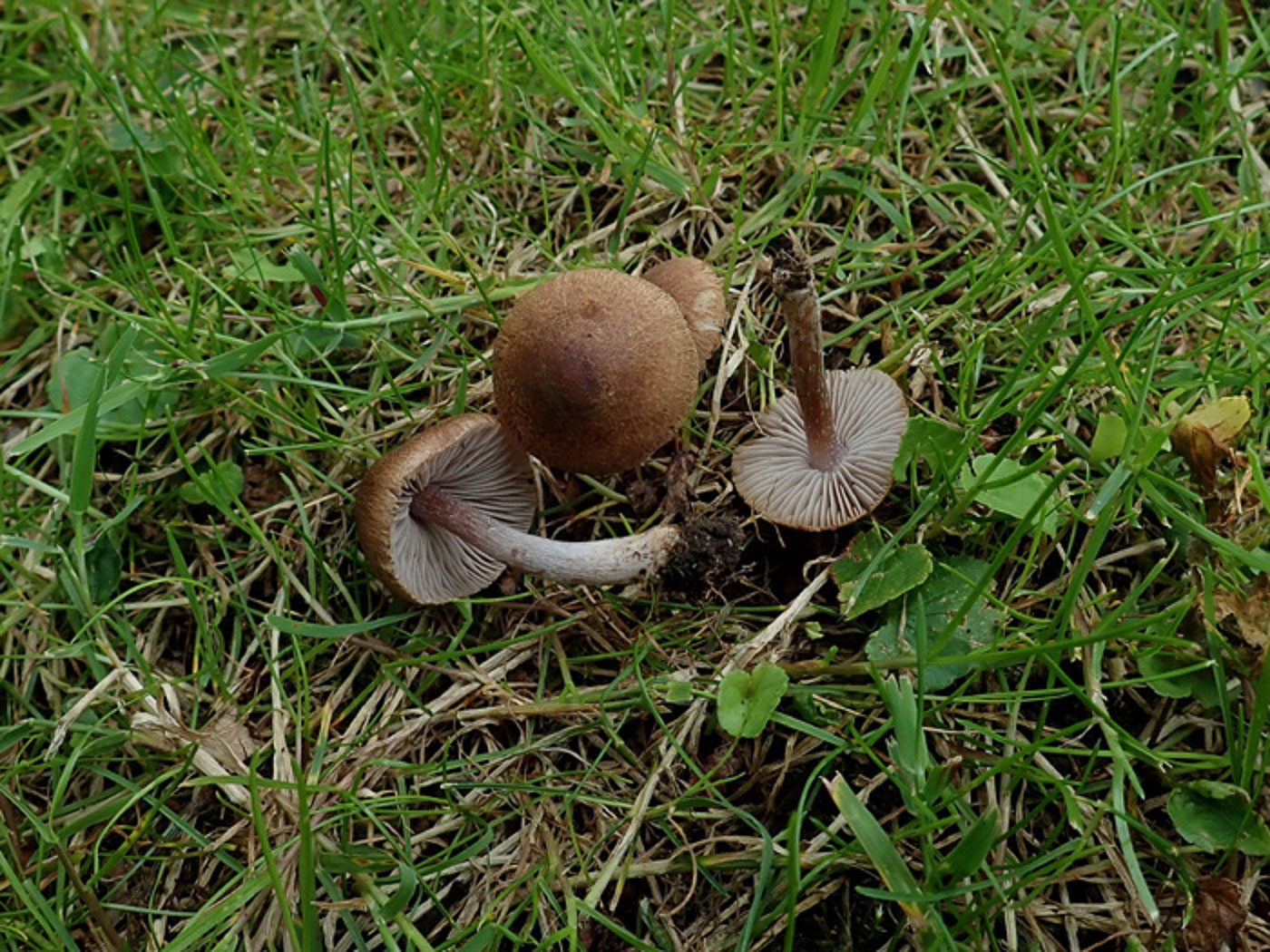
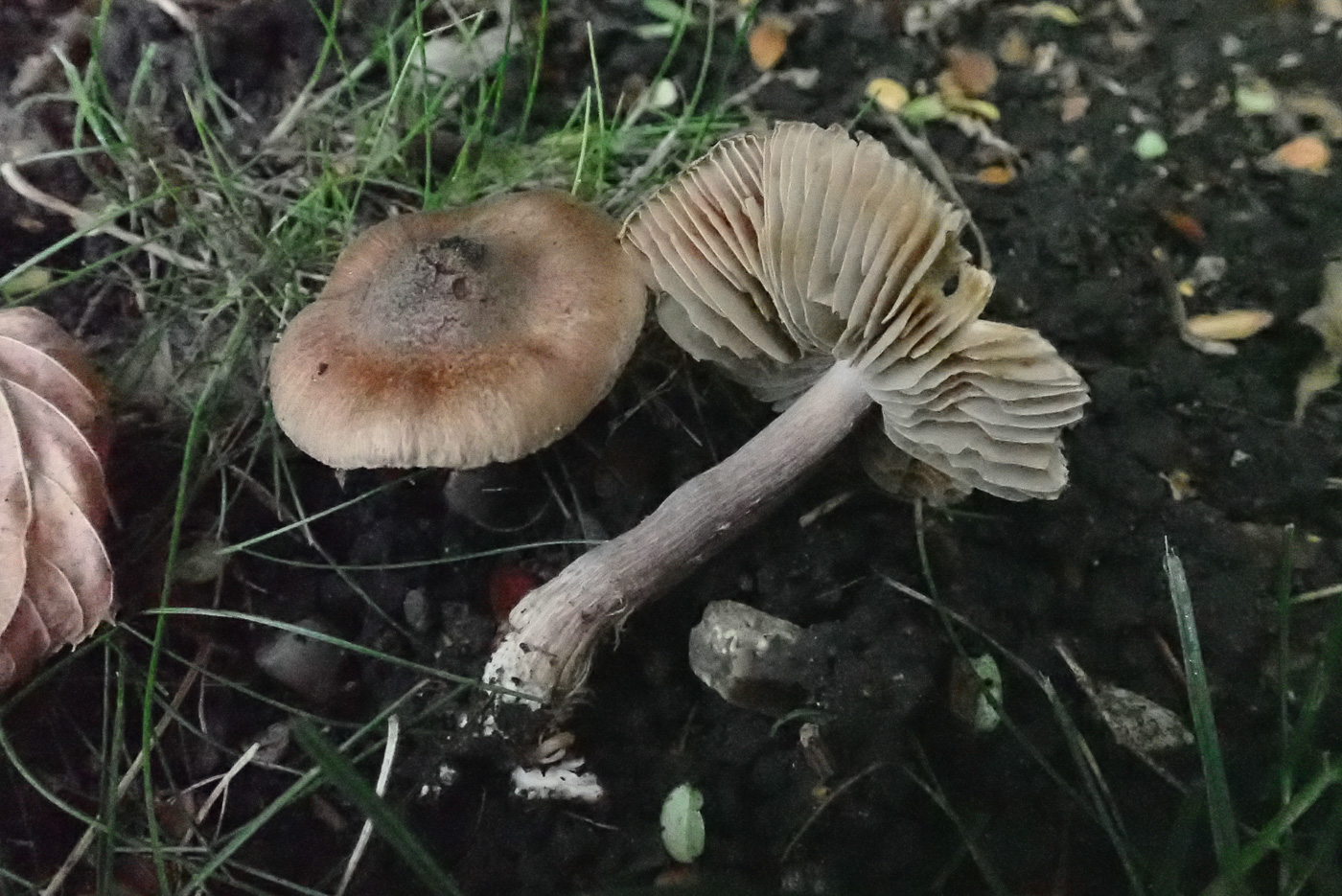 |
Inocybe grammopodia (a very rare Fibrecap with no common name
Jul 30, 2023. In a grassy verge under Oak at Turville Heath Penny found two collections a foot apart of this typical dark brown capped Fibrecap LBJ. Working on them at home, she eventually was happy that both collections were (a) the same species and (b) very probably the first genuine Bucks collection of I. grammopodia, making this only the fourth UK collection (once confirmed as correctly identified when sequenced). See Oct 30, 2021 when the species was new to the UK with two collections from Penny's garden which, however, is just over the border into Oxfordshire (hence a little licence was taken to include it in Finds!). It also fruited there again just a week ago - the third collection - when nearly destroyed by Paul's mower!
Oct 30, 2021. Back in July a singleton Inocybe turned up in Penny's garden under Lime which she didn't recognise and couldn't key out. The specimen was dried and sent for sequencing, the result being an exact match with that for I. grammopodia, not previously found in the UK. To her delight, two more fruitbodies popped up in exactly the same spot and were found today - in fact were nearly mown over by Paul who luckily noticed them in the nick of time! What a lucky chance!
|


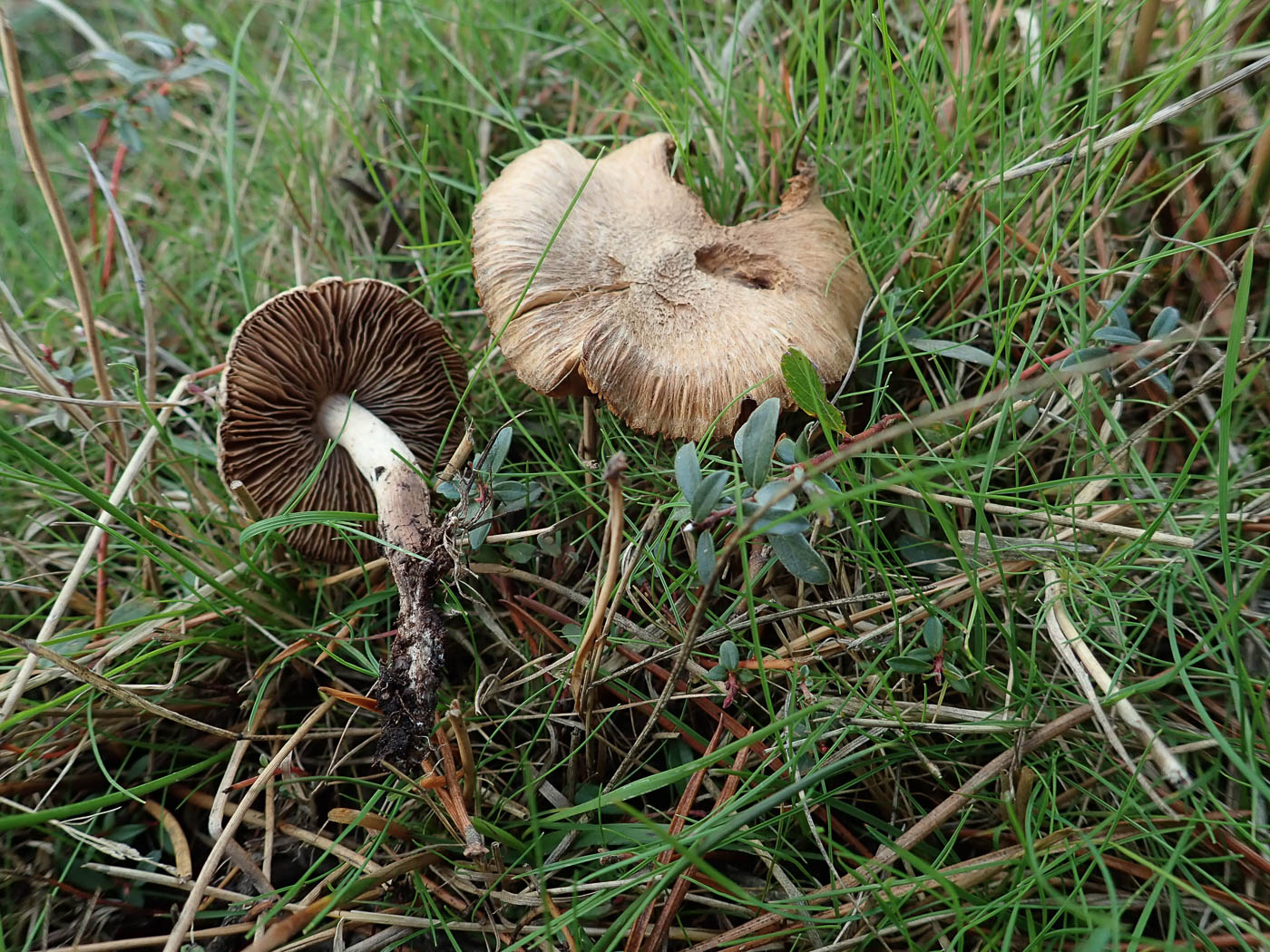
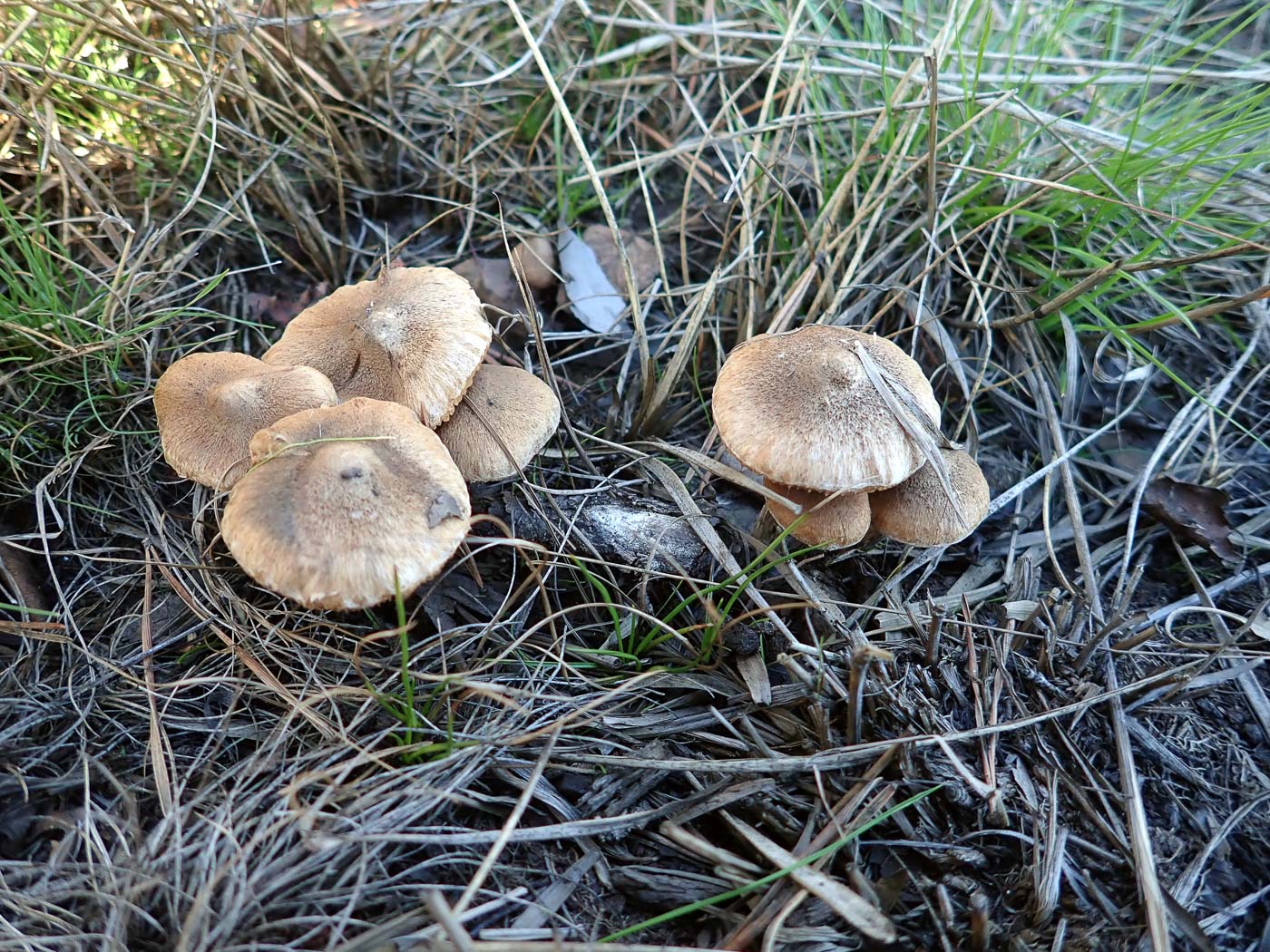
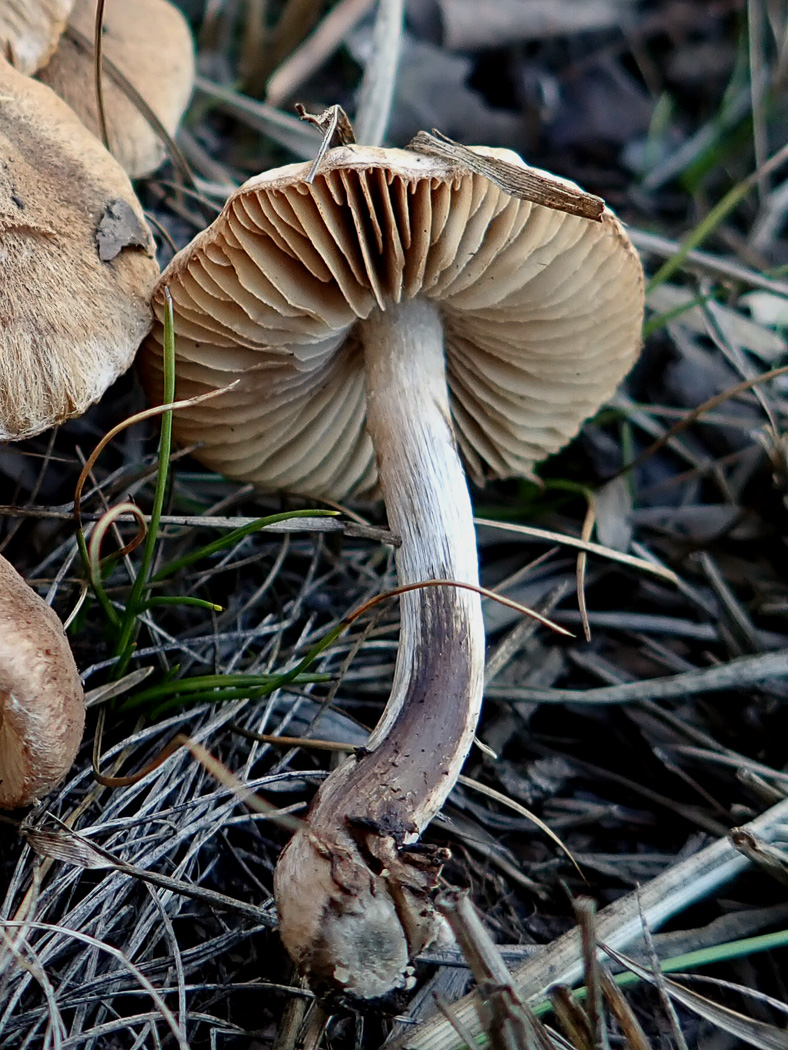 |
Inocybe lacera (Torn Fibrecap) 
May 3, 2024. In Burnham Beeches (possibly under under Oak) Jesper Launder found this singleton Fibrecap and noticing the distinctly scaly cap surface wondered if it was this species which we'd found just last week at Stoke Poges Memorial Gardens. So later checking the unusual spore shape - more or less unique to this particular Fibrecap - was enough to confirm its ID. The species prefers acidic soils such as found in this area and can be particularly prolific at Stoke Common where we have records through from May to November. See further comments in our one previous entry.
Sep 29, 2022. At Stoke Common Penny was very pleased to see this particular Fibrecap species - one which occurs in few Bucks sites but can be really prolific here. It favours acidic soil and associates with Birch, Pine or Willow, here with the plentiful Prostrate Willow - an unusual plant in the county and seen in photo 1. The two photos show two separate collections which, though looking pretty similar, appear to have rather differently shaped spores, and as I. lacera is a known complex of species it will be interesting to get them sequenced. (We already have one found here new to the UK.) A useful field character of this complex is its stem which stains dark brown when rubbed (see photo 3). The species is a new entry for Finds.
|
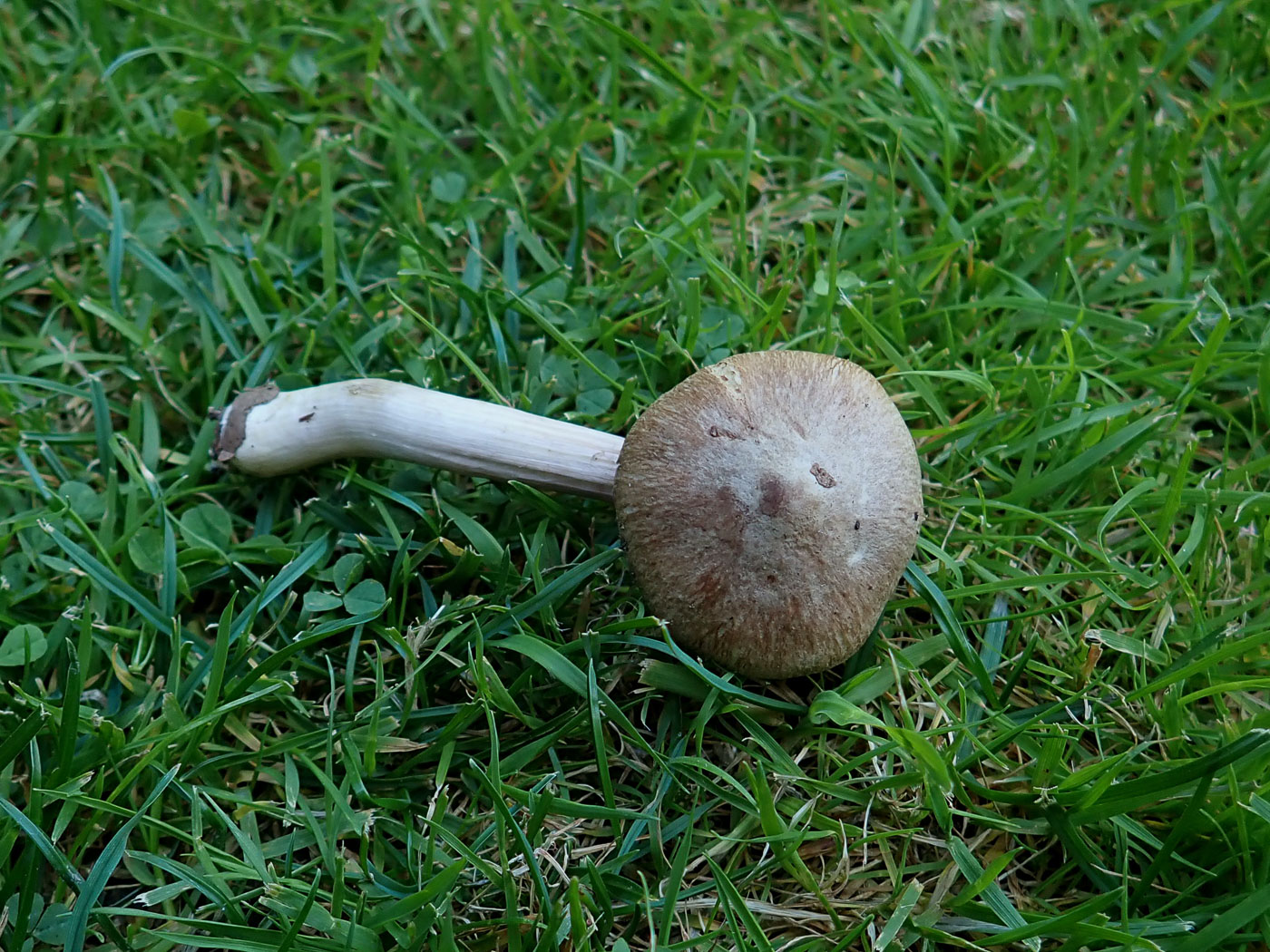
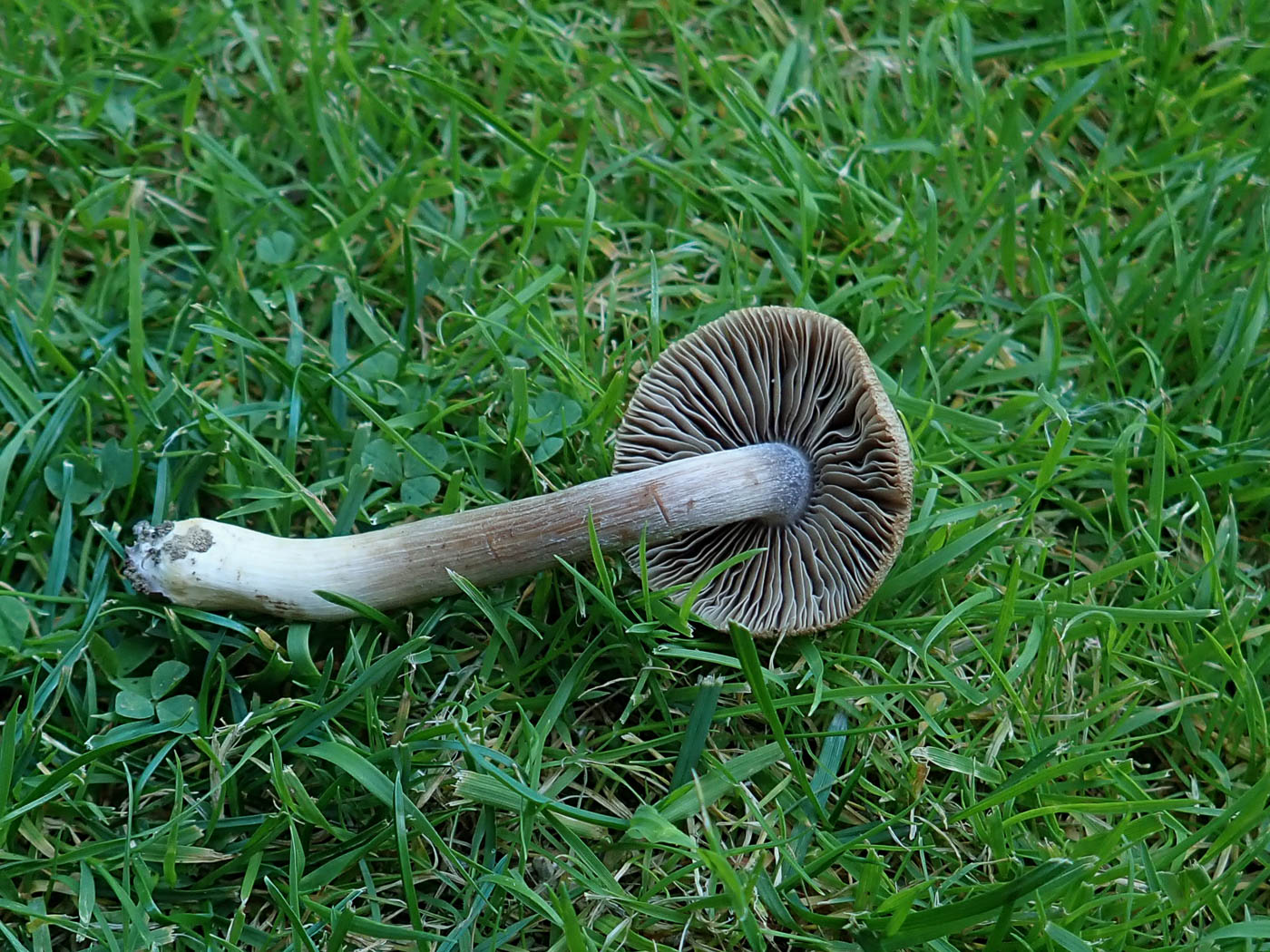 |
Inocybe lavandulochlora (a very rare Fibrecap with no common name) 
Aug 8, 2023. At College Lake Penny and Paul picked up this singleton Fibrecap under Beech but Penny didn't have time to to examine it until two days later when she realised it was something special, so then took the photos on her lawn at home. The buff brown cap was about 2 cm across and the stem apex was distinctly lavender / violet (as was the flesh inside), streaky brown in the middle though clearly pale cream at the base. The species was only recognised as British when a collection of hers from Wales (misidentified back in 2011) was eventually sequenced as this - a species not included in any available keys. Since then further sequencing has produced one or two more collections - one from Bucks - but she suspects this will be the first identified through macro and micro characters, though this will also need to be sequenced to confirm.
|
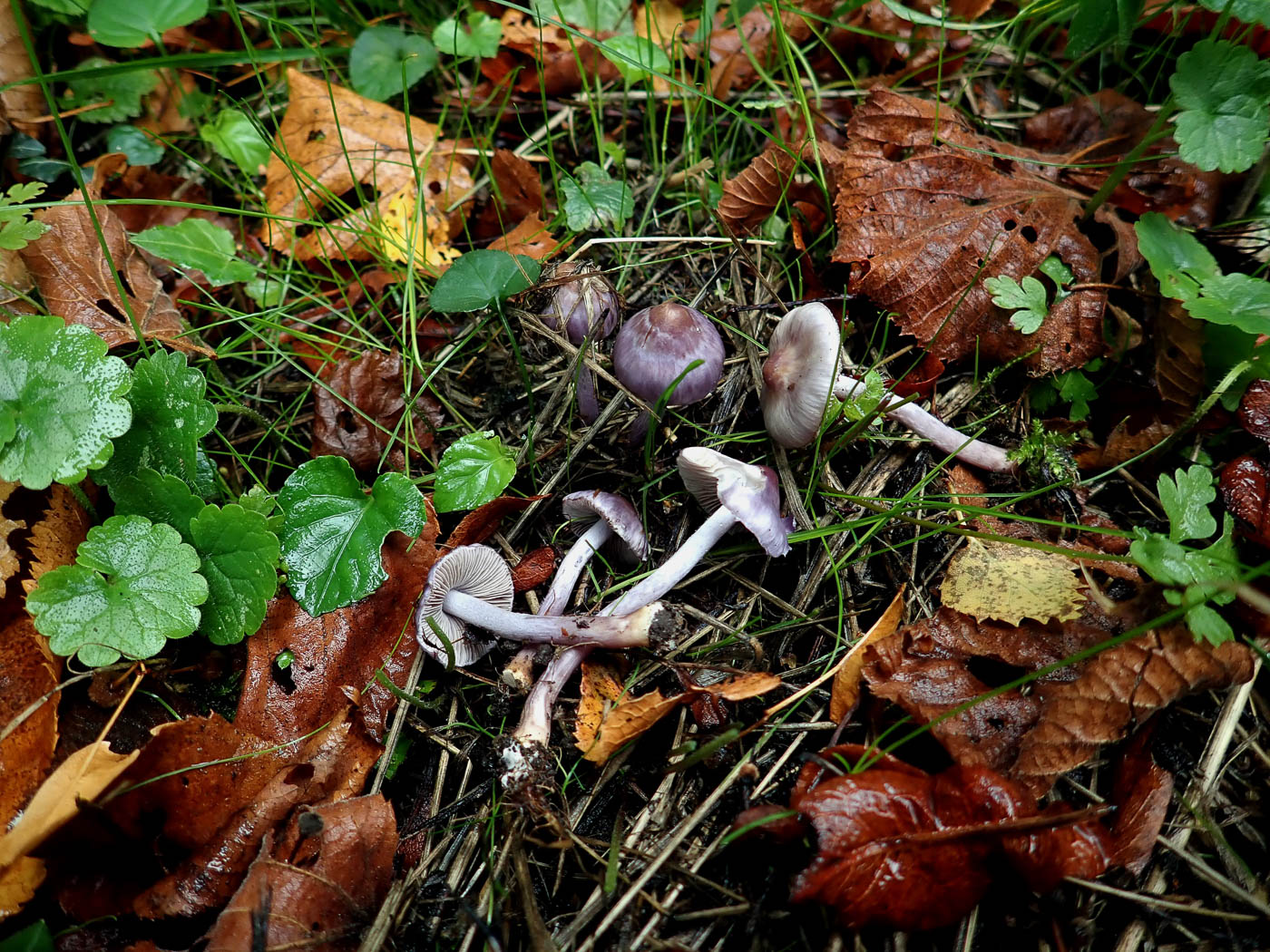
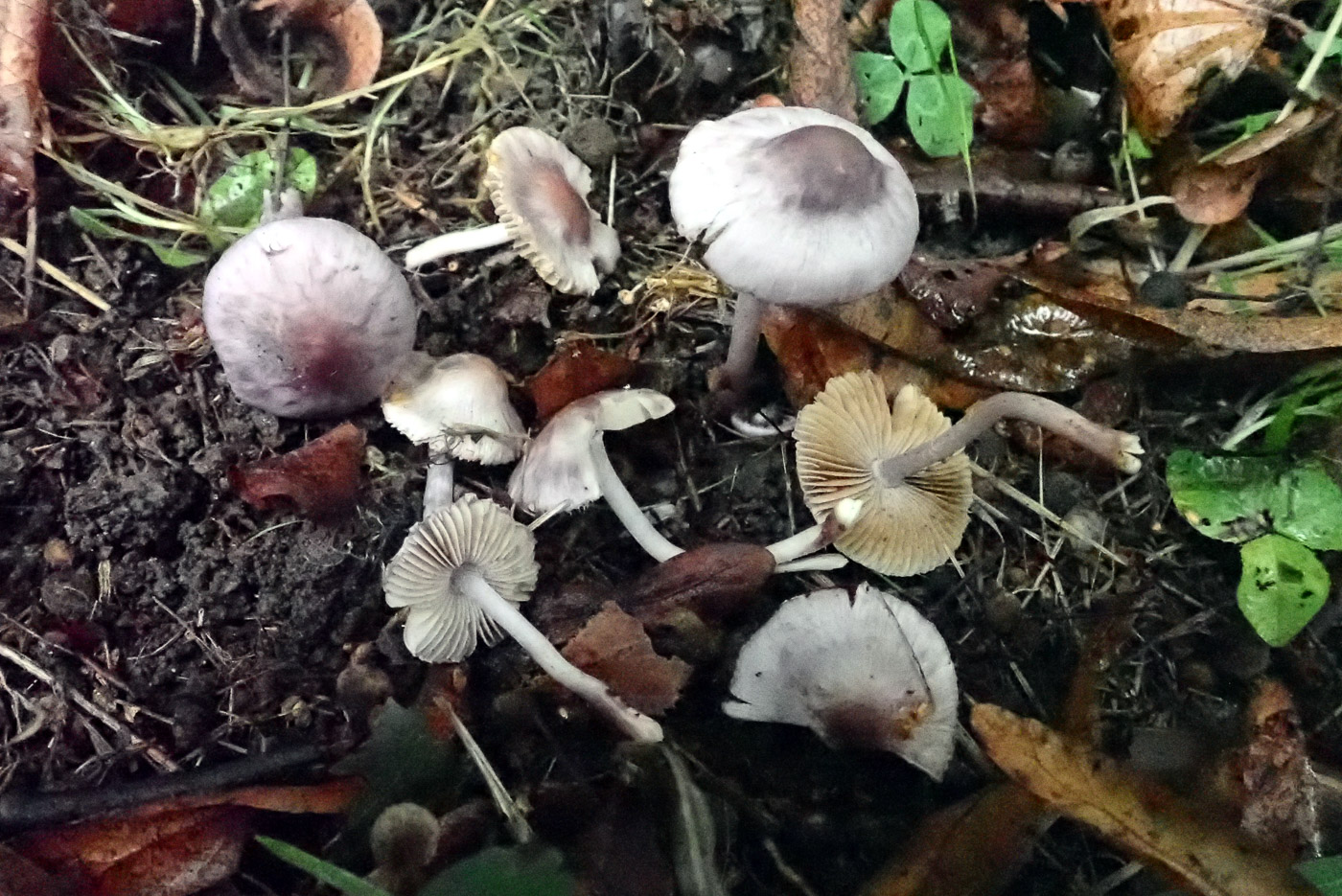
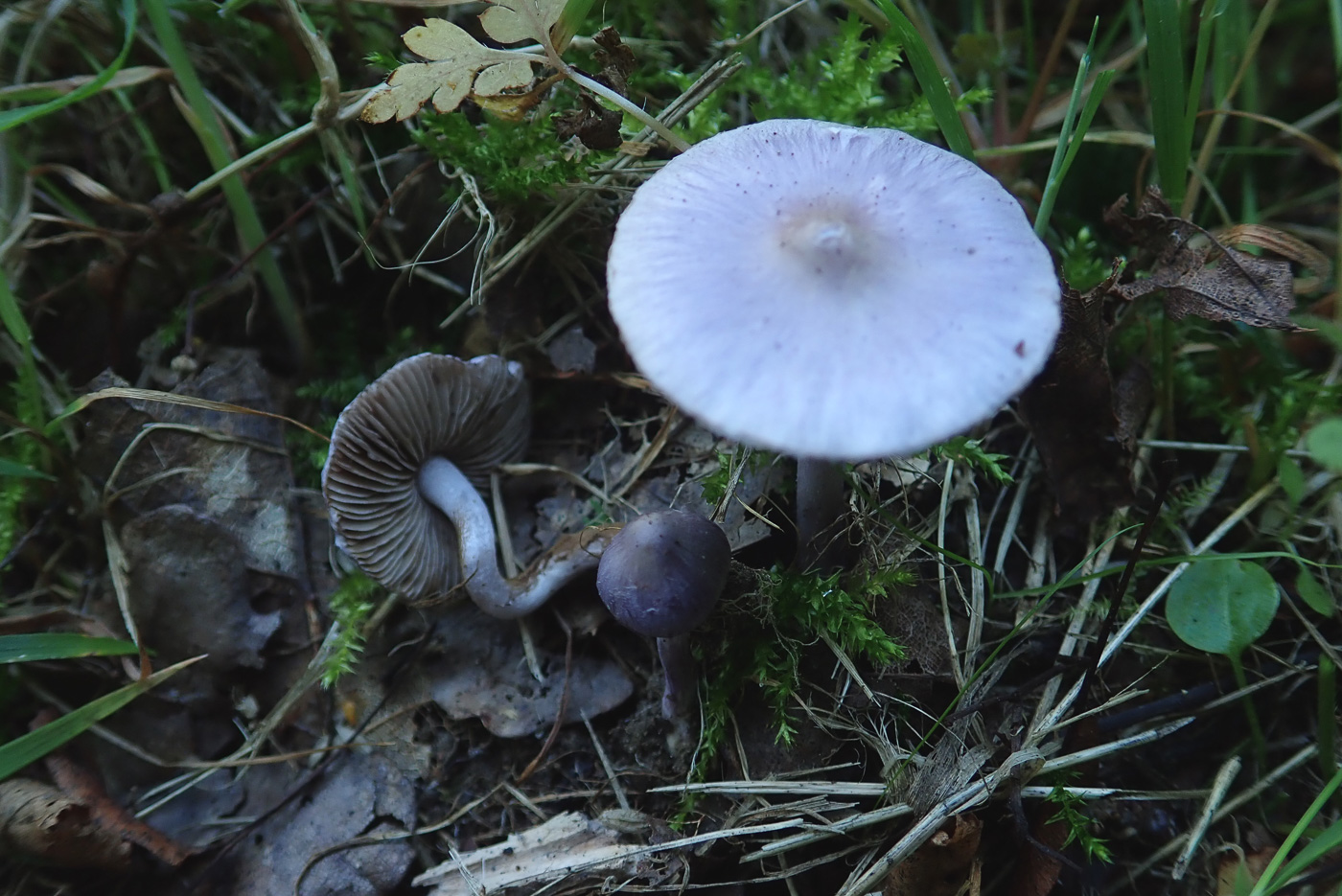
|
Inocybe lilacina (Lilac Fibrecap) 
Oct 5, 2021. In Turville Heath Penny found several collections of this species also just starting to emerge under the many Limes. This is another Fibrecap almost as common as I. geophylla above, in fact the two species often occur together and until recently this beautiful little lilac-capped mushroom was considered only a variety of I. geophylla. It is likely to change its name yet again in the future because we know our European species is not the same as the American I. lilacina, and is one of a complex of European lilac-capped species still to be sorted out with DNA. (Note in the photos of both species the almost white gills when immature but the darker buff brown gills when fully expanded.)
Sep 22, 2020. This attractively coloured mushroom was found by Penny Cullington in grass under Lime at Turville Heath. The lilac tones of the species could be mistaken for Laccaria laccata (Amethyst Deceiver) or possibly even Lepista nuda (Wood Blewit), but no other species has this combination of beautiful lilac cap and quite crowded brown gills. The cap rarely exceeds 3cm and the raised slightly brownish umbo in the centre is also typical. It occurs quite commonly under mixed deciduous trees.
|
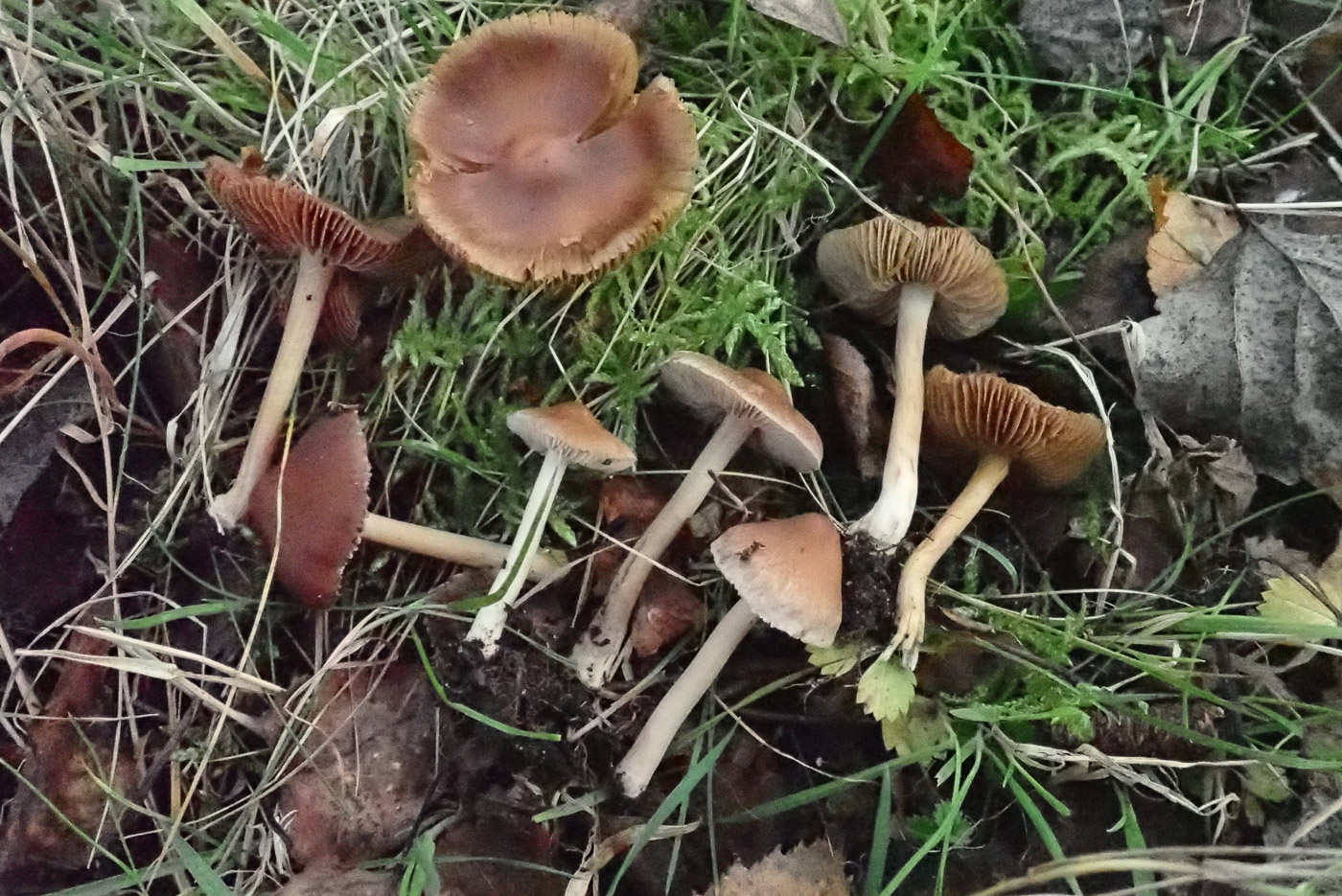
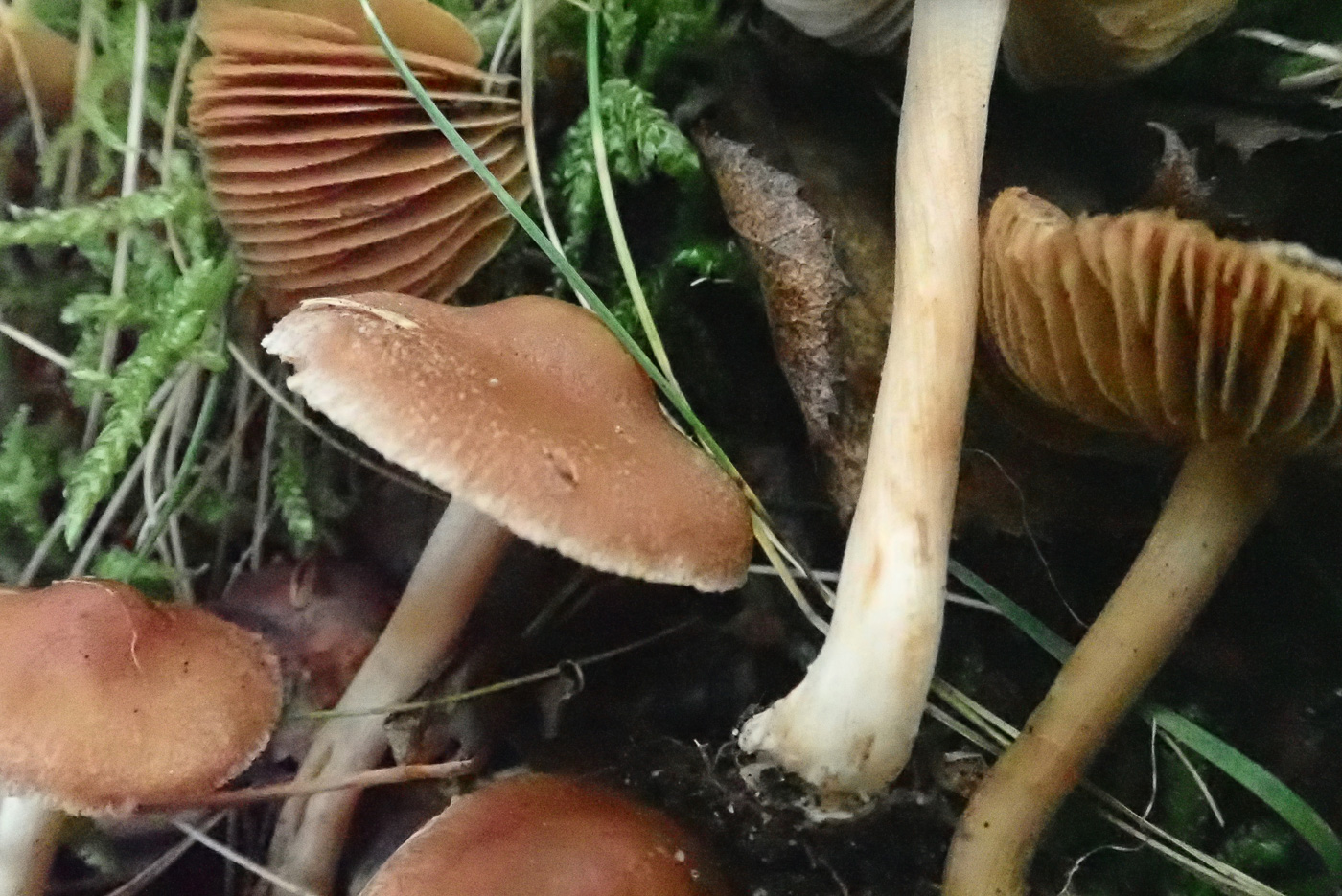 |
Inocybe lindrothii (a Fibrecap with no common name) 
Nov 9, 2021. In soil under Birch in a grassy glade at Burnham Beeches Penny found nice collections of several different mushrooms but the most exciting was this one - her target species. Last October she'd found this Fibrecap in the same glade, couldn't key it out so described and dried it and had it sequenced. It turned out to be the first UK record for the species, a member of a complex recently sorted out by European experts and apparently common in the Baltic countries under Birch. So far it's been found once since then elsewhere in the UK, so this is the third UK record - just an ordinary looking LBJ like many other Fibrecaps but she was delighted to see it again fruiting here in good numbers.
|
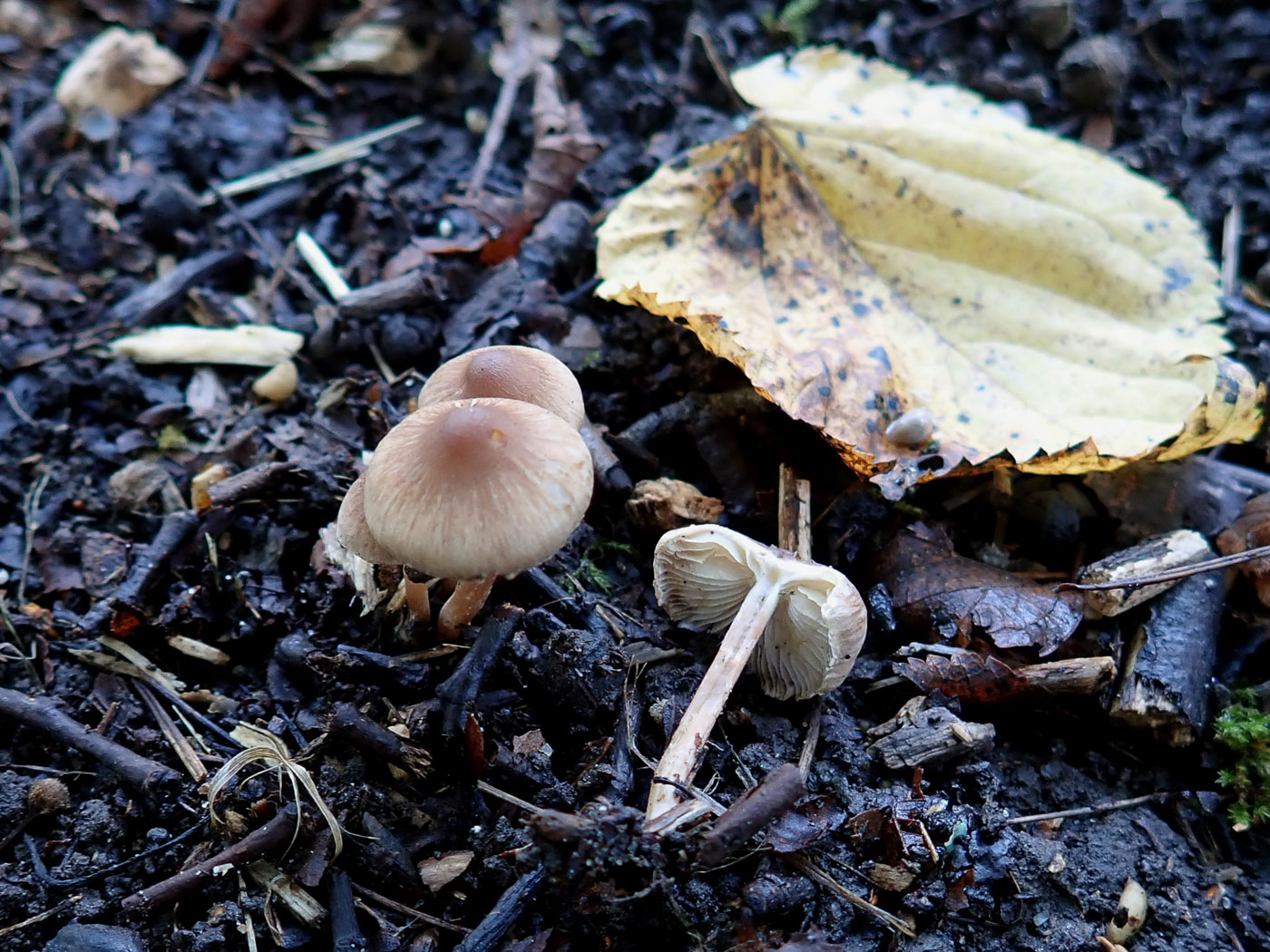
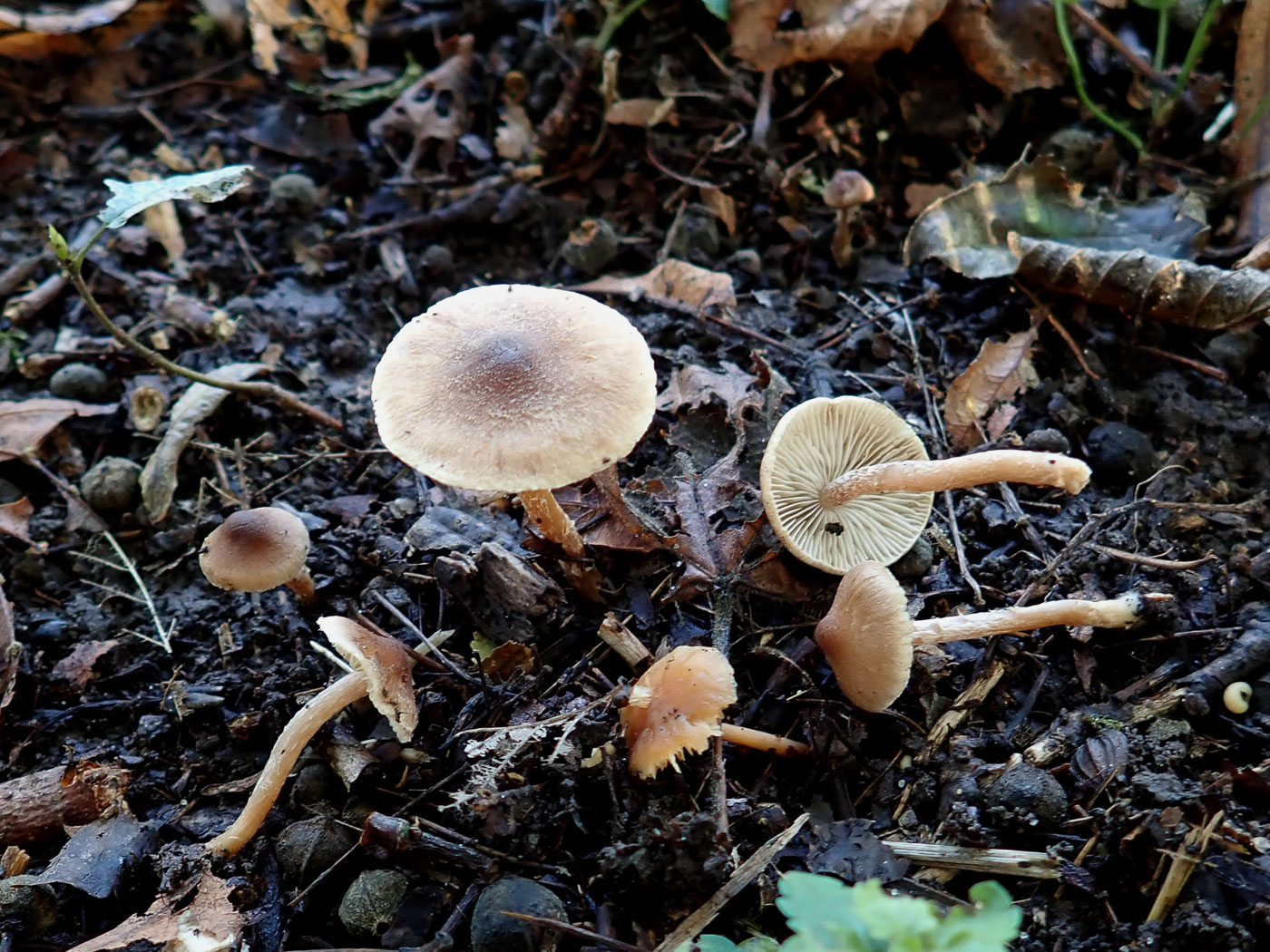 |
Inocybe microspora (a Fibrecap with no common name) 
Oct 22, 2023. In the Lime avenue at Turville Heath Penny often finds good numbers of Fibrecaps and today was no exception. This species is not that common (and new to Finds) but is a typical LBJ with no outstanding features other than fairly obviously belonging to genus Inocybe: dry dull brown radially fibrous cap - often darker in the middle with an umbo as here, pale brown gills and stem and a faintly spermatic smell. Microscopic features are key as always with this genus and, as its species name suggests, it has smooth almond shaped brown spores which are one of the smallest in the genus. The photos are of two separate collections made here today.
|

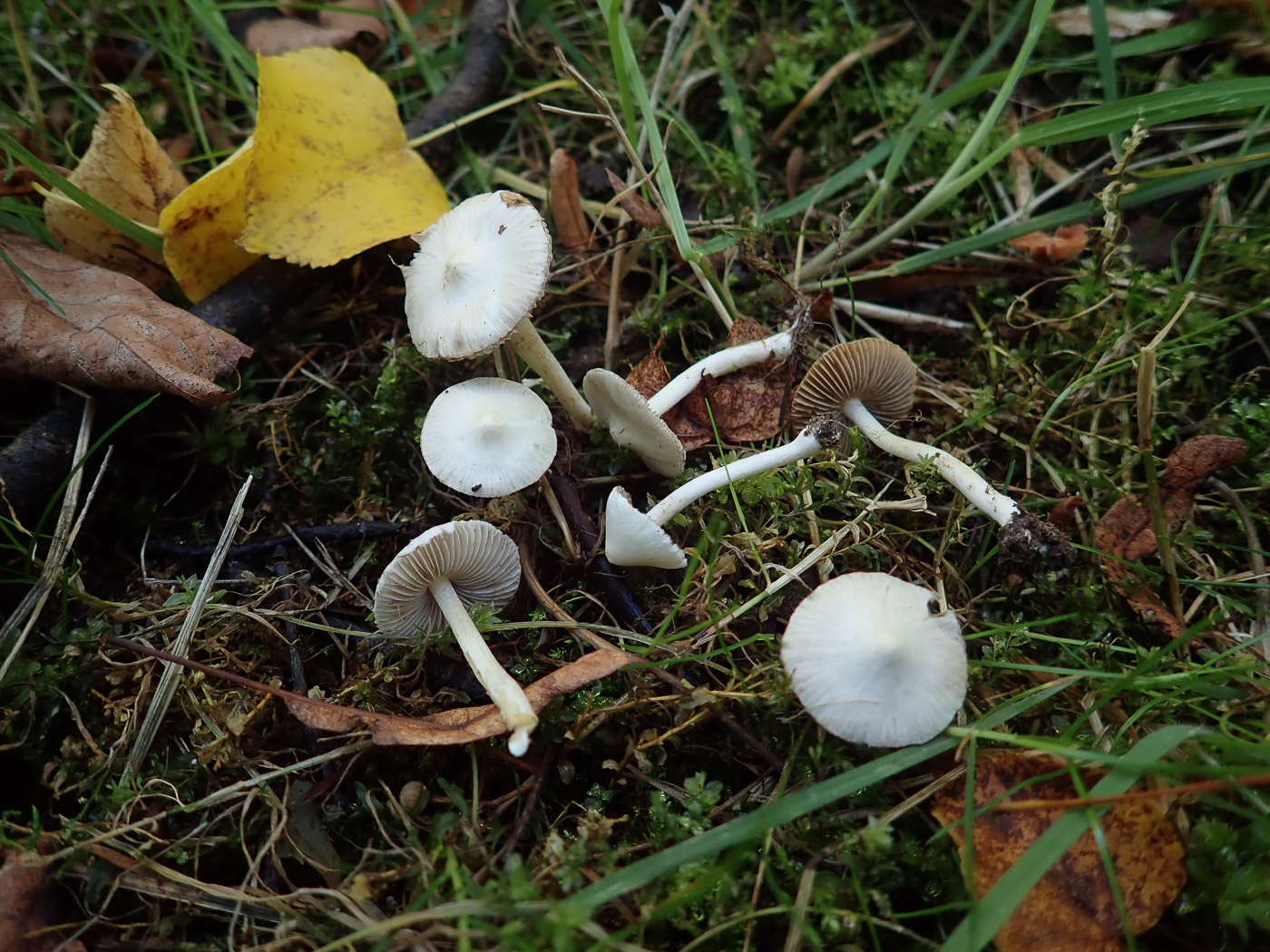 |
September 26th Inocybe miranda (a rare Fibrecap with no English name)  
Sep 26, 2023. Under Lime at Turville Heath Penny made a sizeable collection of this Fibre cap with a view to getting it sequenced. Recent years have revealed that what we recorded previously as the common I. geophylla is in fact a complex of several species now newly described but so similar to each other that determining to species needs DNA confirmation to be really sure. In 2021 a collection from this site turned out to be I. miranda, a species from this complex first described in 2013, and two separate collections made today - both also now sequenced - are confirmed as this species again.
Oct 6, 2022. In soil in the Lime avenue at Turville Heath Penny collected this white Fibrecap which appears to all intents and purposes identical (both macro- and microscopically) to the very common I. geophylla (White Fibrecap). However, knowing of the existence of several white look-alike Fibrecap species recently described from Europe, she sent today's collection for sequencing which then confirmed it as not I. geophylla but I. miranda and as such new to the county with only one previous UK record. With the knowledge available so far about this species she defies anyone to recognise it as different from I. geophylla without recourse to sequencing!
|
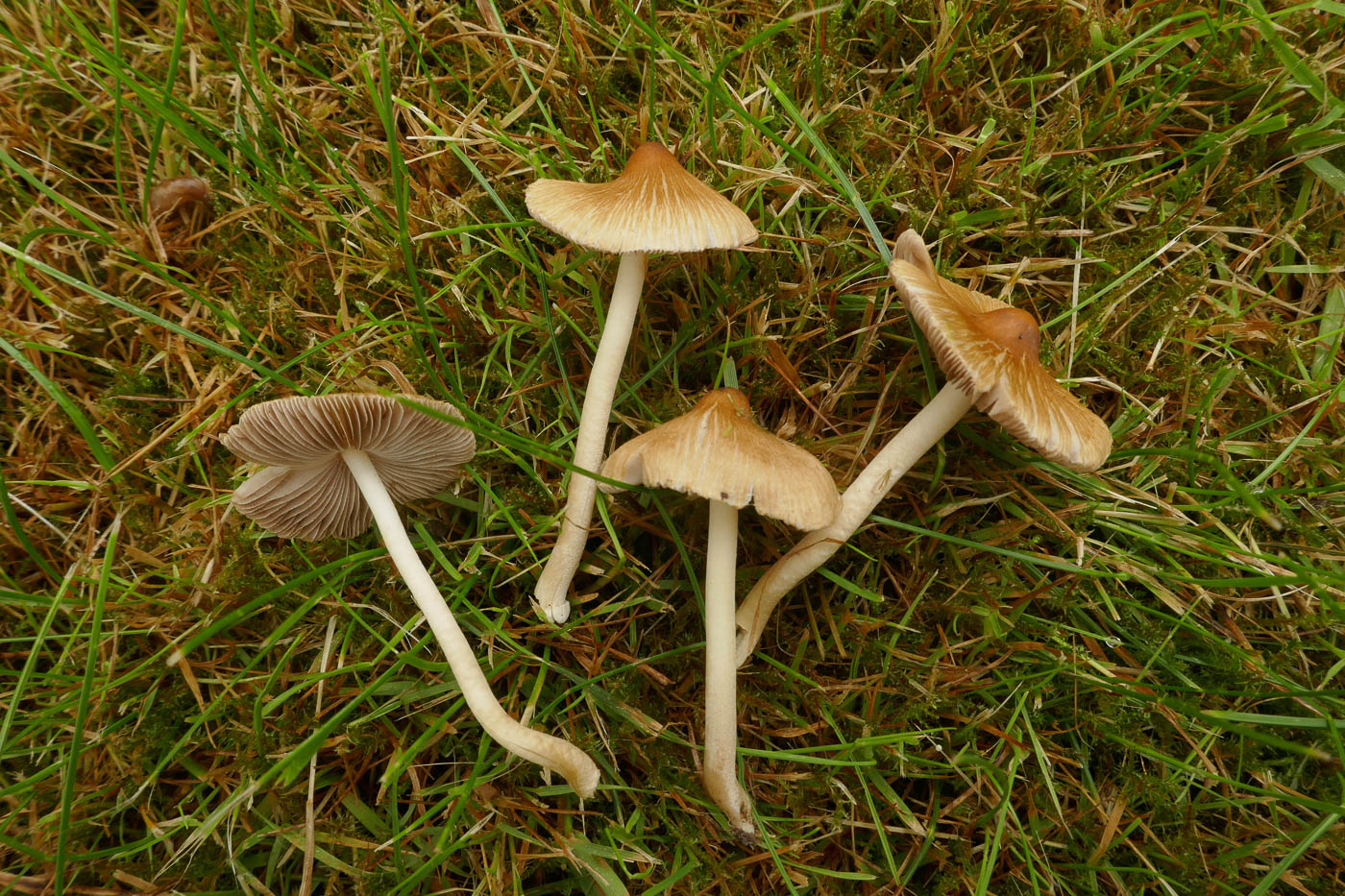
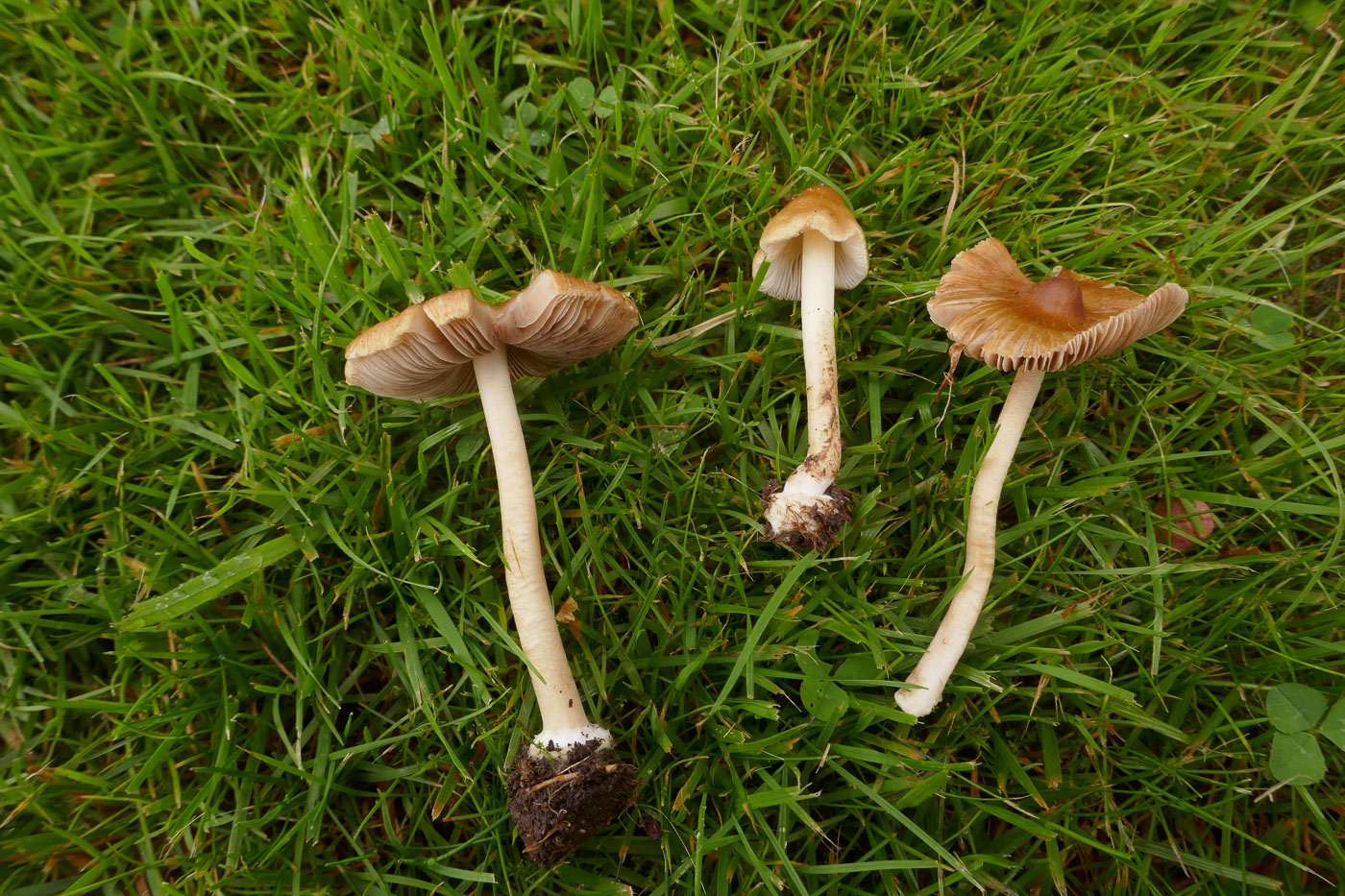
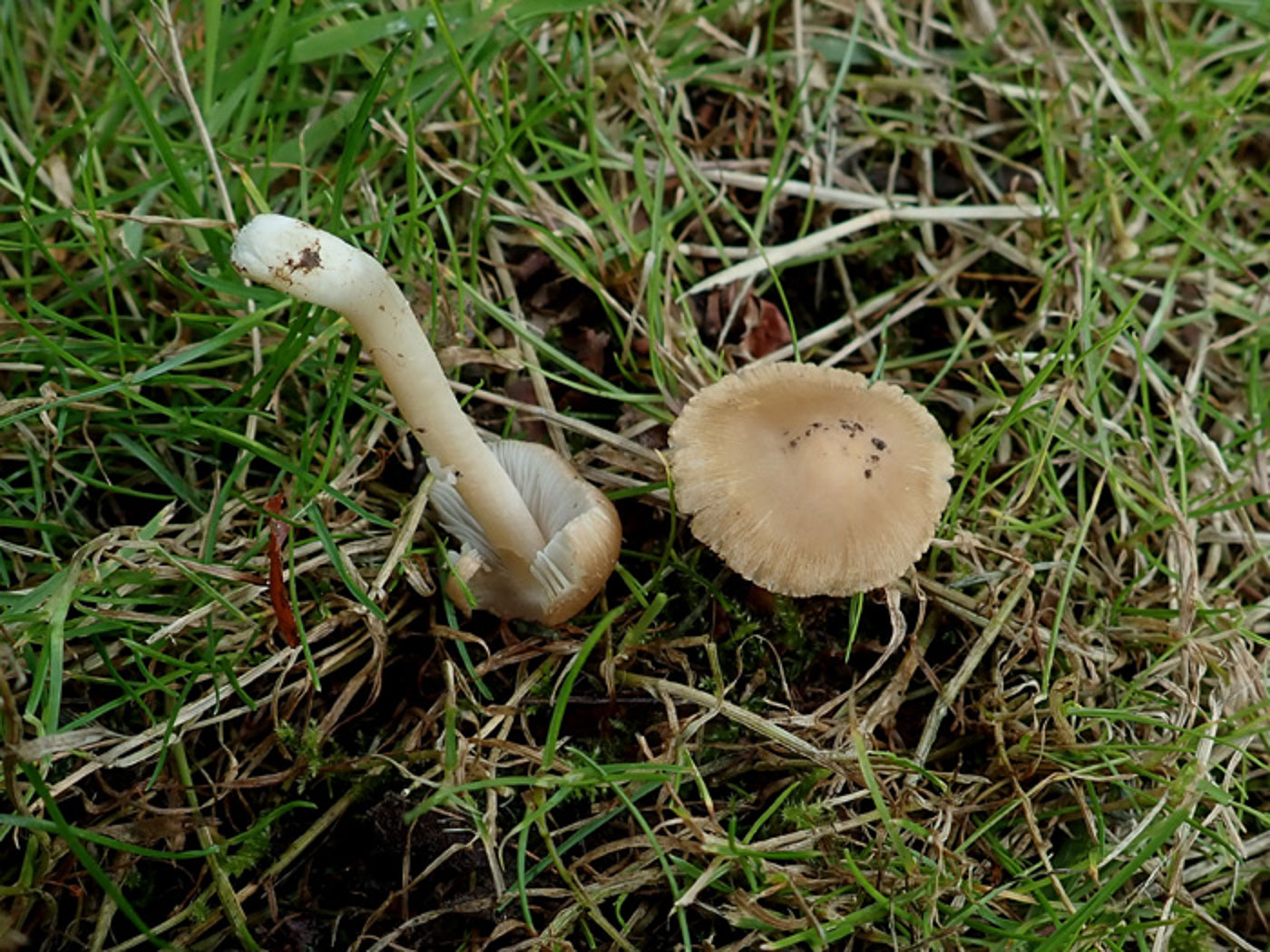
|
Inocybe mixtilis sl. (a Fibrecap with no common name) 
Sep 18, 2023. In a grassy verge under a mix of trees at Layters Green Jackie Ewan found this collection, noting their distinct bulbous stem base. At home she found nobbly spores, metuloid cystidia (having thick walled with crystals on top) and a stem also entirely covered in similar cystidia, but remained very unsure of the species. Penny, when examining the material the next day, was able to make a firm determination: both macro and micro characters were spot on for I. mixtilis rather than the several new species recently described within this complex (hence ss indicating in the strict sense). See also the entry on July 23rd - a collection marked sl which was not an exact match and will be sequenced.
Jul 23, 2023. At Turville Heath Penny found these two LBJs under Lime and, knowing the genus, took them home to work on - few if any of this genus can now be confidently named in the field! Both macro- and microscopic characters led her to I. mixtilis - now known to be a complex of at least six different species following DNA analysis, hence the 'sl' after the name here indicating 'in the broad sense'. She expects sequencing will show this collection to be I. mixtilis ss. (indicating in the strict sense) but reserves judgement for obvious reasons! This is a new entry for Finds.
|
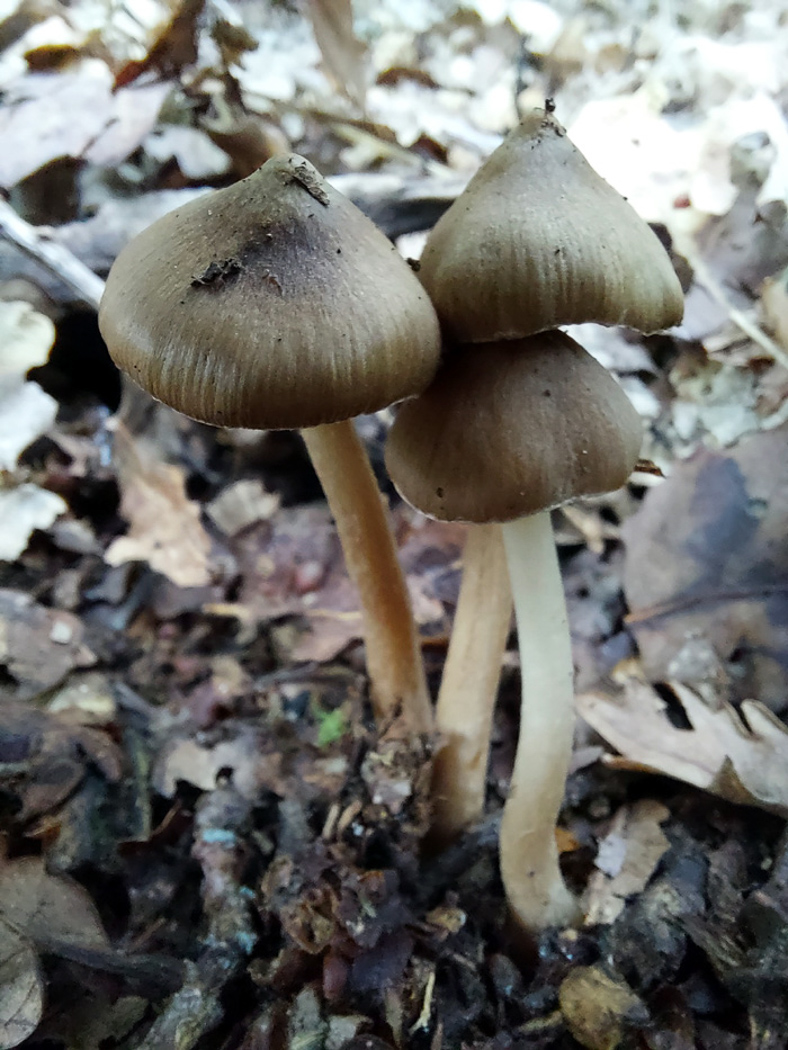
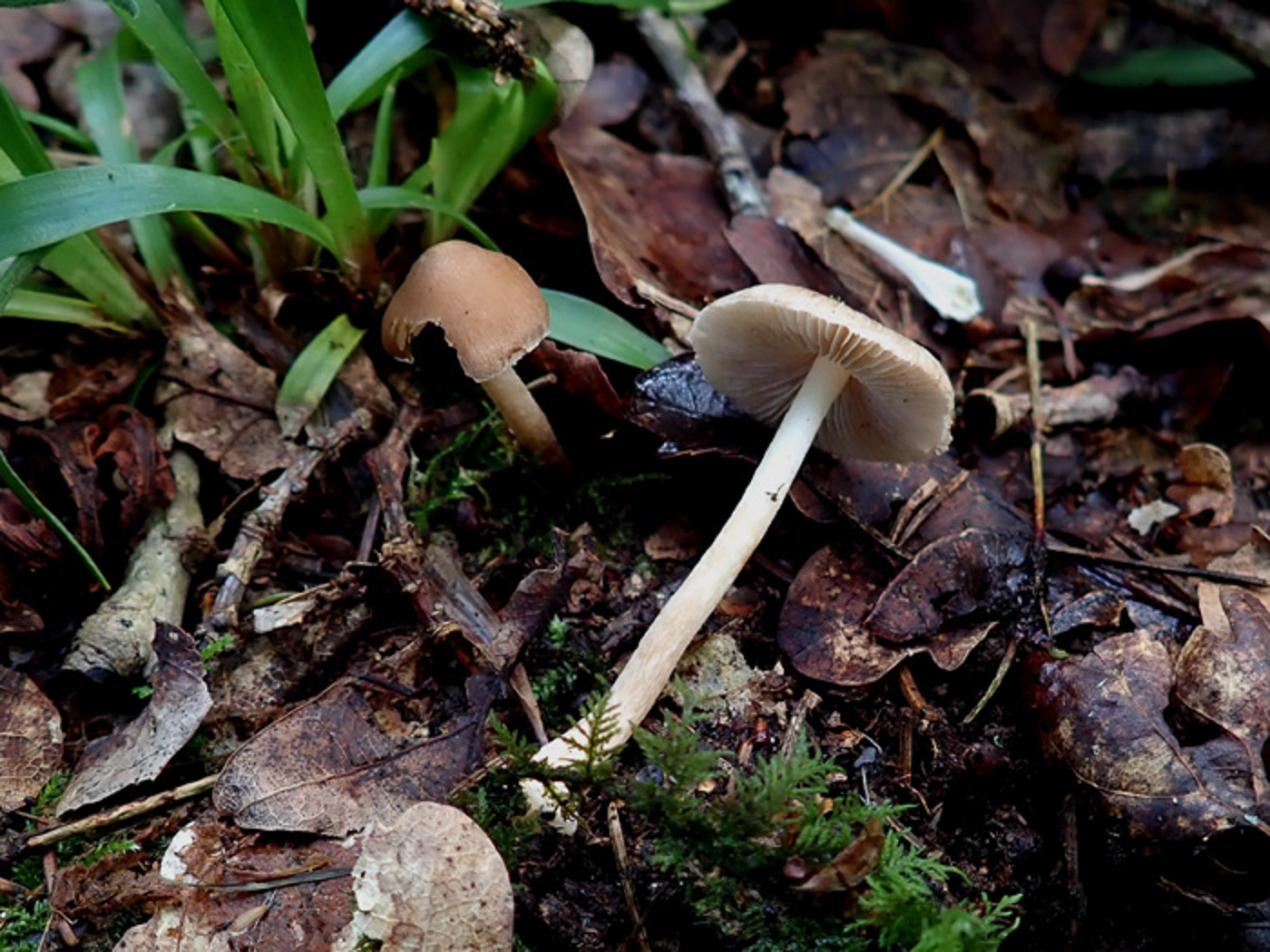 |
Inocybe napipes (Bulbous Fibrecap) 
Jul 18, 2023. In Gerrards Cross Common under Oak Jesper Launder found this attractive cluster of LBJs and took them home to check their identity. The species is quite common and typically has a smooth brown cap - conical when immature as here but becoming flattened later - also a slender stem tapering upwards and with a white round bulb at the base - not seen here. Penny also found this species in Bernwood Forest a few days later (photo 2). Under the scope it has quite distinctive features which help to separate it from the myriad of other similar Fibrecaps.This is a new entry for Finds.
|
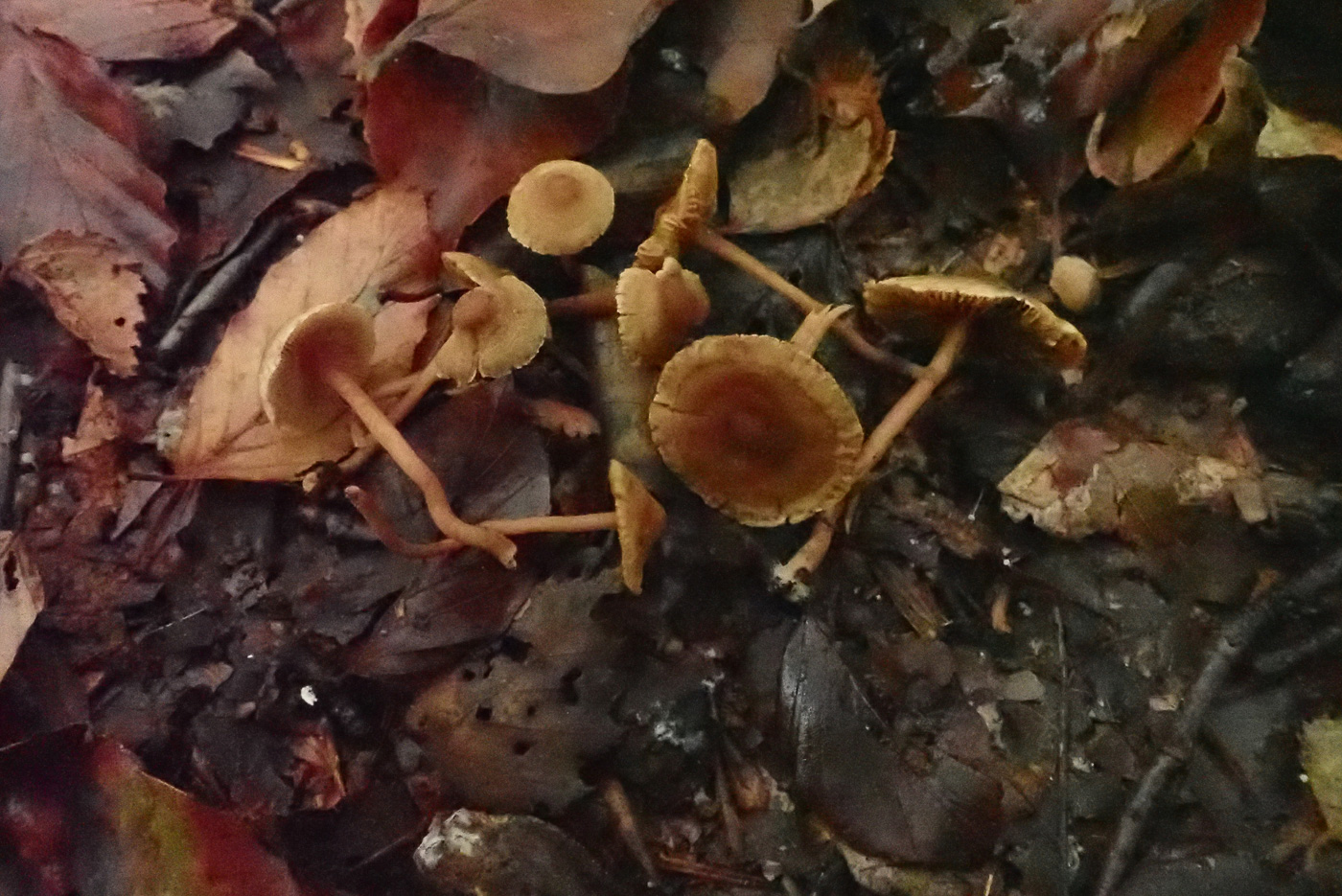
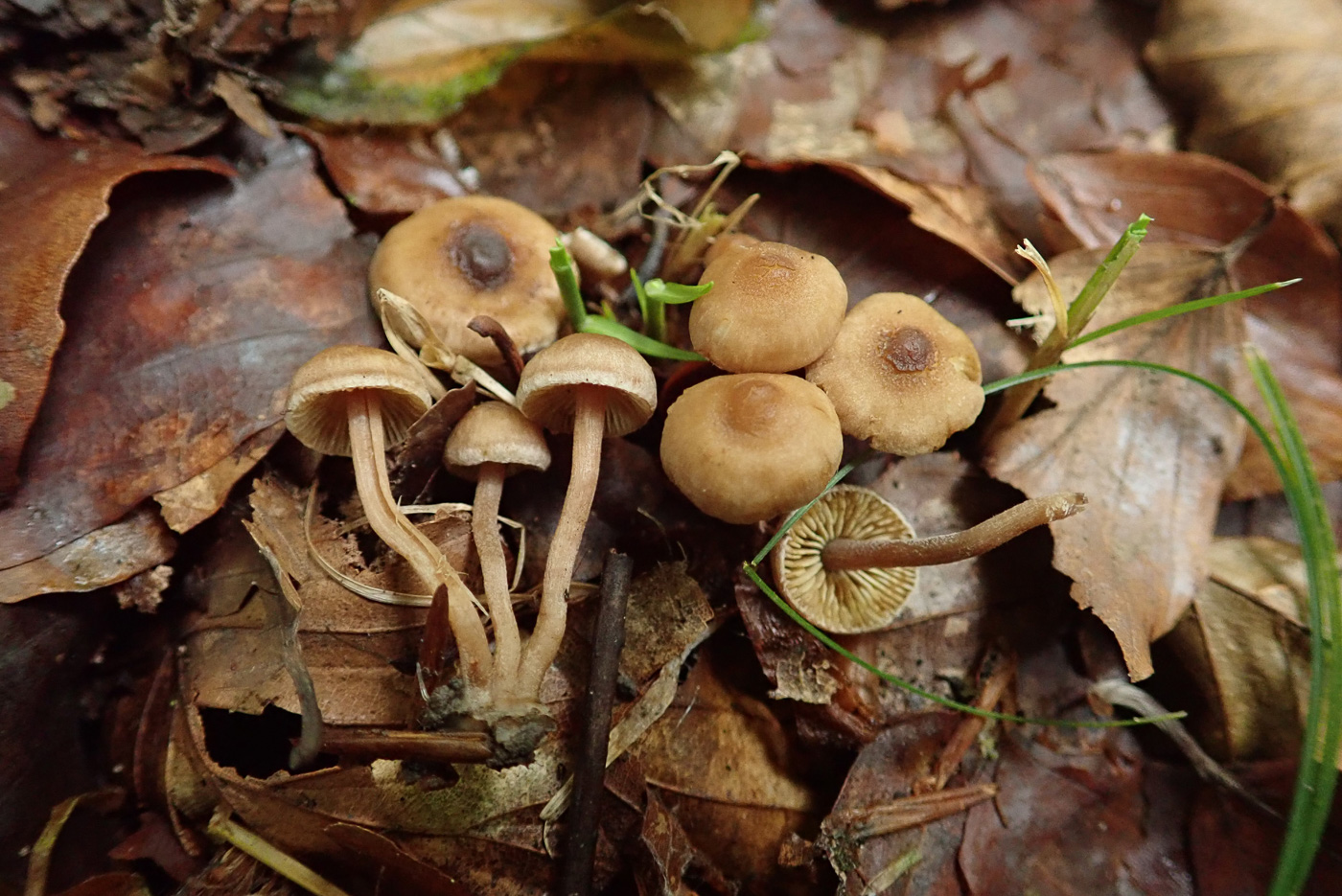
|
Inocybe petiginosa (Scurfy Fibrecap) 
Nov 3, 2021. In the Beech litter in Hodgemoor Woods there were many patches with this unassuming little LBJ, found by Paul and identified by Penny. This is one of the smallest Fibrecaps and also one which is likely to be misidentified unless checked with a scope - when its amazing nobbly spores and bright yellow cystidia leave one in no doubt! This could just as easily be a species of Tubaria or Flammulaster (incidentally which I mistook it for at Bittam's Wood but luckily checked it at home). It was unusual to see it in these numbers, considered an occasional fruiter under Beech and less frequently Oak.
Oct 12, 2020. Penny Cullington found this tiny Fibrecap under Beech in Gussetts Wood. One of the very smallest Fibrecaps, this definitely qualifies as an LBJ (little brown job) and is not typical of the genus having rather creamy yellowish gills and a roughened cap surface, the caps often less than 1.5 cms across and with a paler band around the edge. It is not until one sees the nobbly spores and very distinctive gill cells under a scope that the genus becomes clear.
|
 |
Inocybe posterula (a Fibrecap with no English name)  
Nov 15, 2023. Under Pine at Prestwood Churchyard Penny came across good numbers of a white Fibrecap and, realising that this might well be something different now that DNA in recent years has shown there to be quite a few separate white Fibrecap species, she made a collection to get sequenced. Not only do these species look pretty well identical but their microscopic characters are also extremely similar, rendering sequencing the safest way to make a determination to species. Gone are the days of naming these white lookalikes to species either in the field or in the lab! Sure enough when sequenced this proved to be I. posterula, a rare Pine associate (though confusingly I. geophylla can also occur under conifers). This is just the second county record and a new entry for Finds.
|
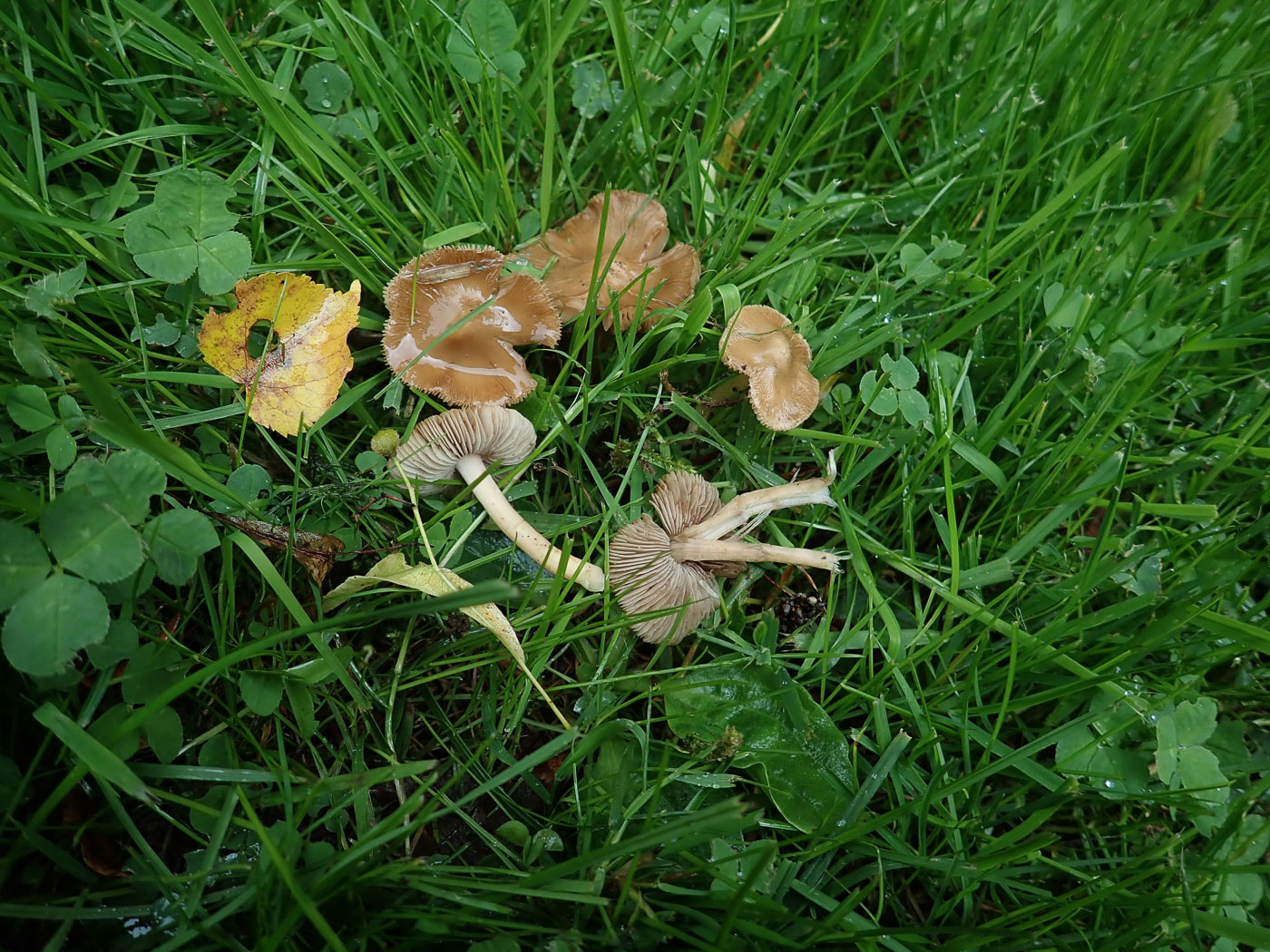 |
Inocybe putilla (a Fibrecap with no common name) 
Sep 27, 2022. Under the Limes at Turville Heath Penny found this rare Fibrecap, one which, as with the previous species, she's identified just once previously in the county but wouldn't like to guarantee it was correct. Though its shape and gill colour are typical of the genus, the fibrous cap surface remains more or less intact rather than radially splitting compared with the species above, and the microscopic characters are completely different. This is another collection to be dried for sequencing.
|
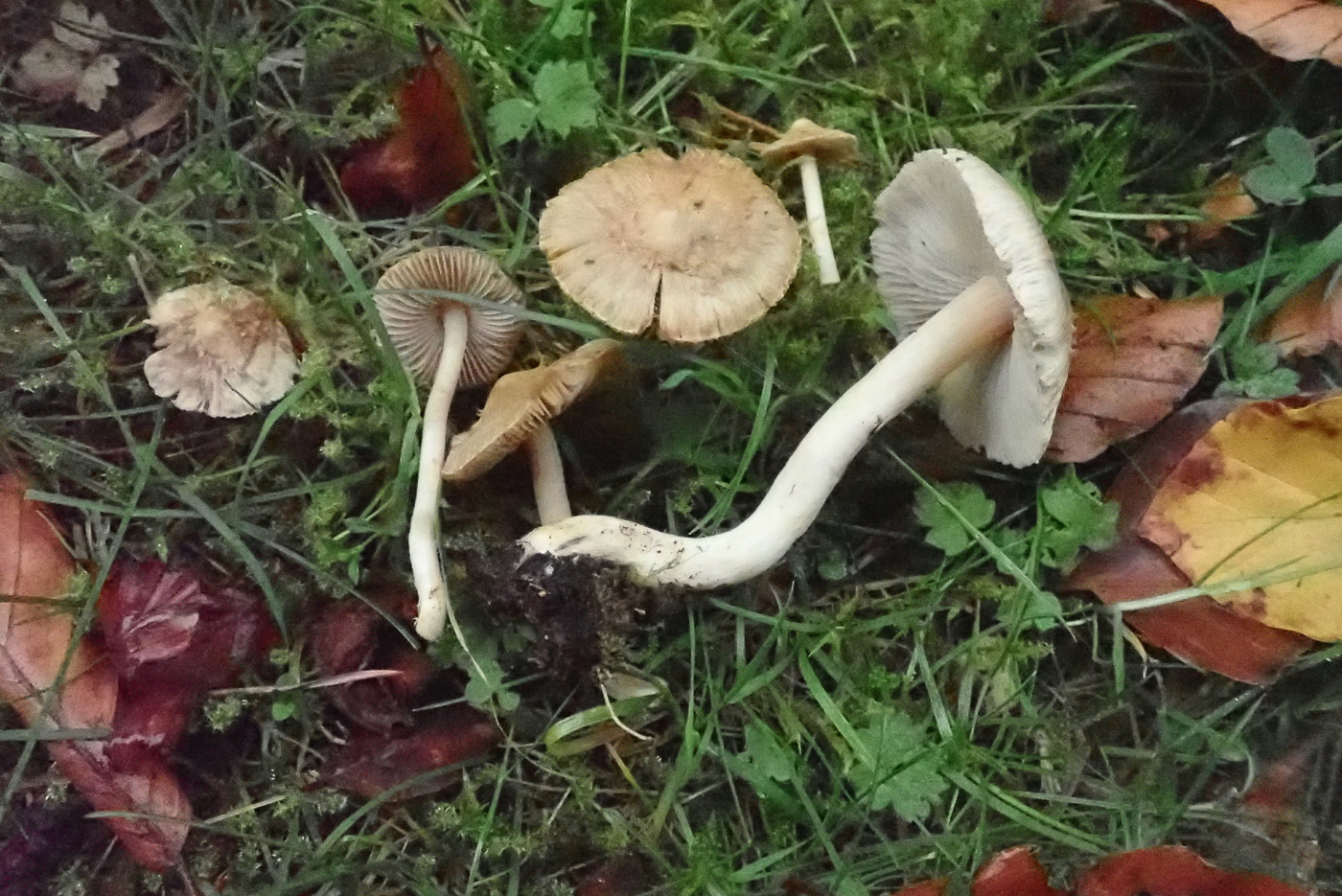
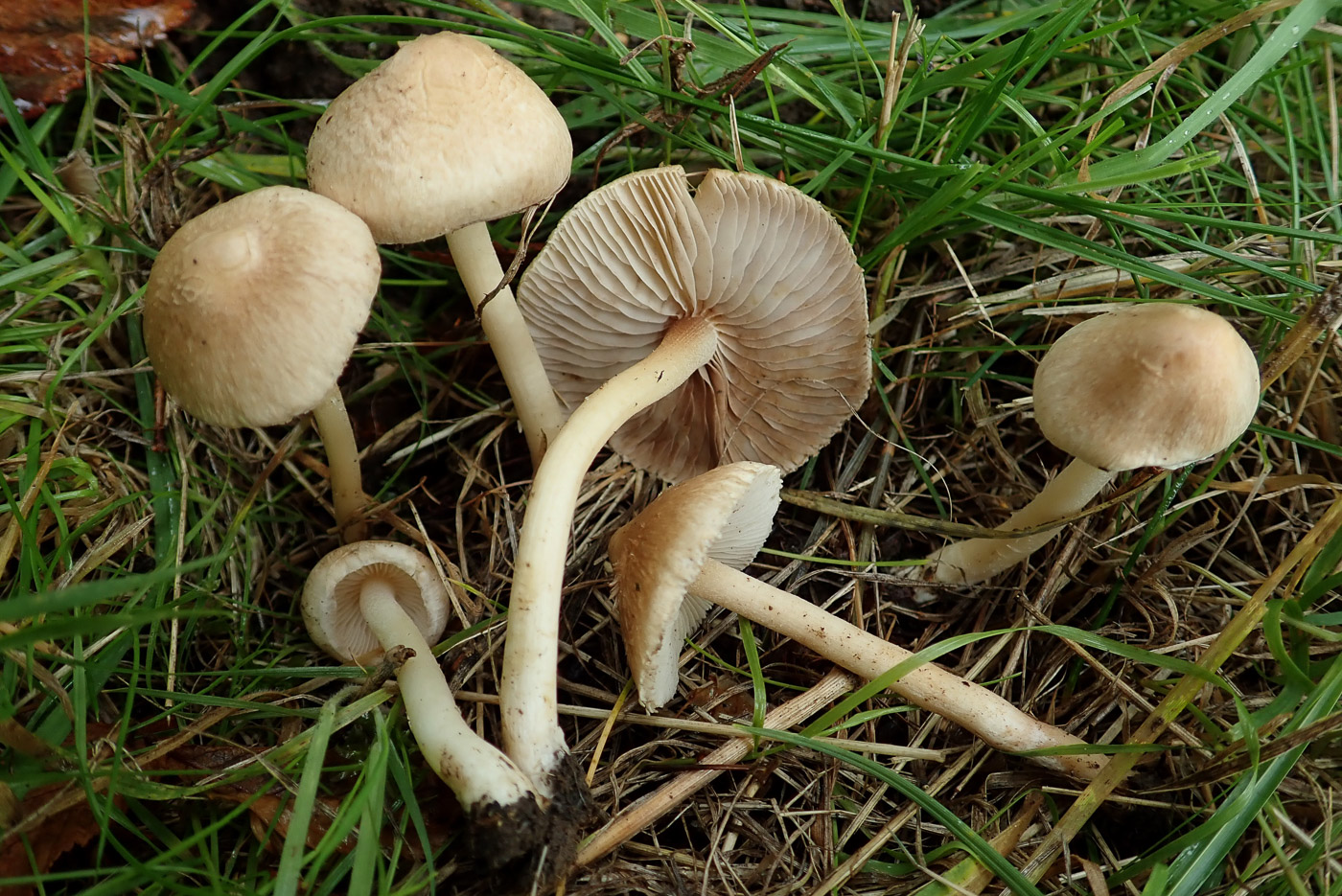
|
Inocybe sindonia (Pale Fibrecap) 
Nov 3, 2021. In a grassy path edge under mixed deciduous trees in Hodgemoor Woods Penny found a collection of this fairly common Fibrecap and one which can be named in the field by those who know the genus well. There are only a few members of this large genus which have pale beige caps, this being the commonest and having very long thin cystidia (cells on the gill) which have thick yellow walls which makes it a fairly quick check with a scope.
Oct 8, 2020. This collection was found under Lime at Turville Heath by Penny Cullington. Despite its common name, there are quite a few Fibrecaps with similar coloured caps, so even the experienced mycologist should always check with a scope before naming any Inocybe with certainty. It is included here as an example of a pale capped Fibrecap to be compared with our four other species (so far on the list) which have either different coloured caps or if similar then different textures caps.
|
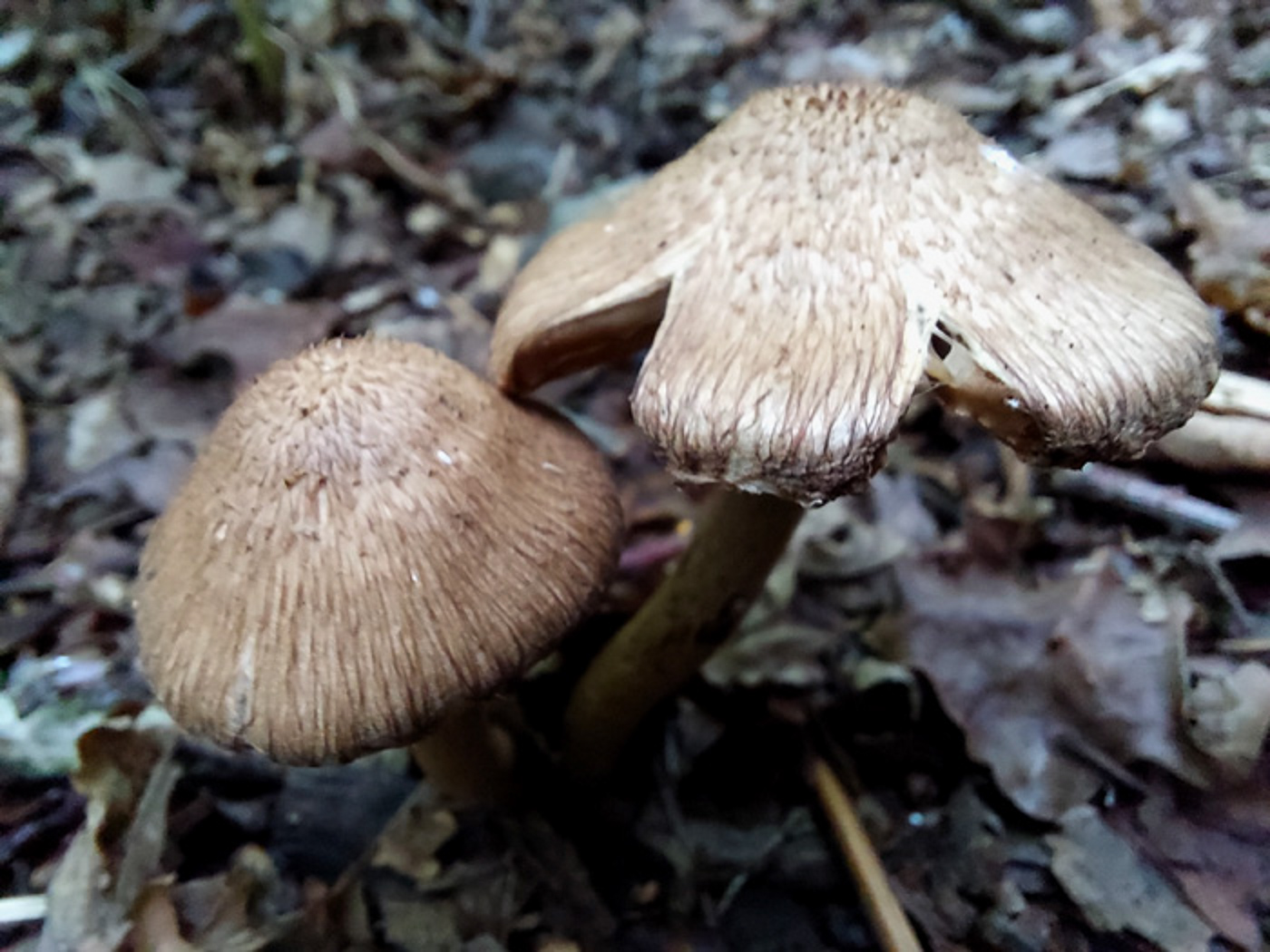
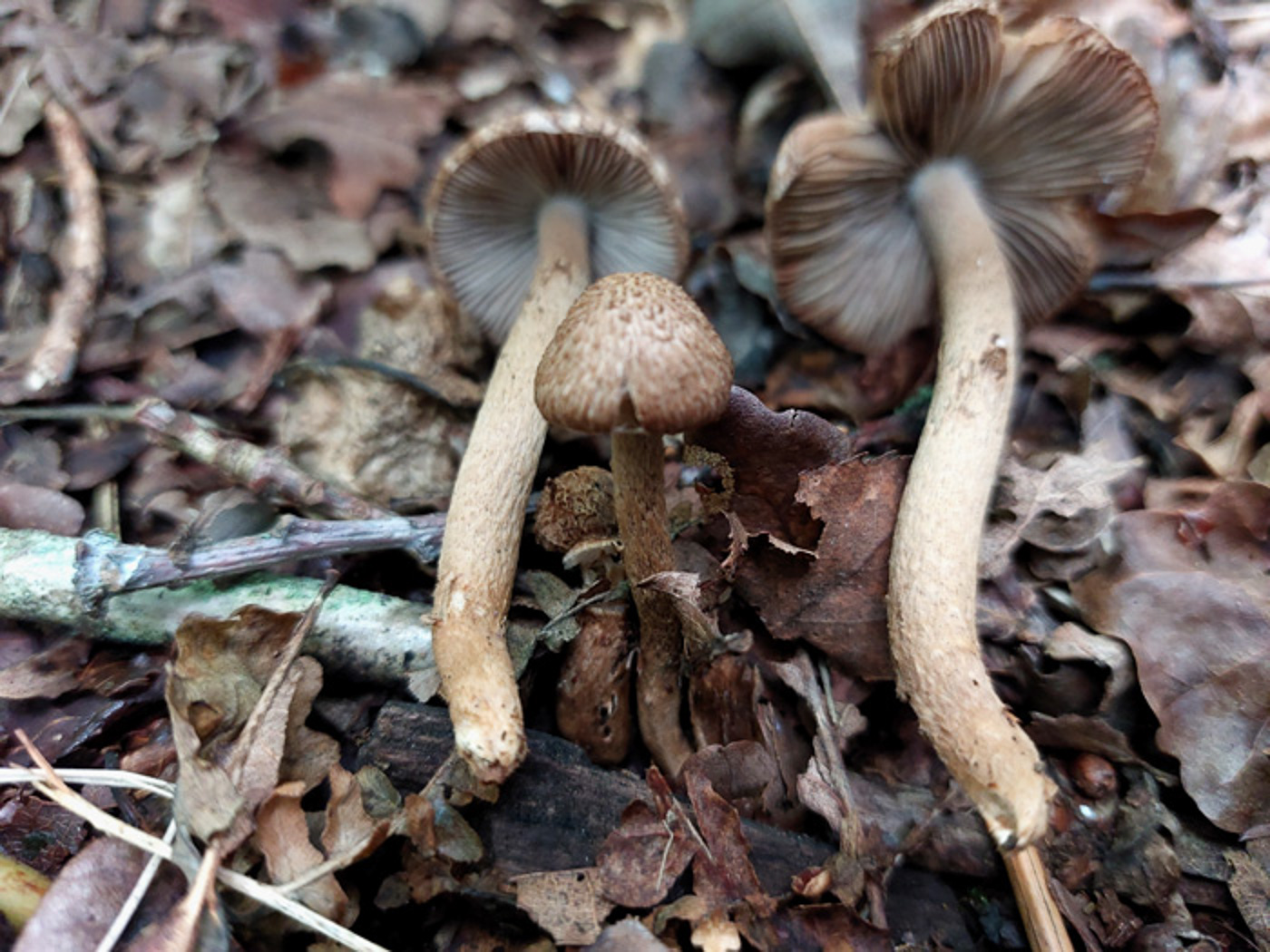 |
Inocybe stellatospora (Woolly Fibrecap) 
Aug 12, 2023. In Gerrards Cross Common under Oak Jesper Launder spotted this quite distinctive Fibrecap, having a scaly to almost furry cap and a fleecy stem also. Though not alone in having these characters the microscopic features are fairly distinctive also and help with the ID. It can occur under conifers as well as deciduous trees but is not that common. This is a new entry for Finds.
|
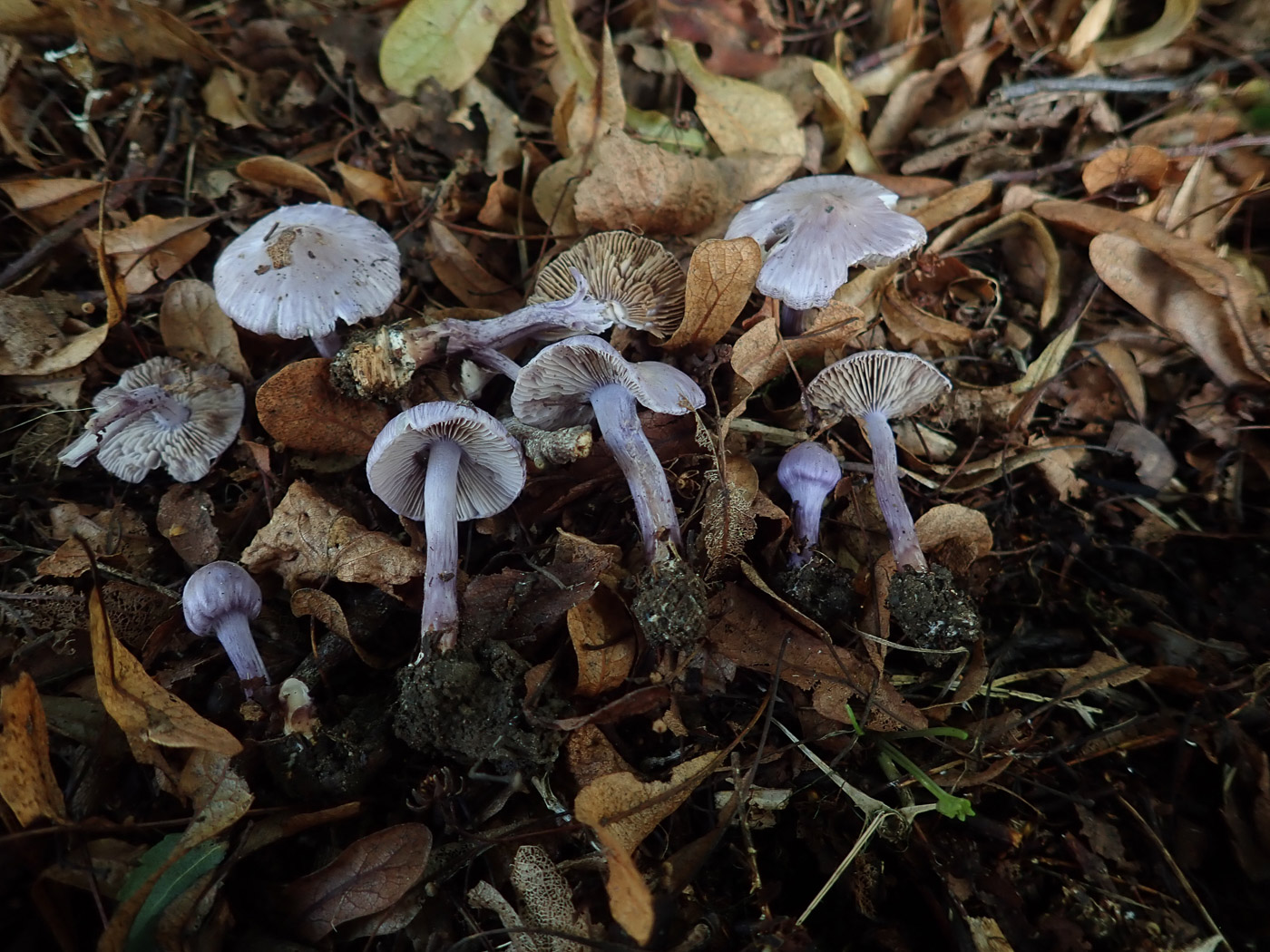
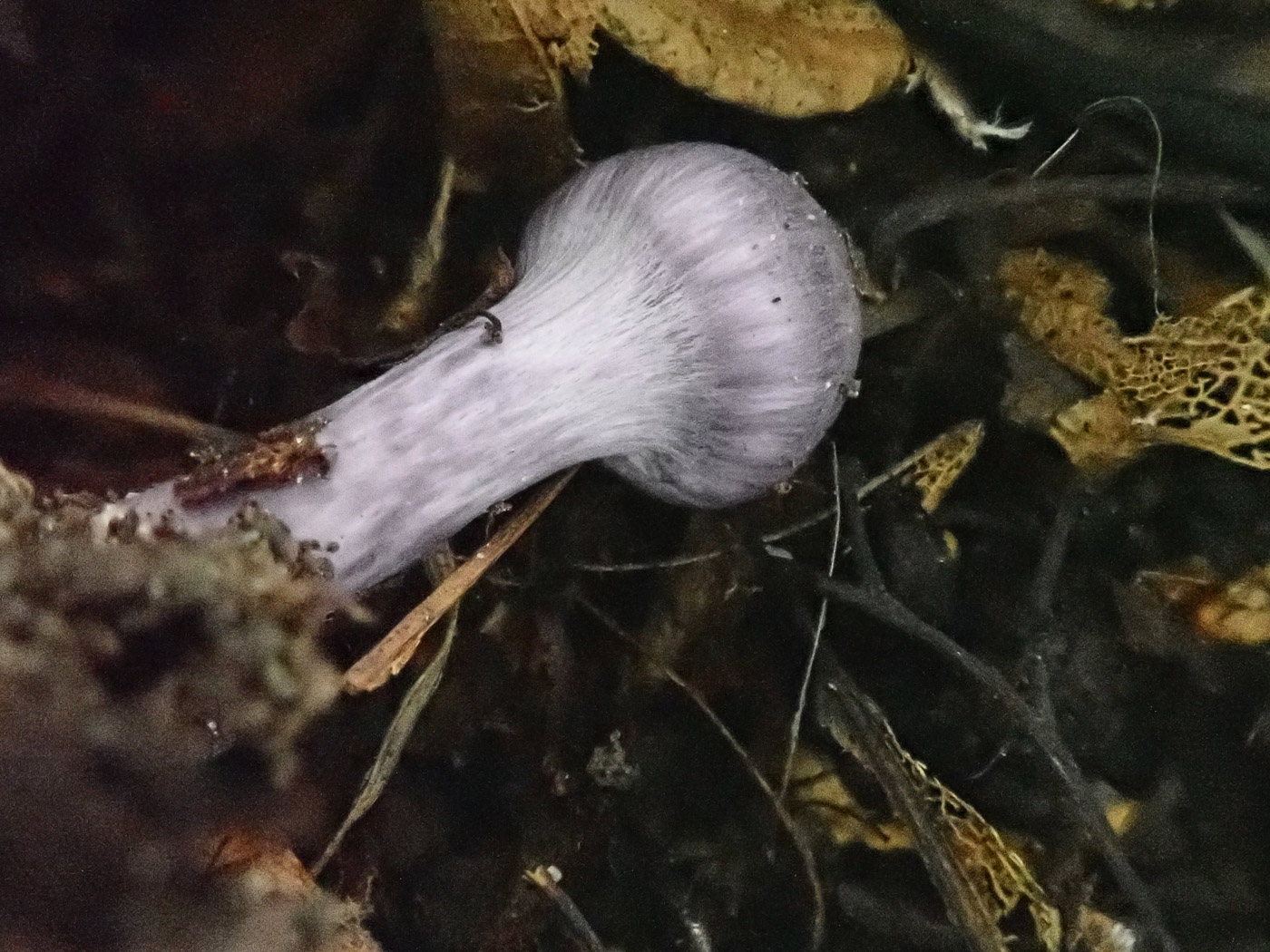
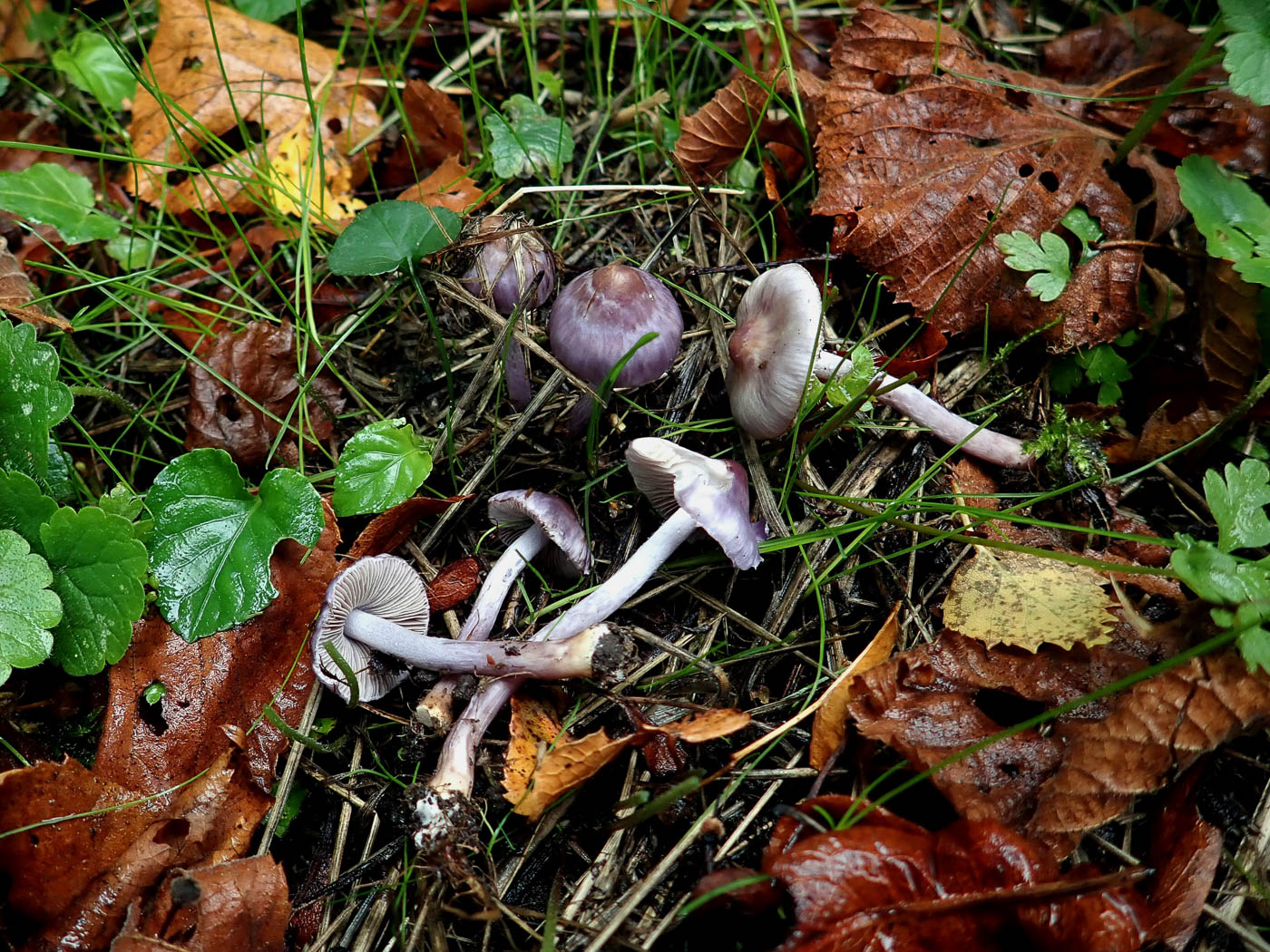 |
Inocybe tyrii (a rare Fibrecap with no English name)  
Sep 26, 2023. Under Lime at Turville Heath Penny made a sizeable collection of this Fibre cap with a view to getting it sequenced. Recent years have revealed that what we recorded previously as I. lilacina (and before that as I. geophylla var. lilacina) is in fact a complex of several species now newly described but so similar to each other that determining to species needs DNA confirmation to be really sure. Last year a collection from this site turned out to be I. tyrii, new to the British list, and today's collection is very likely to be the same again. This entry will be updated once results are back from sequencing. Photo 2 shows an immature specimen with cortina still intact.
Sep 27, 2022. In soil in the Lime avenue at Turville Heath Penny collected this lilac Fibrecap which appears to all intents and purposes identical (both macro - and microscopically) to the very common I. lilacina (Lilac Fibrecap). However, knowing of the existence of several lilac look-alike Fibrecap species recently described from Europe, she sent today's collection for sequencing which then confirmed it as not I. lilacina but I. tyrii and as such the first UK record. With the knowledge available so far about this species she defies anyone to recognise it as different from I. lilacina without recourse to sequencing!
|
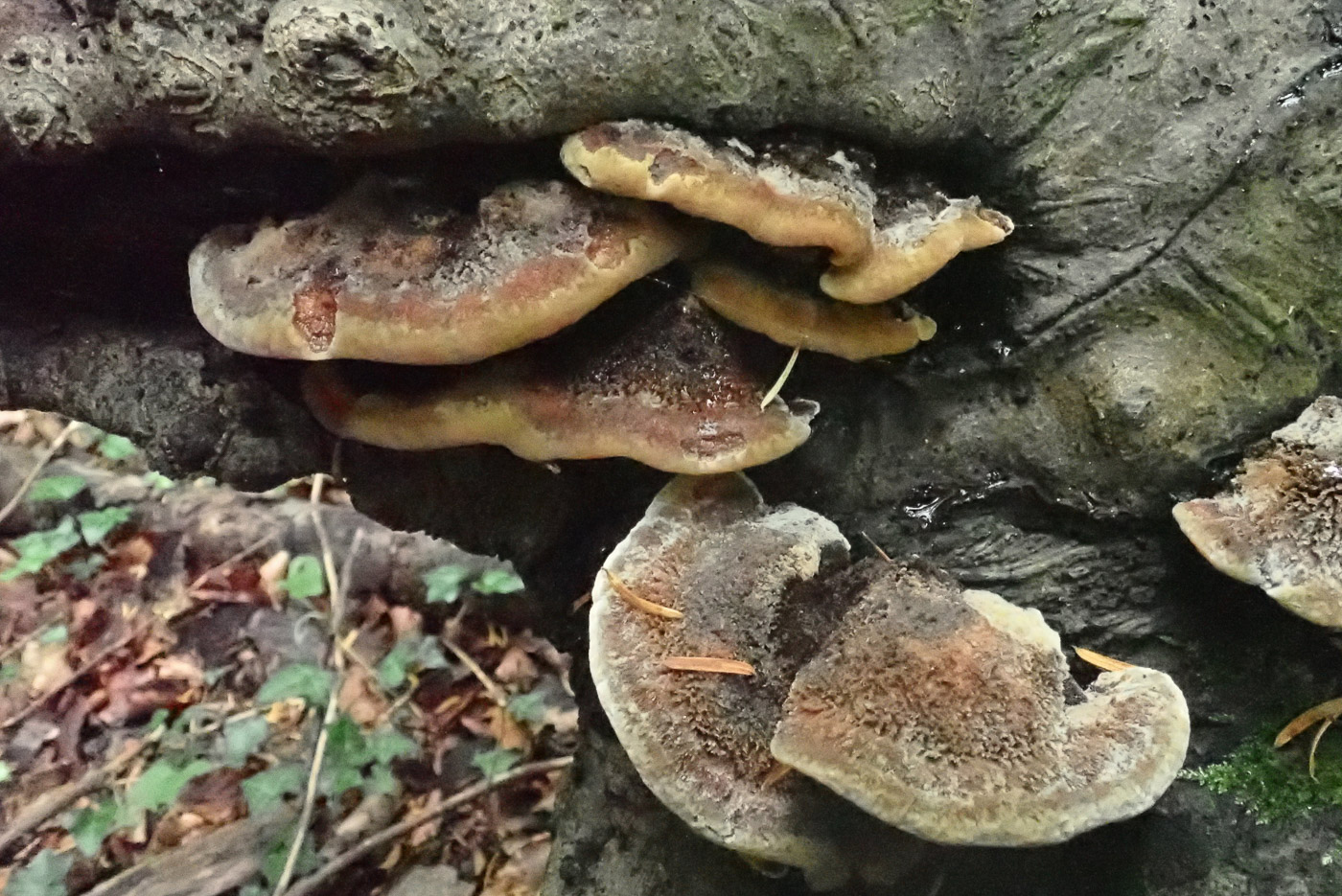
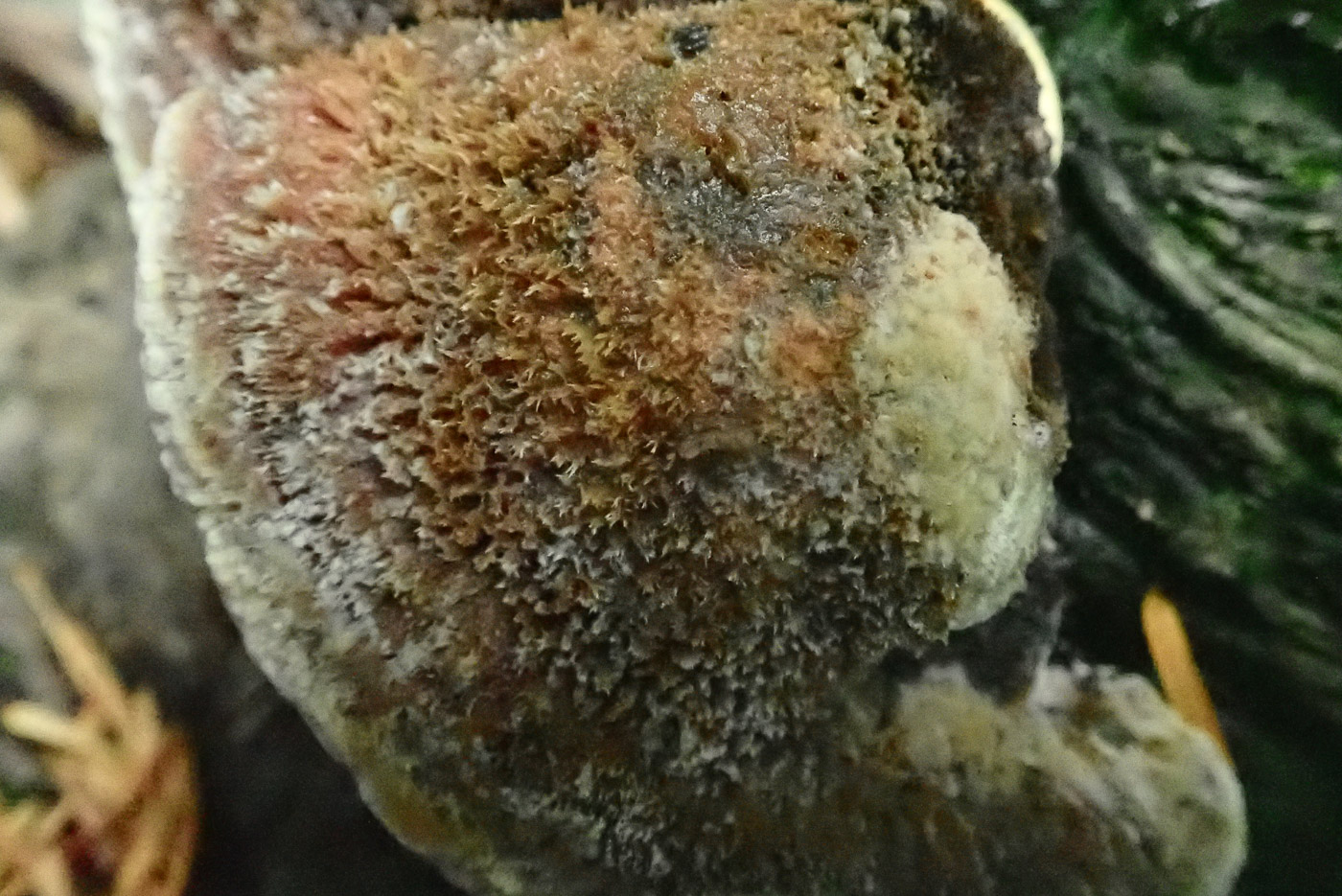
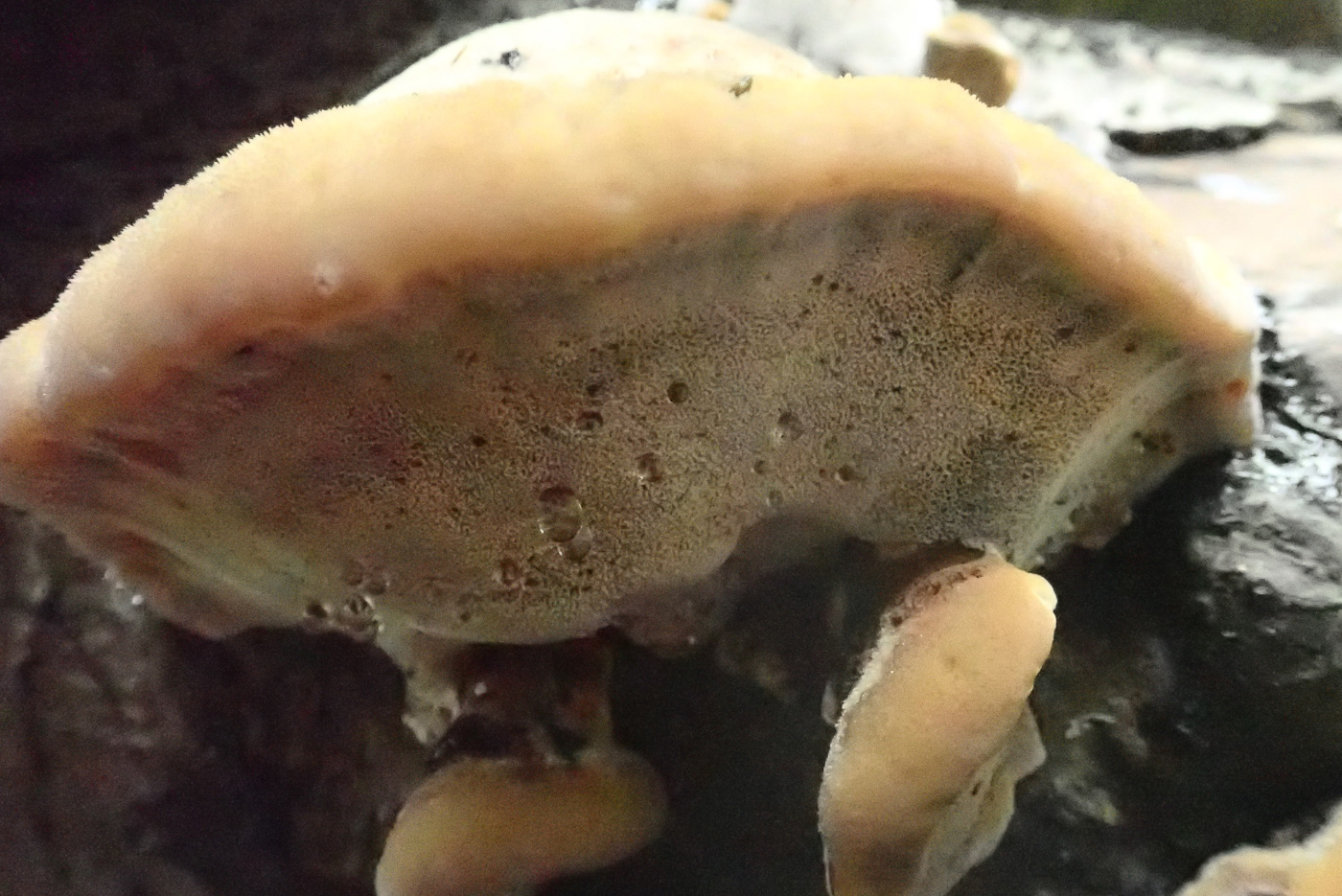
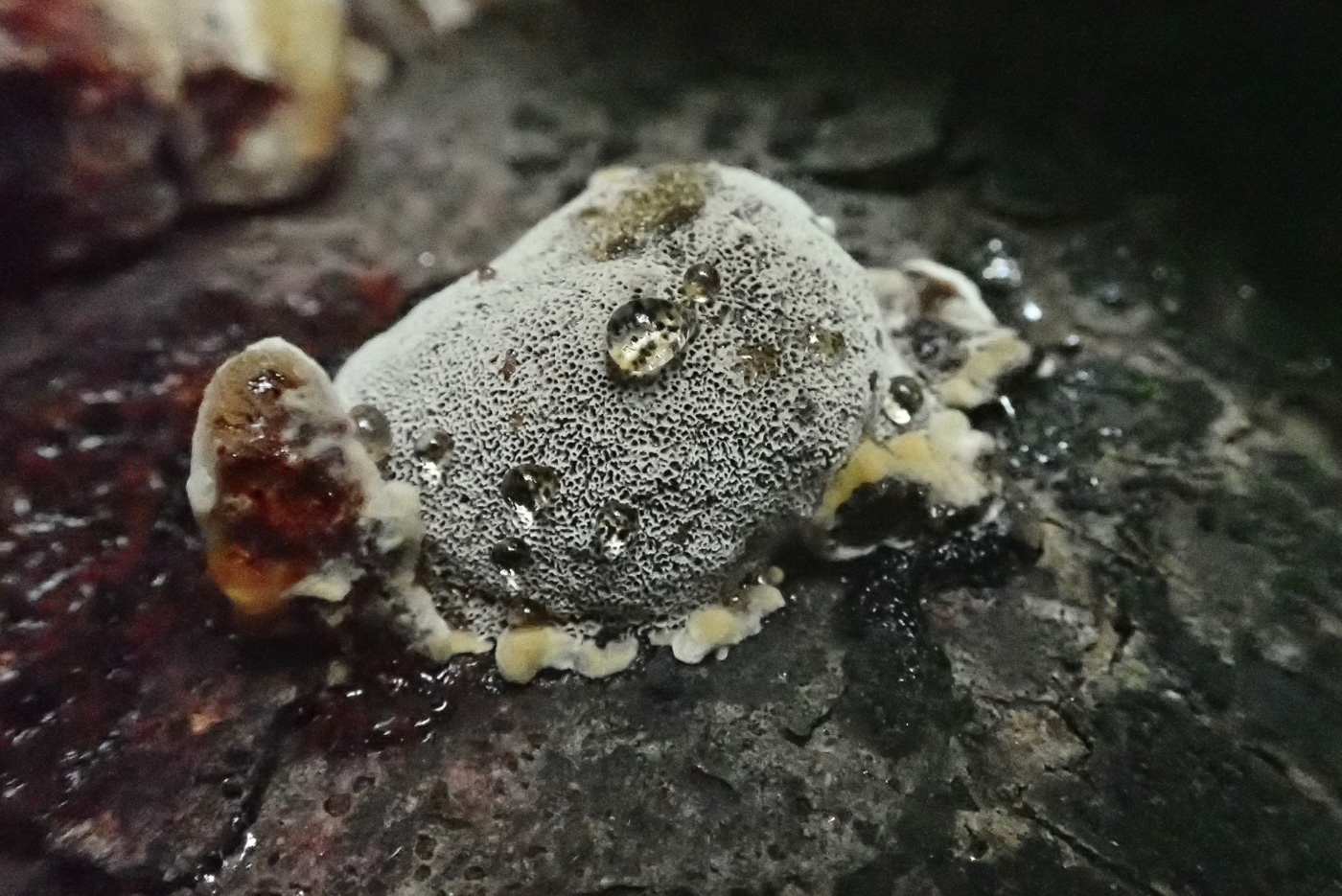
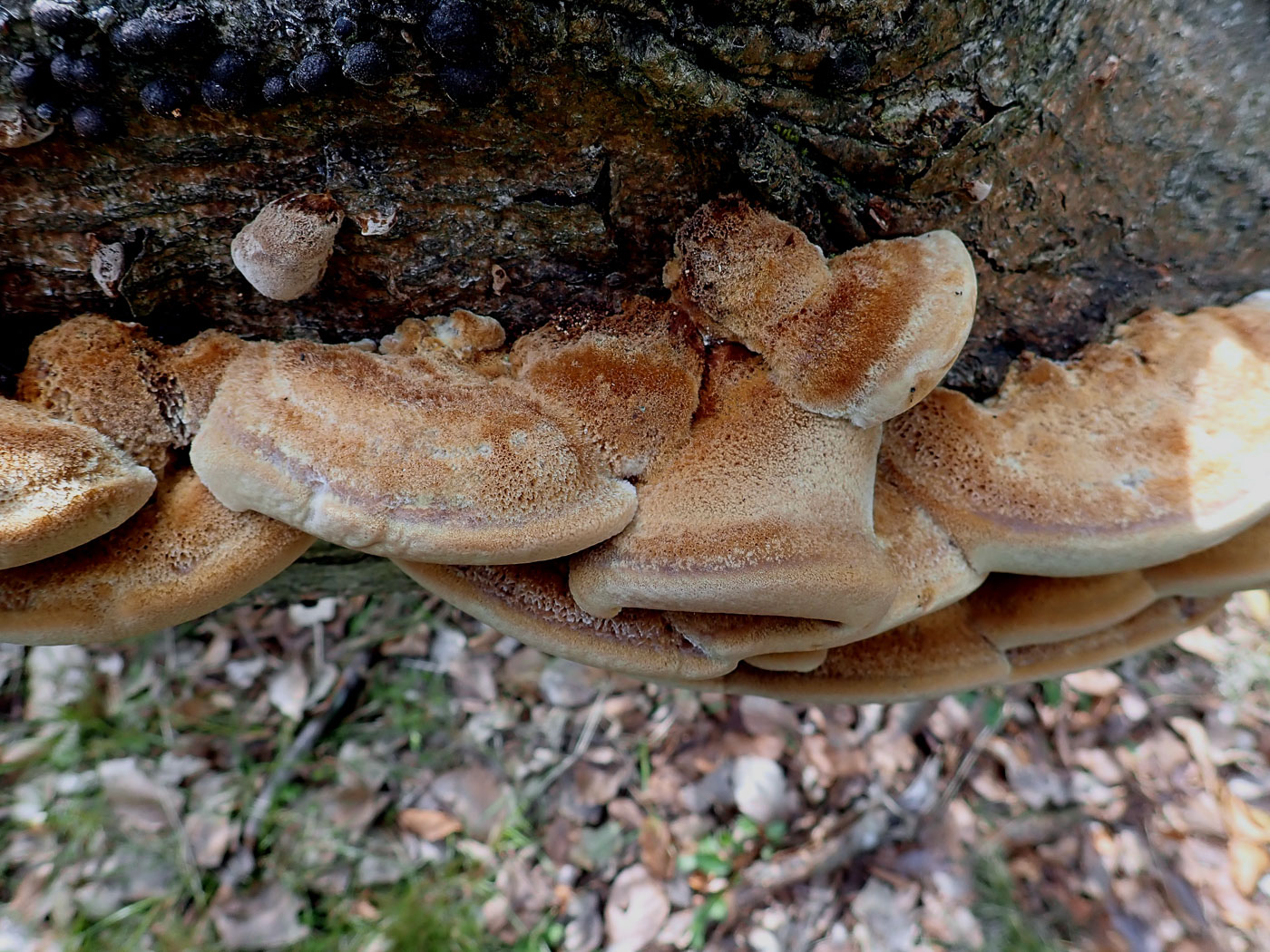
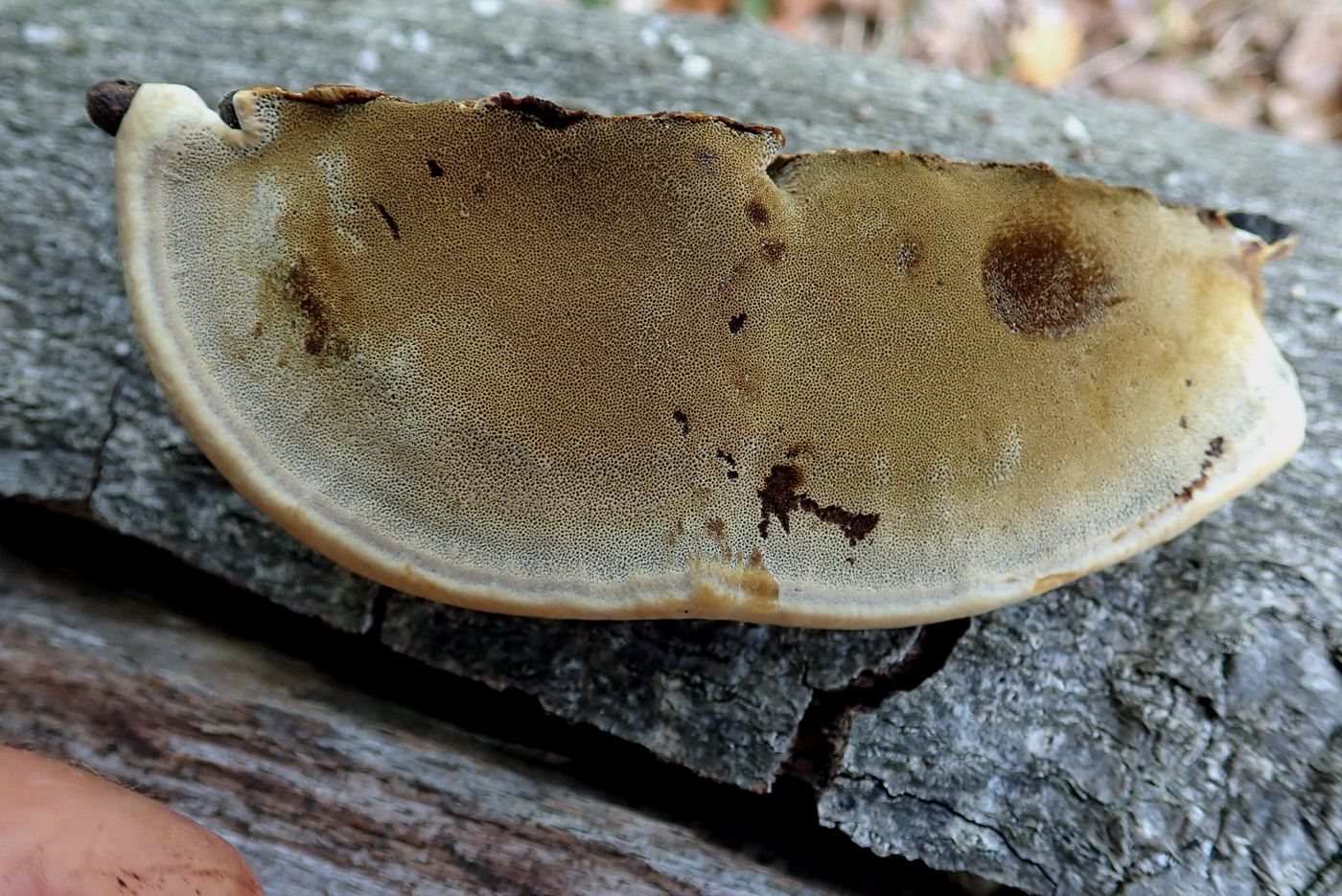
|
Inonotus cuticularis (Clustered Bracket) 
Jul 31m 2021. On a fallen Beech trunk in the piece of woodland on the edge of Ragpits Nature Reserve Penny found nice examples of this quite unusual bracket, one for which we have a handful of county sites. It is one that forms tiers as here, the upper surface being quite soft and spongy, also distinctly finely hairy (photo 2) with a thickened pale margin, the pores (photo 3) are pale at first but darken to brown and also bruise brown, and when actively growing and moist as here it can have resinous clear droplets on the upper surface (photo 4). Penny eventually persuaded it to drop spores at home, revealing their rusty brown colour as well as their size and shape, then checked the surface hairs which under a scope are brown, branched and spiky, diagnostic of this particular species which can occur on many different deciduous woods.
Sep 19, 2020. Penny Cullington found this bracket growing on fallen Beech in Penn Wood. This is quite an uncommon bracket and is unusually soft to the touch with a velvety finely hairy upper surface; it tends to grow in overlapping tiers along the substrate. The fine pores underneath have an olive brown tone which glances in the light and bruises darker when you press it, this seen in the second photo here.
|
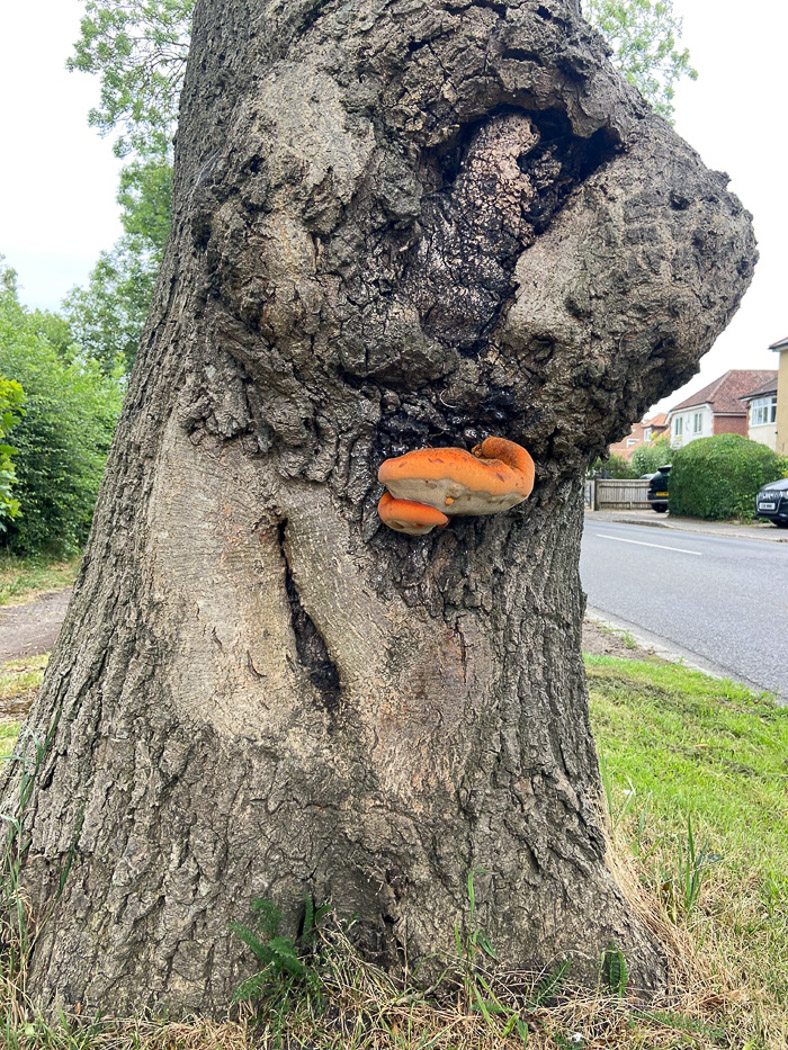
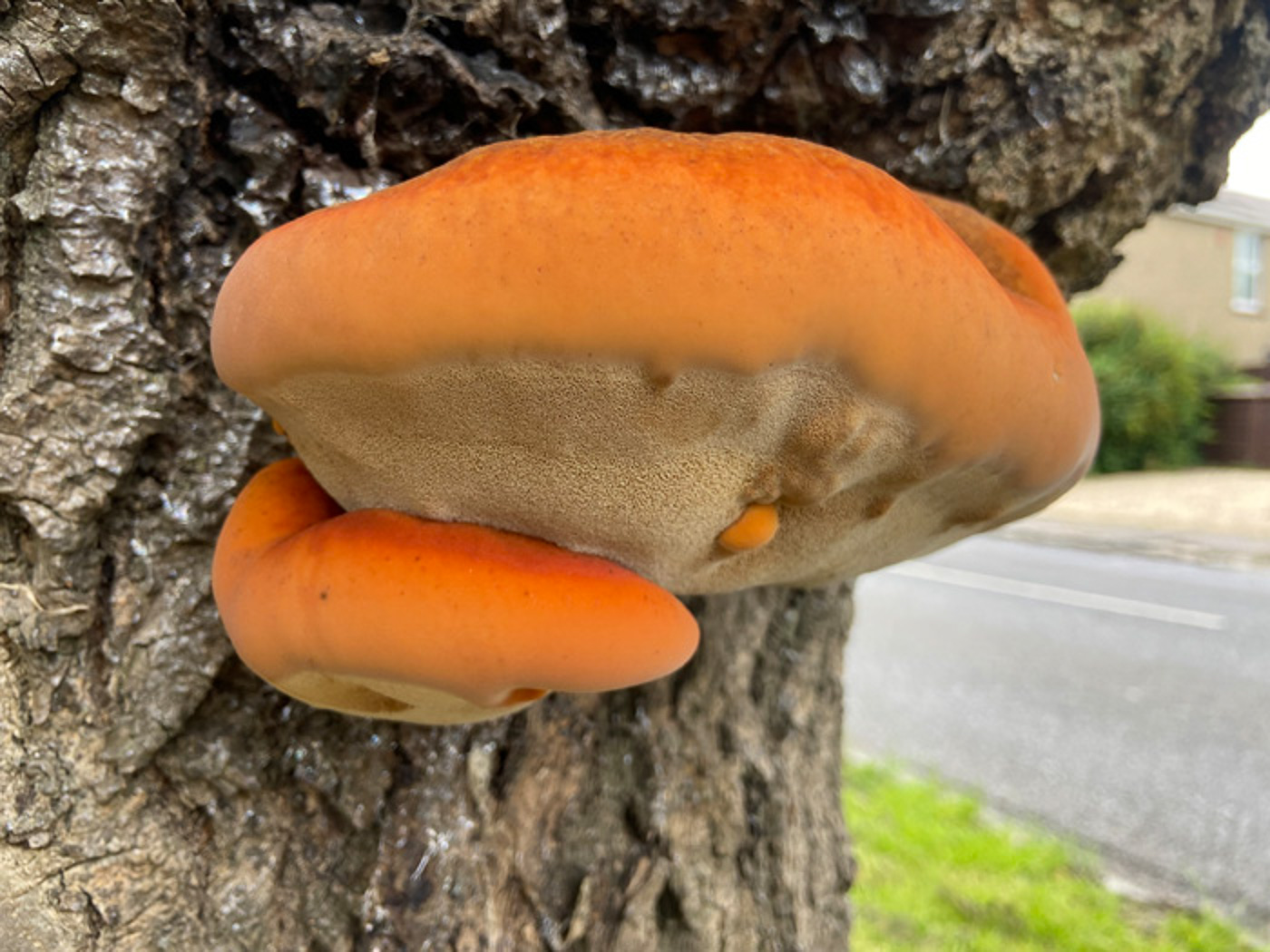
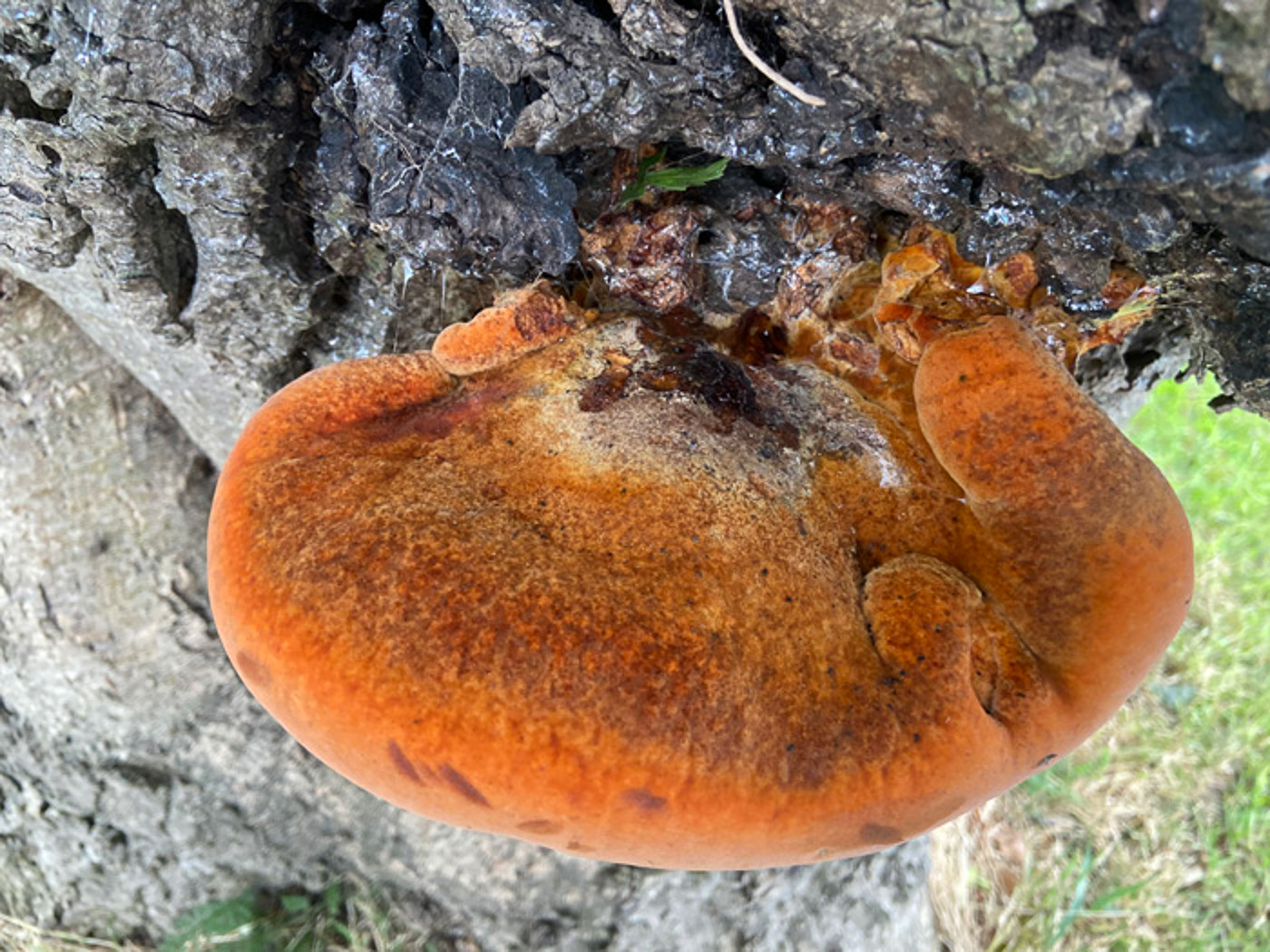
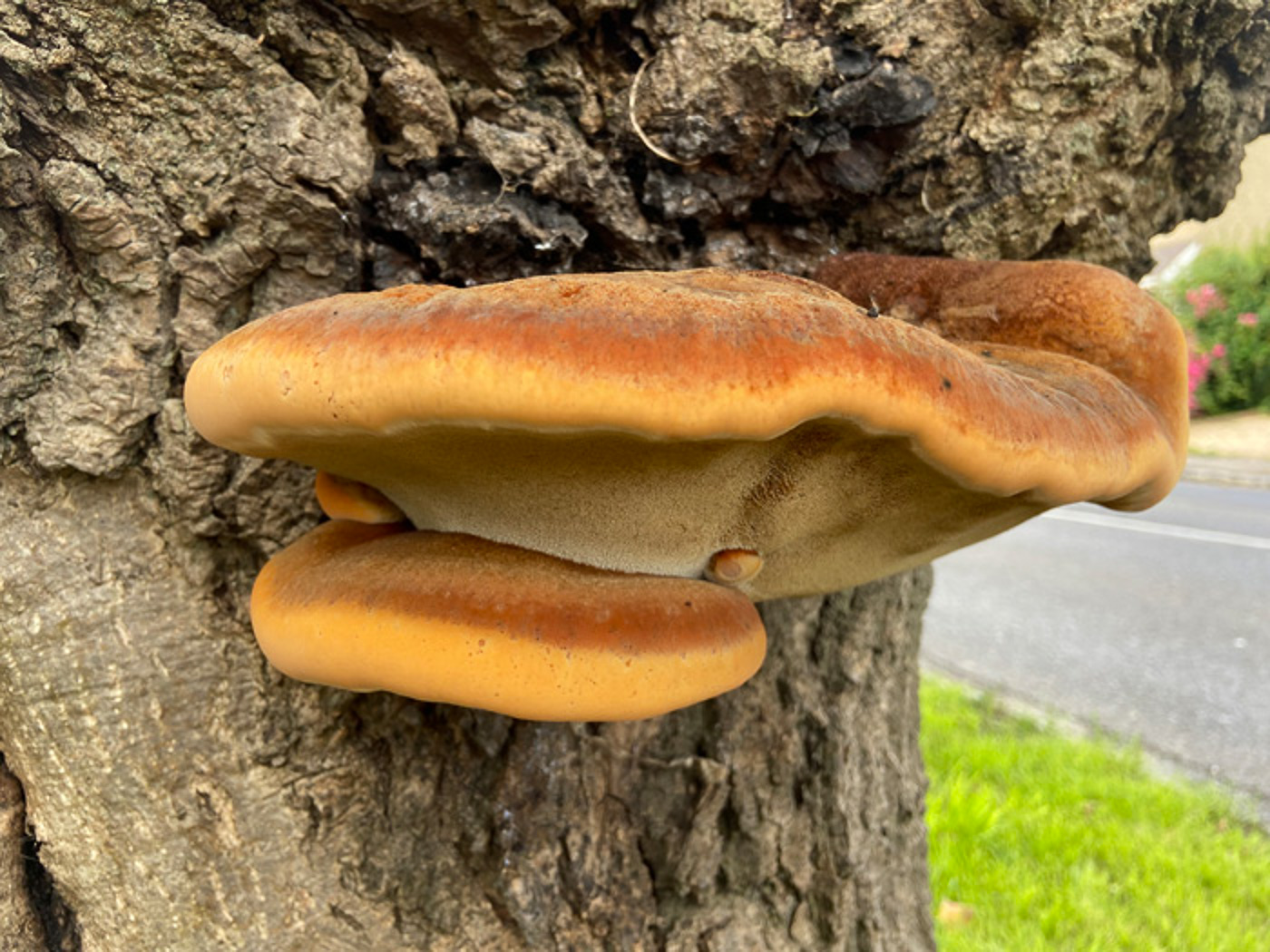
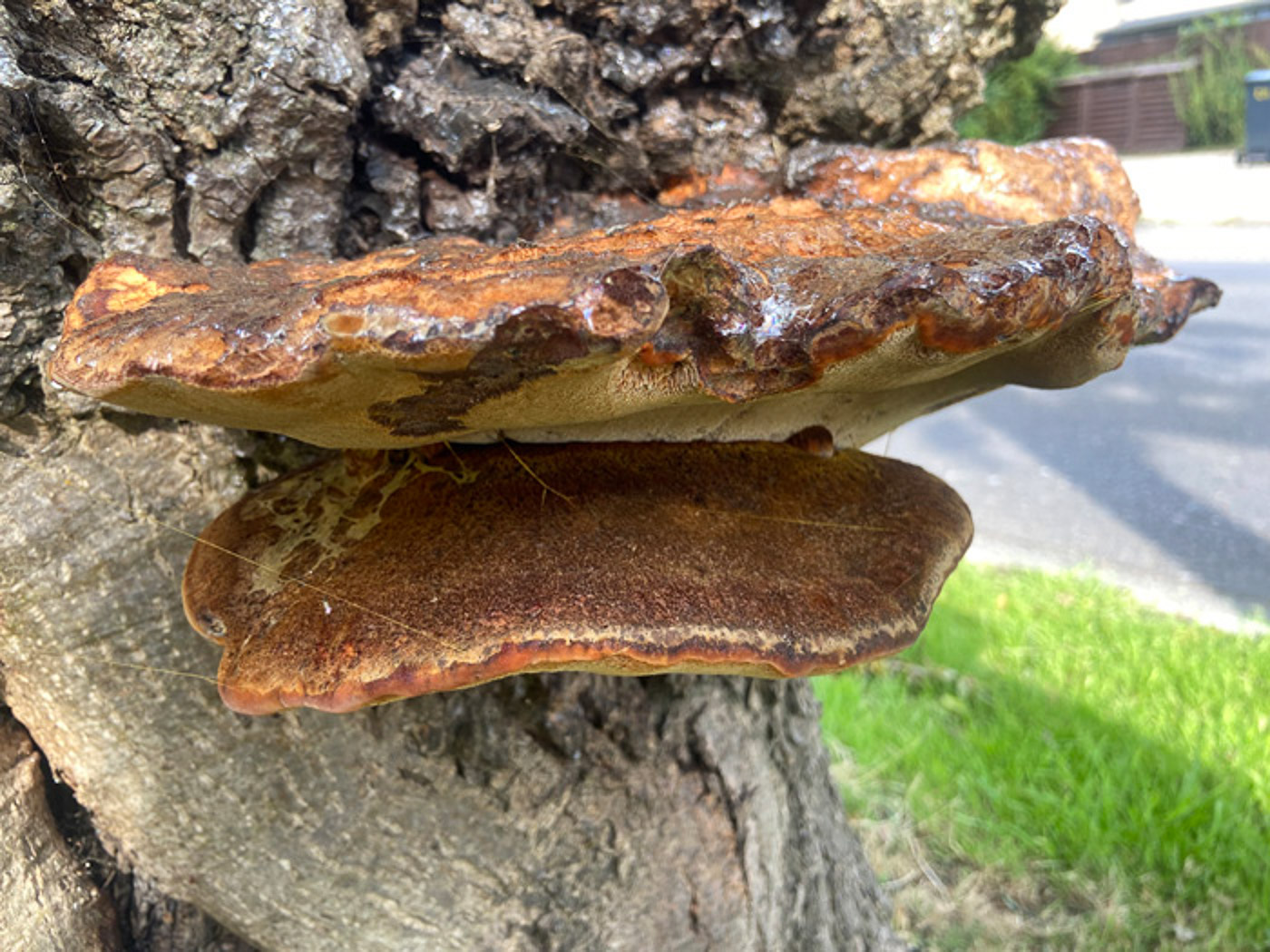
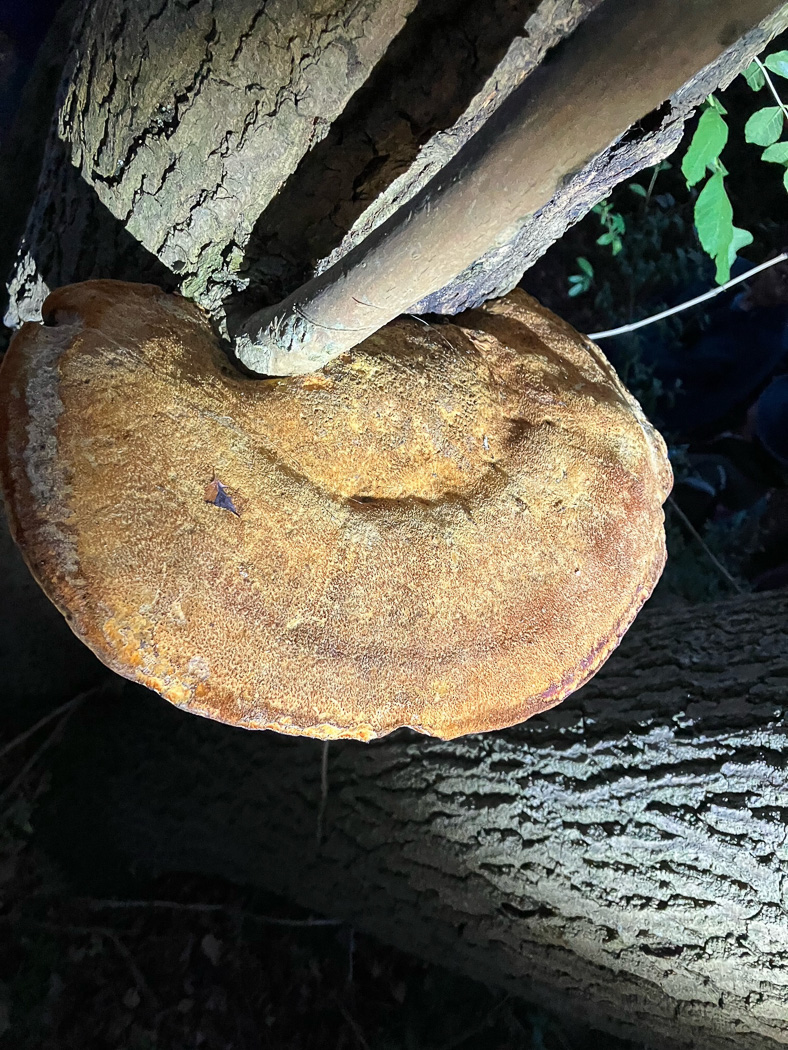
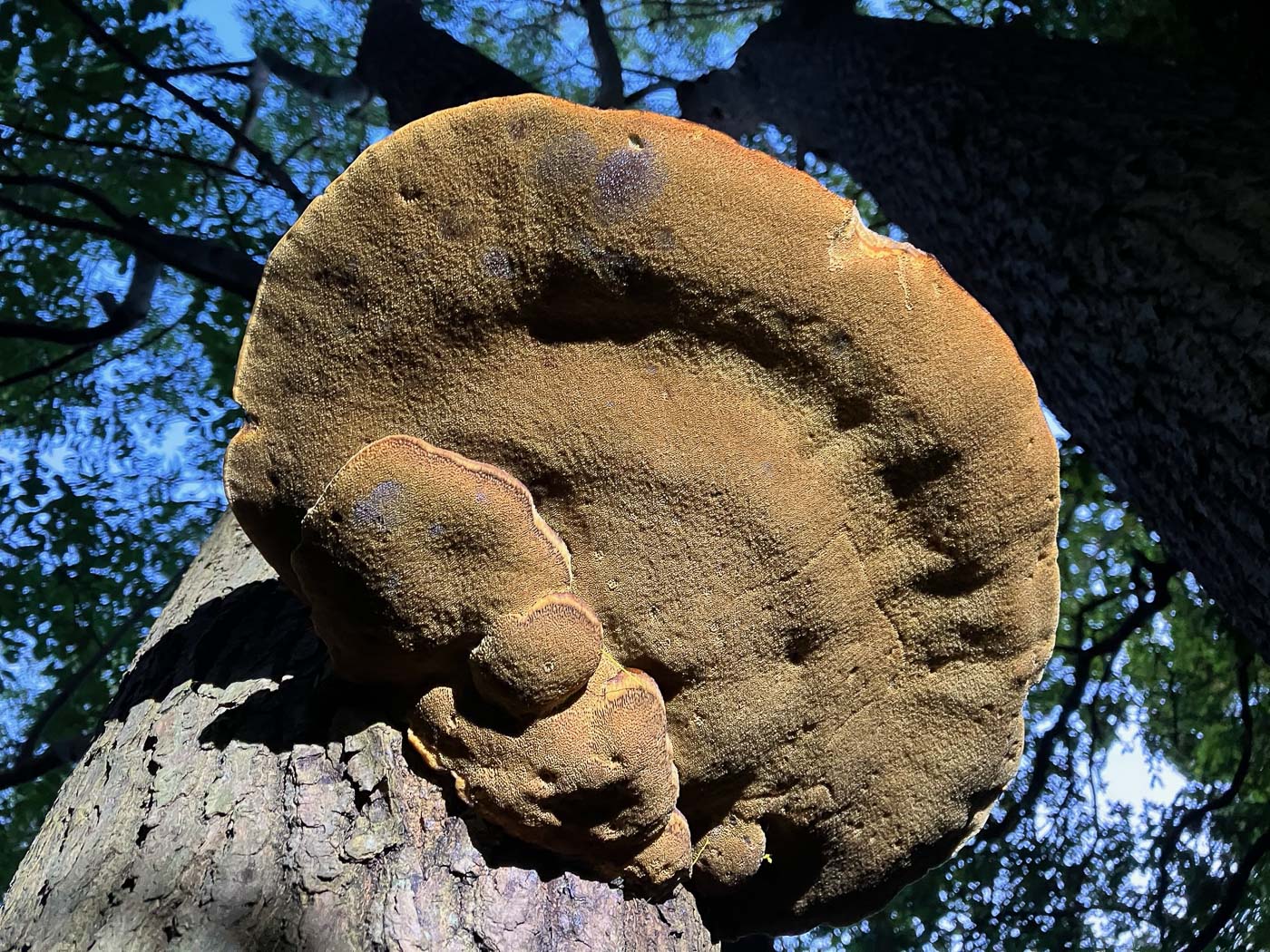 |
Inonotus hispidus (Shaggy Bracket)
Jun 30, 2023. In Widmer End Sarah Ebdon spotted this fresh and brightly coloured bracket on Ash as she drove past a couple of days earlier, then returned today for a closer look, to take some photos and make her identification. This is a soft furry species when fresh as here and is quite common on Ash. Sarah noted that the pores bruised dark brown when pressed and the upper surface bruised reddish brown. Photos 4 and 5 are of this same example taken by Sarah 5 days later, then again two weeks after that.
Aug 30, 2022. In Elfield Park near Milton Keynes Justin Long found this quite common bracket on standing Ash. Surprisingly this seems to be a first for Finds though we have many records - it's one which favours Ash and also Apple, is often high up on living trunks and when young as here has a finely hairy surface. We most commonly find it old and blackened lying on the ground.
|
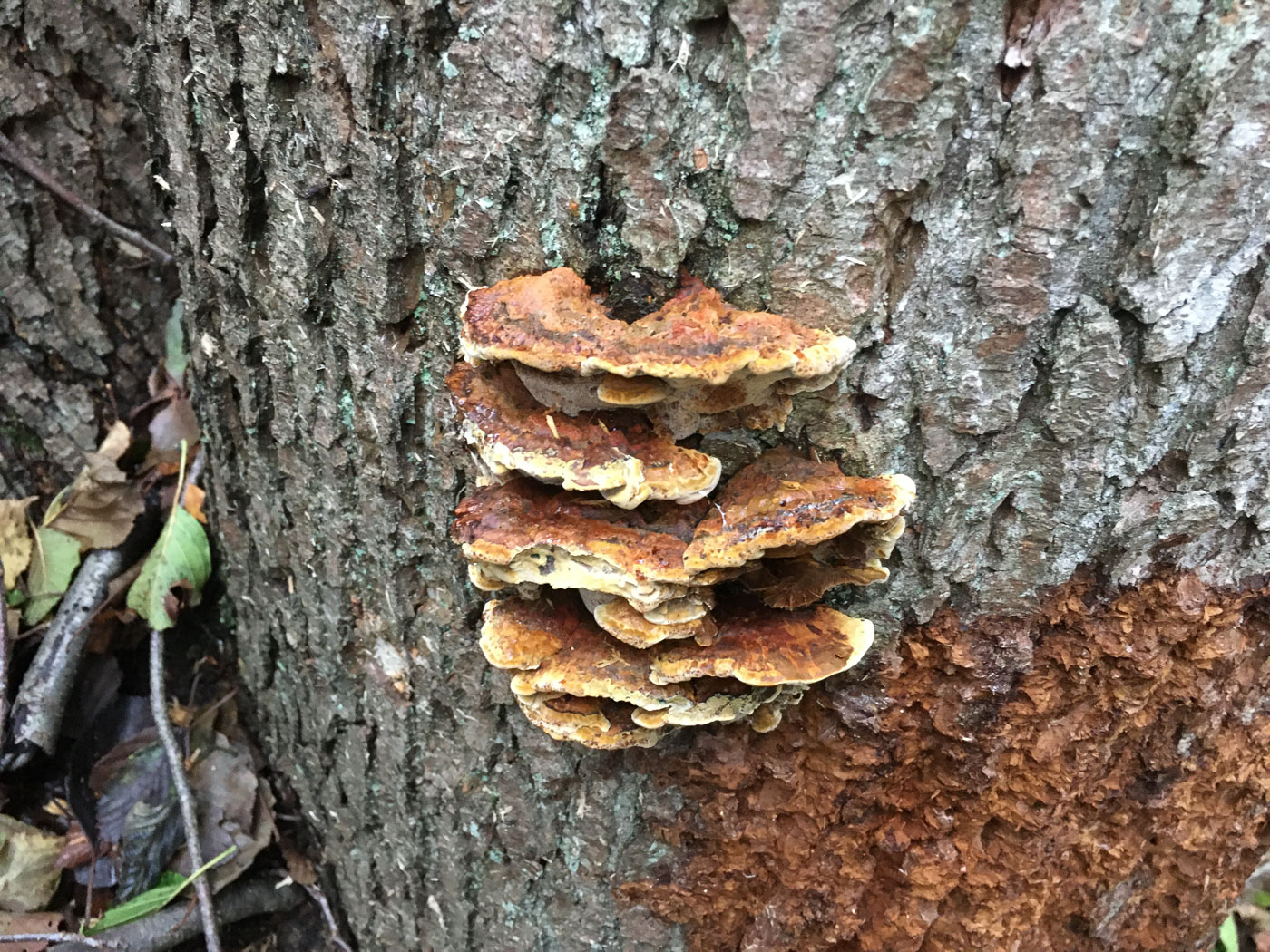
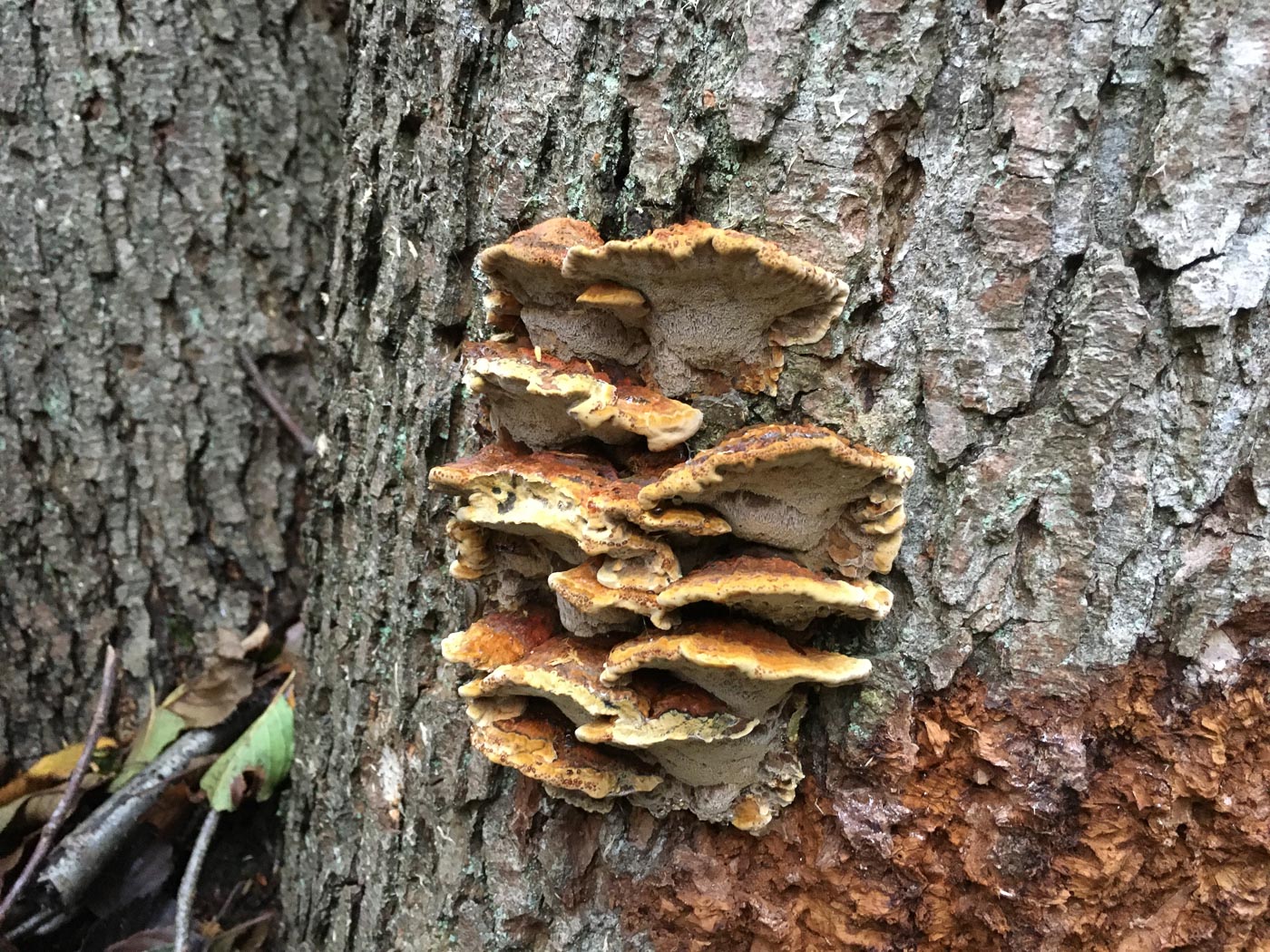 |
Inonotus radiatus (= Mensularia radiata) (Alder Bracket) 
Nov 2, 2020. Russell Ness noticed this tier of brackets on a standing Alder trunk in Egypt Woods, Burnham Beeches. Seldom recorded possibly due to the lack of Alder in many of our regular foray sites, it is apparently commonest on this host but not exclusively so and can be found on a range of other deciduous trees. Russell took the trouble to check with a scope for the hooked setae (brown pointed hairs) found within the context - these are a sure way to separate the species form several other lookalikes. We have just a couple of other county sites for the species.
|
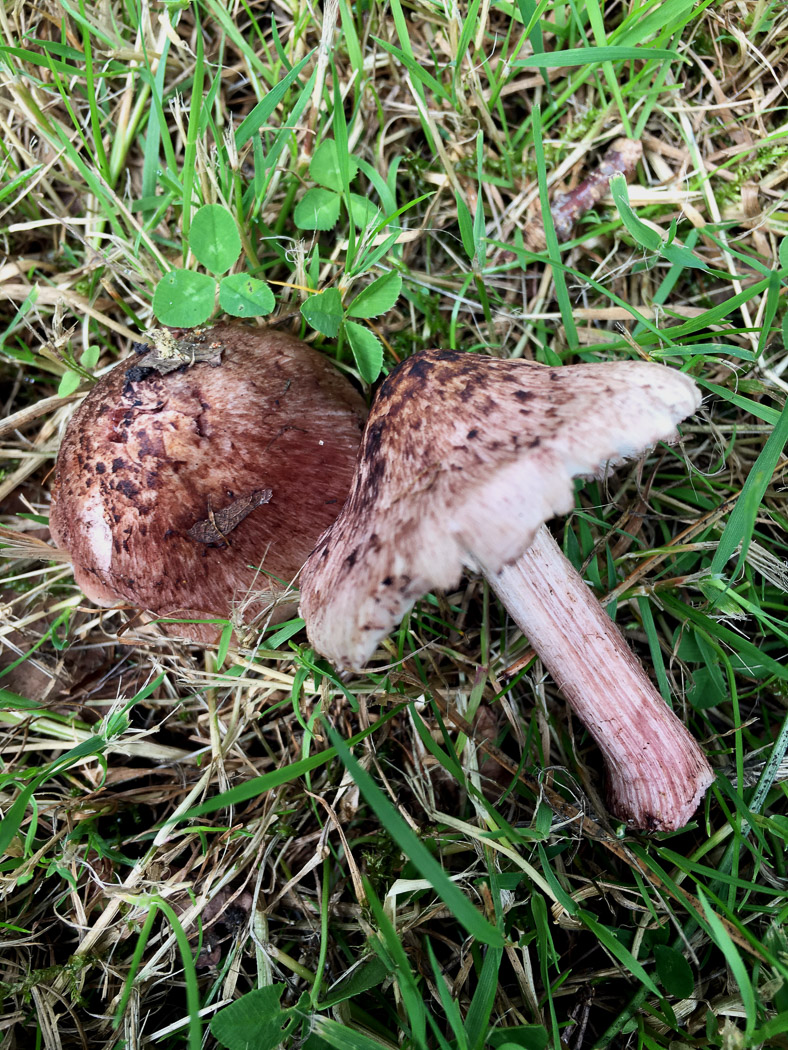 |
Inosperma adaequatum (previously Inocybe adaequata - a species of Fibrecap with no common name) 
Jul 13, 2021. In Wotton Park Estate under mixed deciduous trees Joanna Dodsworth found this pair of Fibrecaps, an unusual though not really rare species for which we have just six records from three different sites. The genus Inocybe - a large one recently divided into four for UK species (more worldwide) - is one which almost always needs a scope to identify to species, but this particular member is recognisable in the field from its scaly cap surface and tendency to turn pinkish red, particularly on the rather fibrillose stem (visible in the photo). It also has an unusual smell: somewhat spermatic (as in many Fibrecaps) but with an earthy beetroot component. It can get quite big for this group of LBJs, up to 7-8 cms across.
|
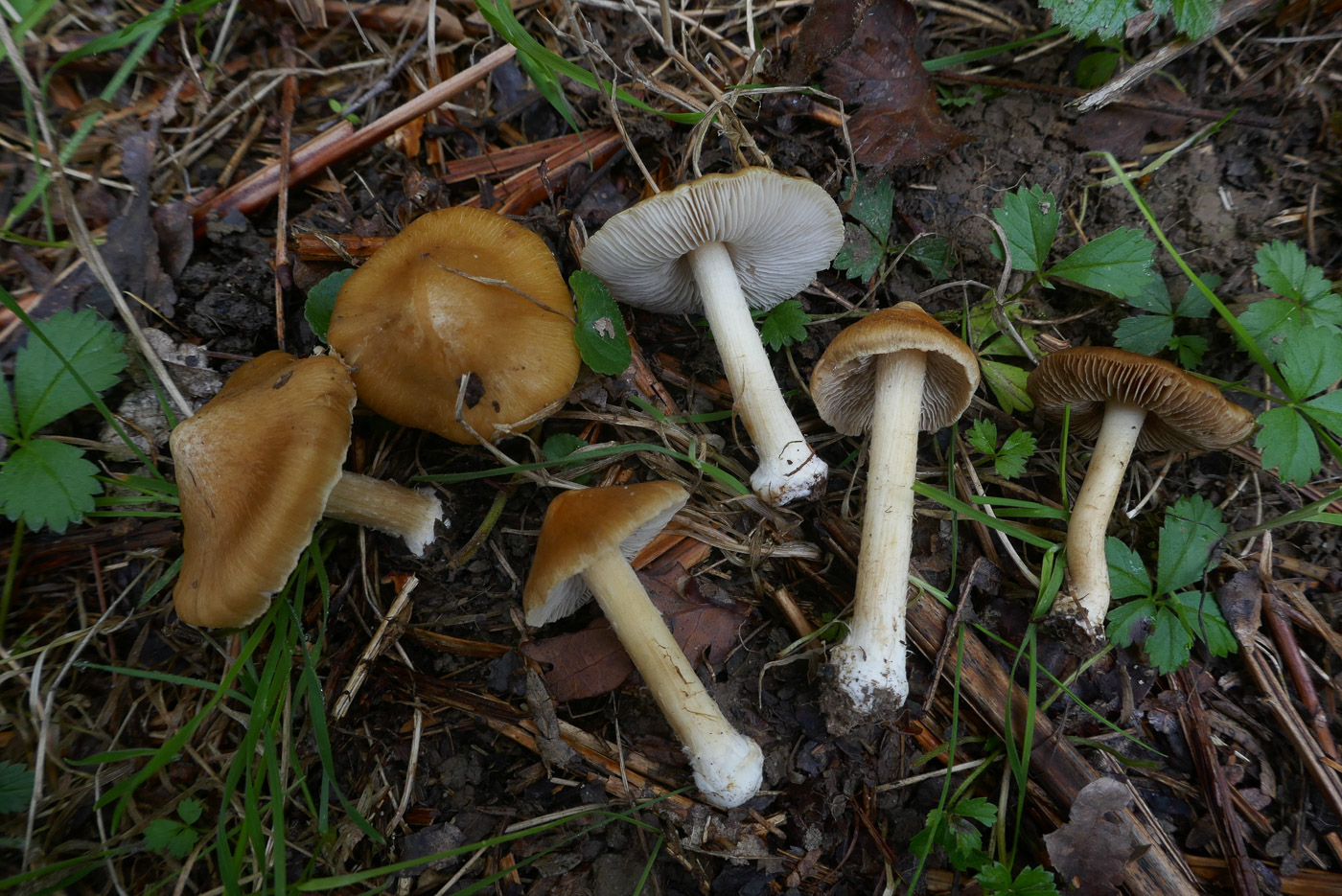 |
Inosperma cookei (Straw Fibrecap) 
Sep 29, 2022. At Stampwell Farm in a woodland path under Oak and Birch Jackie Ewan found this group of mushrooms, thought they were Fibrecaps from the general shape and texture, the beige gill colour and the bulbous stem base, then took them home to identify. As Fibrecaps go, this is quite an individual looking species and also has an interesting smell (though it takes experience to recognise it). Many Fibrecaps have an acidic spermatic smell, but this species has a slightly bitter honey component to it. Once detected, it is then quite easy to check the microscopic features to confirm your ID. The species is relatively common and was previously in genus Inocybe. We have one previous entry: 2020 September 7th (when the genus name was still Inocybe!).
|
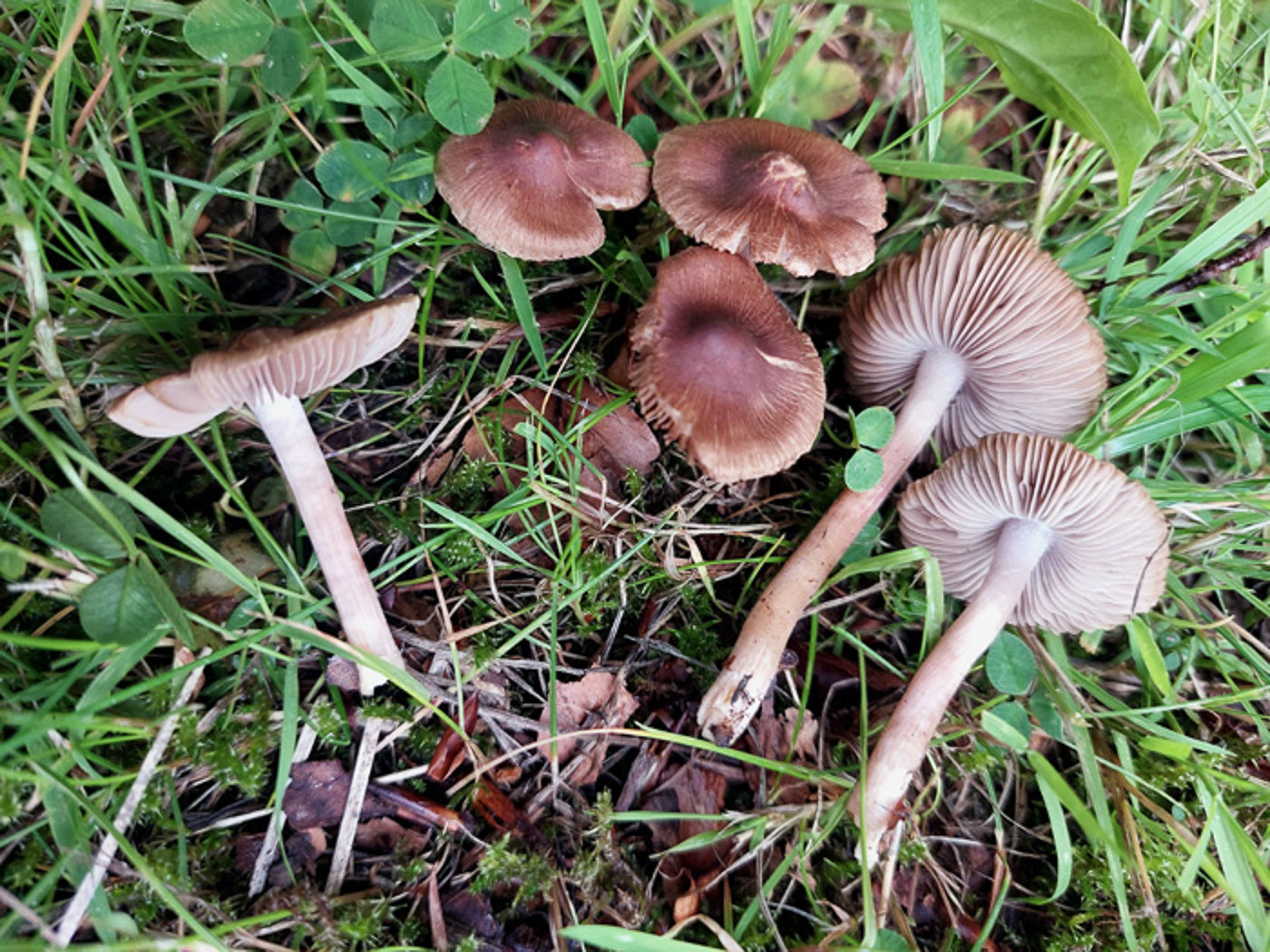
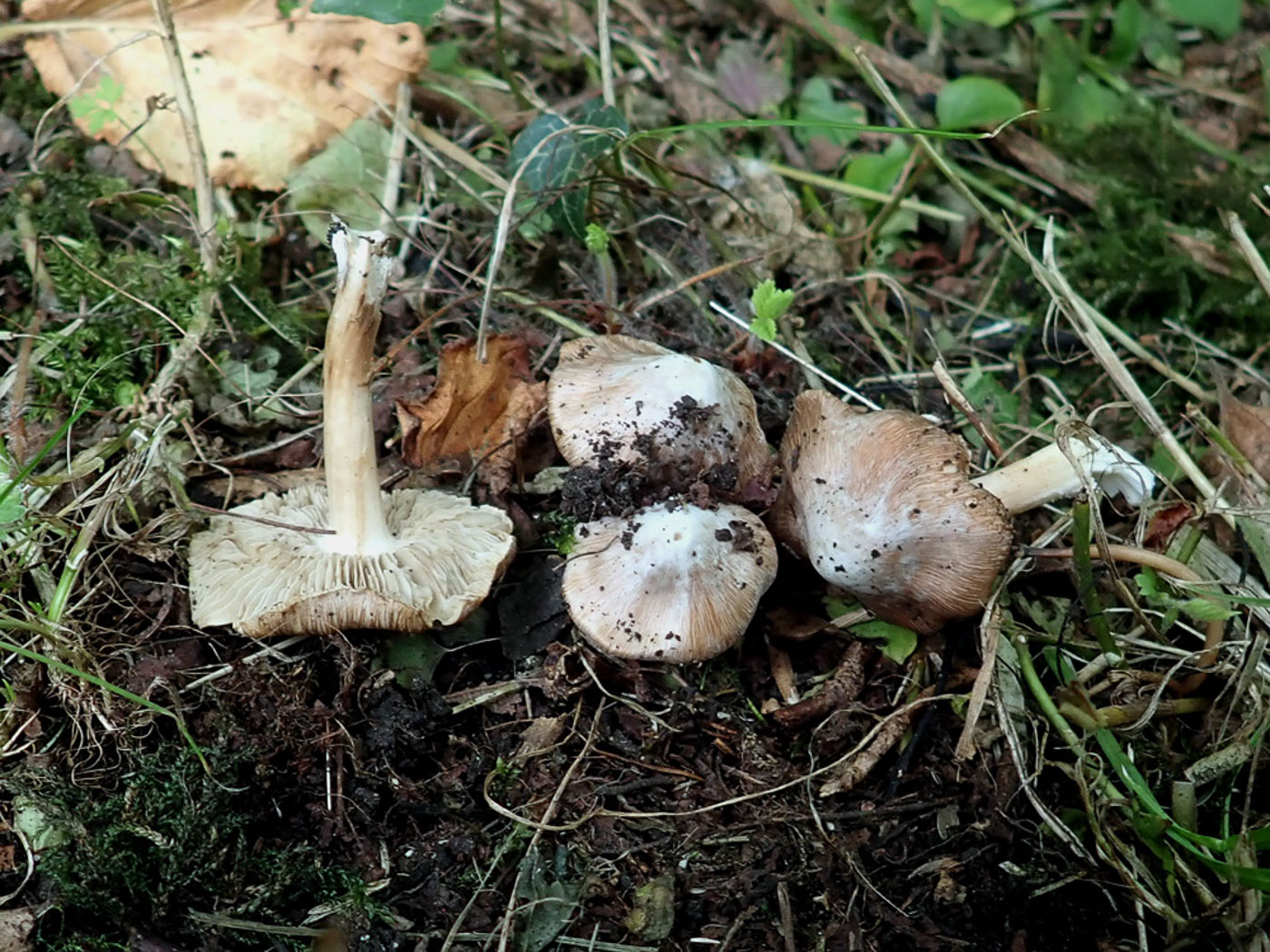
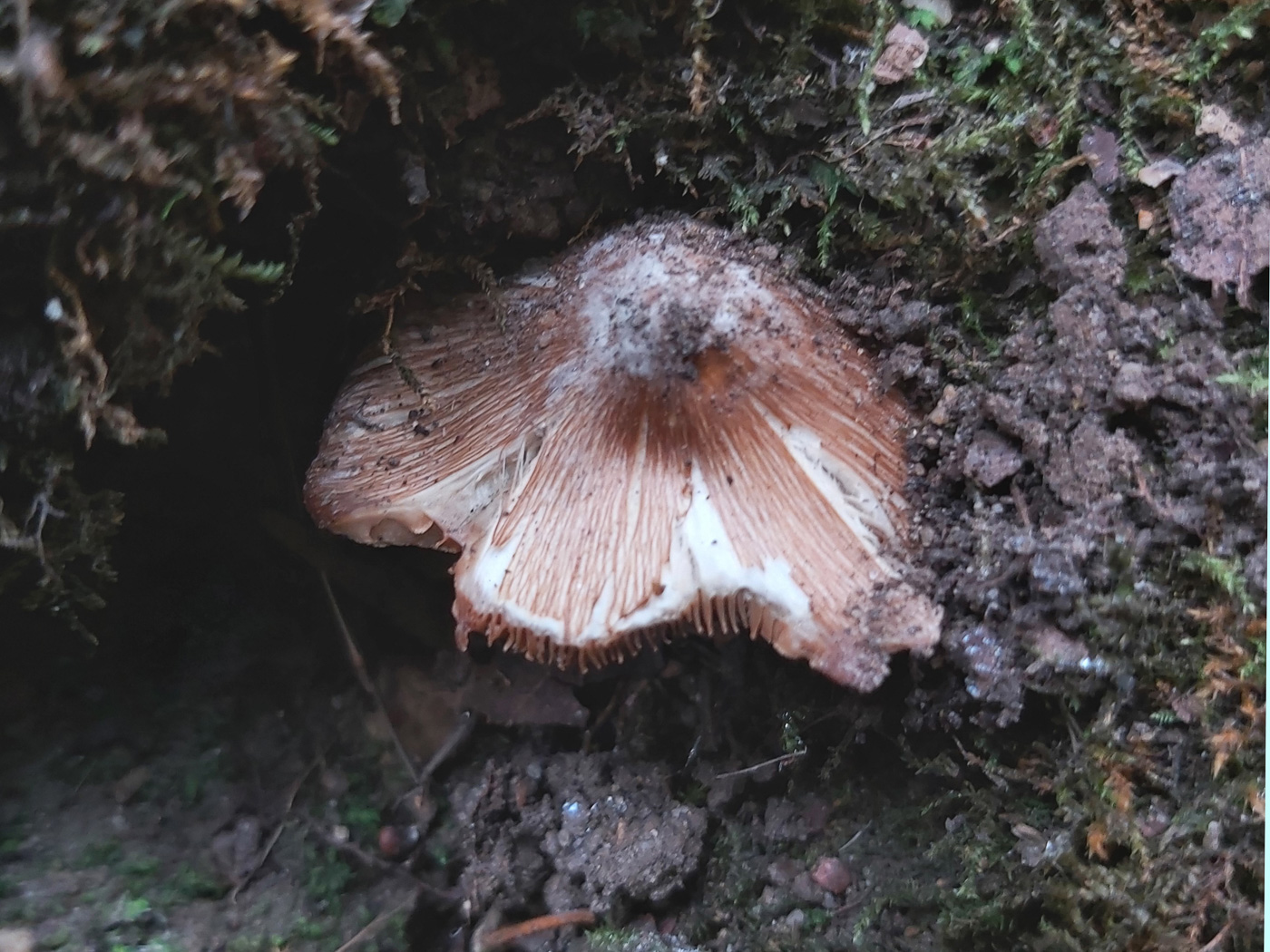
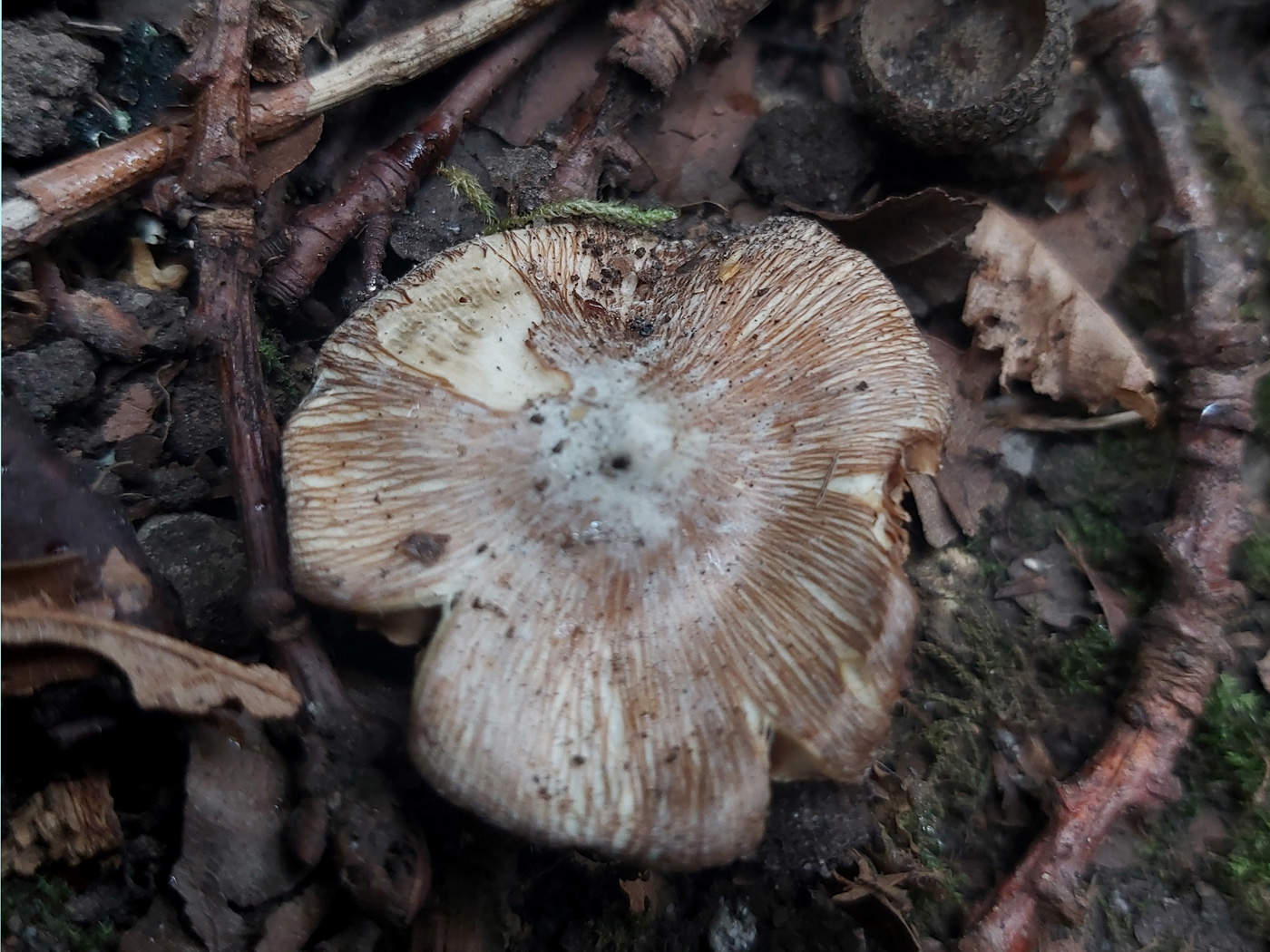 |
Inosperma maculatum (Frosty Fibrecap) 
Aug 8, 2023. In Jordans under Oak Jesper Launder made this collection of Fibrecaps to take to our microscope workshop the next day where Penny and he keyed it out. Previously in genus Inocybe, it is similar to many other Fibrecaps having a rich brown smooth cap with an umbo (in this species quite prominent) and a 'spermatic' smell. Often it can only safely be named through micro-characters which luckily are quite distinctive, though when young it can be distinctively conical and often has a white veil covering the central zone (hence its common name) but after rain this can get washed off as here! Photo 2, however, shows a more typical collection - from Rushbeds Wood made 10 days later by Penny - with both veil and conical shape in evidence. This is one of our commoner Fibrecaps.
Jul 28, 2021. In Jordans village in soil under Oak Jesper Launder spotted this pair of typical LBJs just pushing up and still with the diagnostic white 'veil' of the species covering the cap centre. Like many Fibrecaps it has a brown rather split cap revealing the white flesh beneath, the species name 'maculata' meaning spotted and referring to the veil which is often present though can be washed off by rain. This large mycorrhizal genus has recently been split into four (as with the Inkcaps) and nearly all species need a microscope to identify with any certainty.
|

